La Nébuleuse
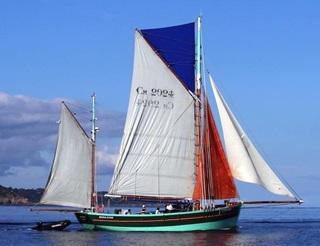
Crossing the Atlantic on la Nébuleuse. Departure from Paimpol on December 1, 2024. Arrival in Salvador, Brazil around mid-January 2025.
Where is la Nébuleuse https://www.vesselfinder.com/fr/?mmsi=228280600
The weather Windguru
Website of the Nébuleuse https://www.voilestraditions.fr/bateaux/la-nebuleuse
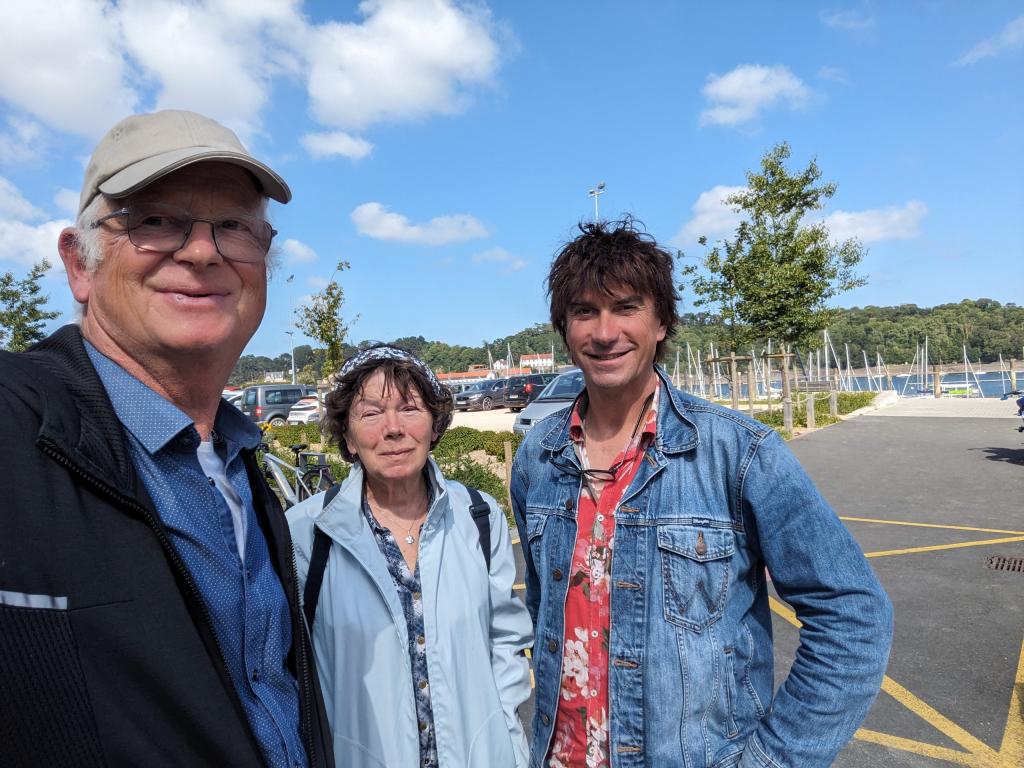
June 9, 2024 with Cédric Lagrifoul, captain of La Nébuleuse
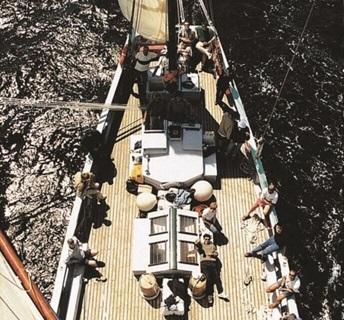
Article by Annick Guillemot published on July 23, 2024 by La Presse d’Armor
At the port of Paimpol, La Nébuleuse is preparing for an extraordinary journey. Having just completed six months of construction, the traditional sailboat La Nébuleuse, anchored for 25 years in the port of Paimpol (Côtes-d'Armor), is preparing for a double transatlantic voyage.
At 75 years old, La Nébuleuse, a former tuna boat from Camaret, which has become the flagship sailboat of Voiles et Traditions in Paimpol (Côtes-d'Armor), will set sail in December for a double transatlantic crossing which will last three and a half months.
After a six-month restoration project at the port of Paimpol (Côtes-d’Armor), the traditional sailboat Nébuleuse returned to sea at the end of May. In a few months, he will leave on an extraordinary journey to the other side of the Atlantic. Heading for Brazil!
Since its relaunch, the flagship of the passenger transport company Voiles et Traditions has been sailing for the day in the archipelago or for small and medium cruises: three weeks between Ireland and Scotland in heart of summer, a tour of the Breton islands at the end of August. In mid-July, the boat took part in the major maritime festivals of Brest and Douarnenez.
But the big journey announced, never yet carried out, will be the double transatlantic planned for the end of the year. Heading for Brazil. An extraordinary cruise for the old Paimpolais rig of Cédric Lagrifoul, its owner: three and a half months of sailing between December 2024 and March 2025.
The offshore vessel is approved for all seas in the world and has proven its seaworthiness when fishing in the North Atlantic during the heavy depression season. Its 30 tonnes of lead out of its 92 tonnes of total weight ensure great stability.
The “transat” adventure is, however, a first for the 75-year-old ship, which could have continued to live its quiet little life as an old rig sailing in familiar waters.
The idea came from a meeting between the boss of La Nébuleuse and a cocoa planter in Brazil looking for a “low-carbon mode of transport for his production sold in France”. Unfortunately, the producer did not follow up, but Cédric Lagrifoul continued his project to associate with the DNA of the ship – sailing for passengers – the freight activity for a journey to distant seas. “It is not the vocation of the boat to only transport goods. »
Within Voiles et Traditions, we all love people, what we love is sharing sailing and life on board. Such a trip is more economically feasible with freight. The boat which will carry a maximum of twelve passengers (and “there are only five places left,” warns the captain) is therefore “actively looking for partners. We can load 10 tonnes of freight in the holds, both on the outward and return journey. »
Why not take wine on a journey? Cocoa, coffee or why not wine? “This could be freight that remains on board, like the Bordeaux Retour des Indes of yesteryear,” smiles Cédric Lagrifoul. In the 19th century, taking wine on a journey was a fashion launched in the Médoc by a vineyard owner. Returning from India with an unsold cargo, he noticed that it had improved after 20,000 km at sea. The voyage of the Nebula will therefore perhaps attract a few producers on one side or the other of the Atlantic, adding stops to his adventure which is actively being prepared.
If the boat is known to be efficient and fast (“it has several times equaled 12 knots without the current”), the progress of the journey was calculated on pessimistic forecasts, “below its normal average of 7 knots” , explains the sailor. A guarantee against unpleasant surprises and for risk-free navigation. “We will wait if necessary at the tip of Brittany, for example, so as not to be shaken in the Bay of Biscay. »
On board, the crew will be made up of three sailors from the company including Cédric Lagrifoul. Twelve passengers should embark at the beginning of December at the port of Paimpol.
Christmas and New Year's Day on board
On the way out, stopovers of 2 or 3 days are planned in Madeira, the Canaries and Cape Verde before passing the Ecuador. Christmas and New Year's Day will be celebrated on board, the champagne is already ready... Arrival in Brazil is set for January 15.
The ship has sophisticated means for the adventure that awaits it. Distress beacons, oxygen therapy equipment, means of satellite communication which will also allow the journey to be shared on the Voiles et Traditions networks. For now, preparation continues: “We continue to improve the boat, we are planning hydro-generators to produce electricity when we are under sail, a small gantry to install the boom and put up a sail. cap…”
Everyone participates in collective life
On board, the adventure will also be human and collective. The passengers will completely share the maneuvering of the sails, the watches… “That’s what people are looking for, the ship and the atmosphere are endearing because there is not a saloon for the crew on one side , and the passengers on the other. Everyone participates in collective life but without total promiscuity. » The interior of the old tuna boat has kept its old berths, a sort of Breton-style closed bed with shutter or curtain.
We are not in the sleeper train but neither in the cabins of a Costa... Between stopovers, life on board will be occupied by observing the plankton, taking temperature readings, maneuvering the sails, learning astronomical navigation, etc. Among the passengers already registered for this unforgettable cruise, “half already know the ship and have sailed on it”. The Nebula causes an addiction phenomenon. The atmosphere on board, the comfort and stability of the ship play a big role, as does what the crew imprints on the collective.
At Voiles et Traditions, slips the boss, “we are all on the same wavelength, the success of a sea trip aboard La Nébuleuse is collective, in sharing, it’s the same thing for a company , everyone has their position. » For the day, for a few weeks or for three months at sea, the journey is “an exciting discovery each time with different passengers, places, situations. We are always trying to make the best of all situations, in the connection with those we welcome. »
If lasting contacts are established for sailing freight, the double transatlantic could be renewed. “That was the initial plan, to make the trip every year with cocoa freight. It will depend on demand and passengers,” says Cédric Lagrifoul. The captain would be offered another maritime dream: reach the Marquesas in the footsteps of Jacques Brel...

Avec Laurent et Ophélie équipiers de La Nébuleuse au Ker Breizh à Nantes le 26 nov
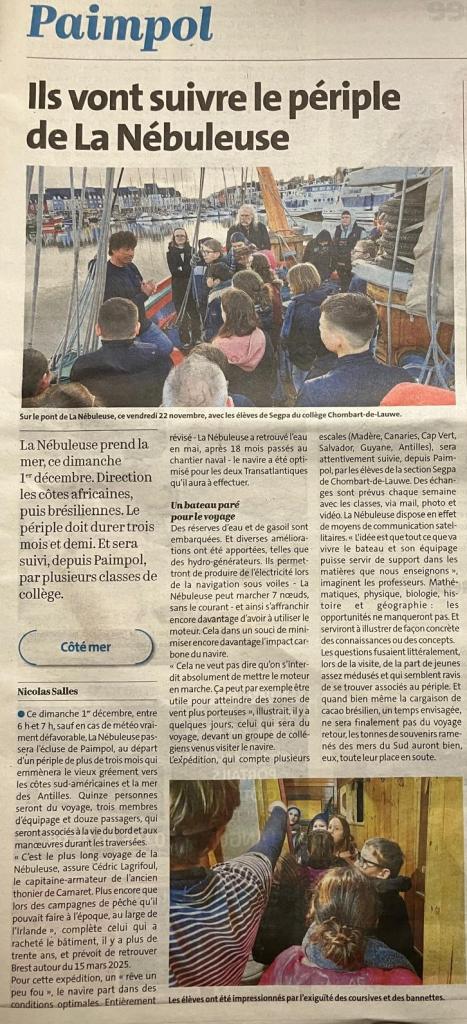
Télégramme du 28 novembre 2024
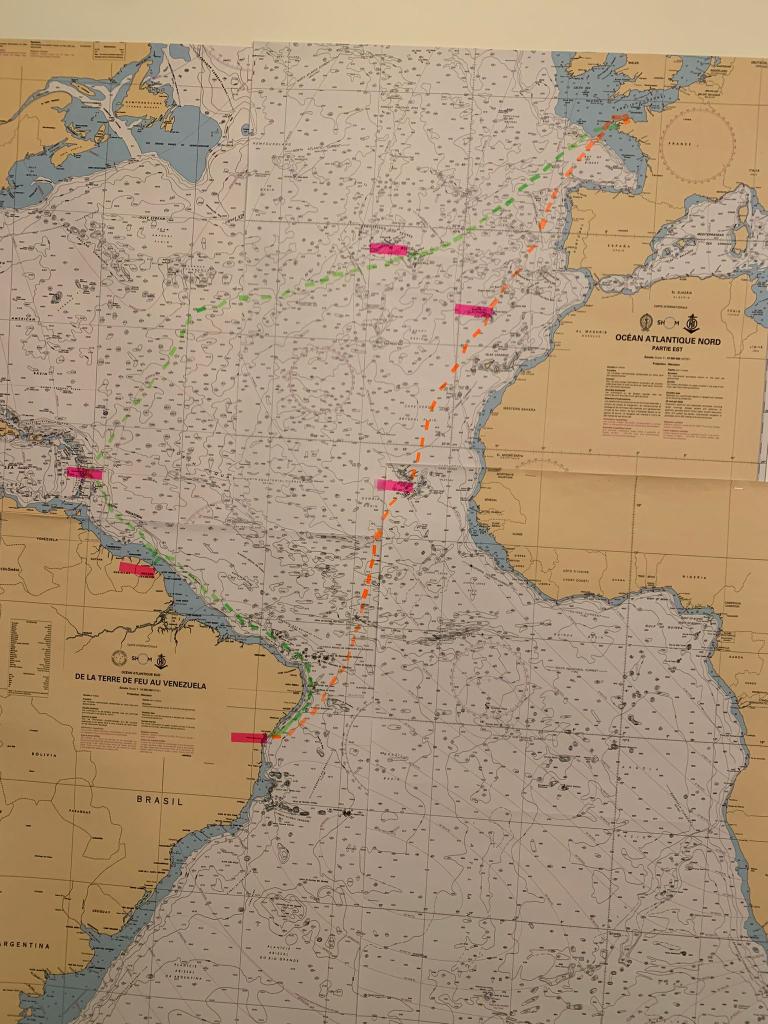
En orangé, le parcours aller avec escale à Madère et au Cap-Vert
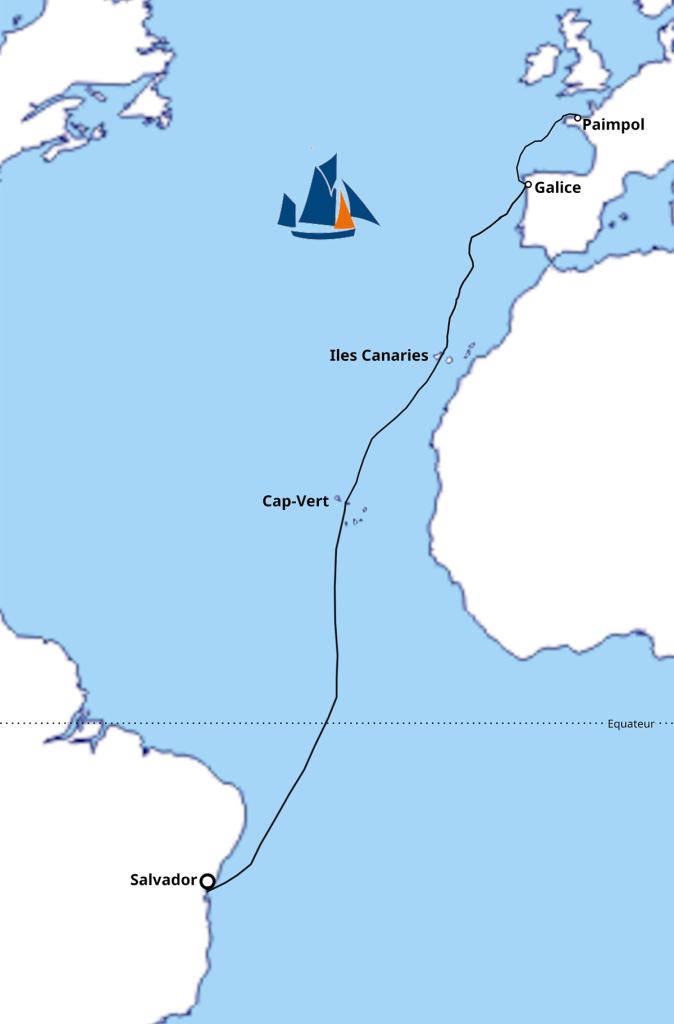
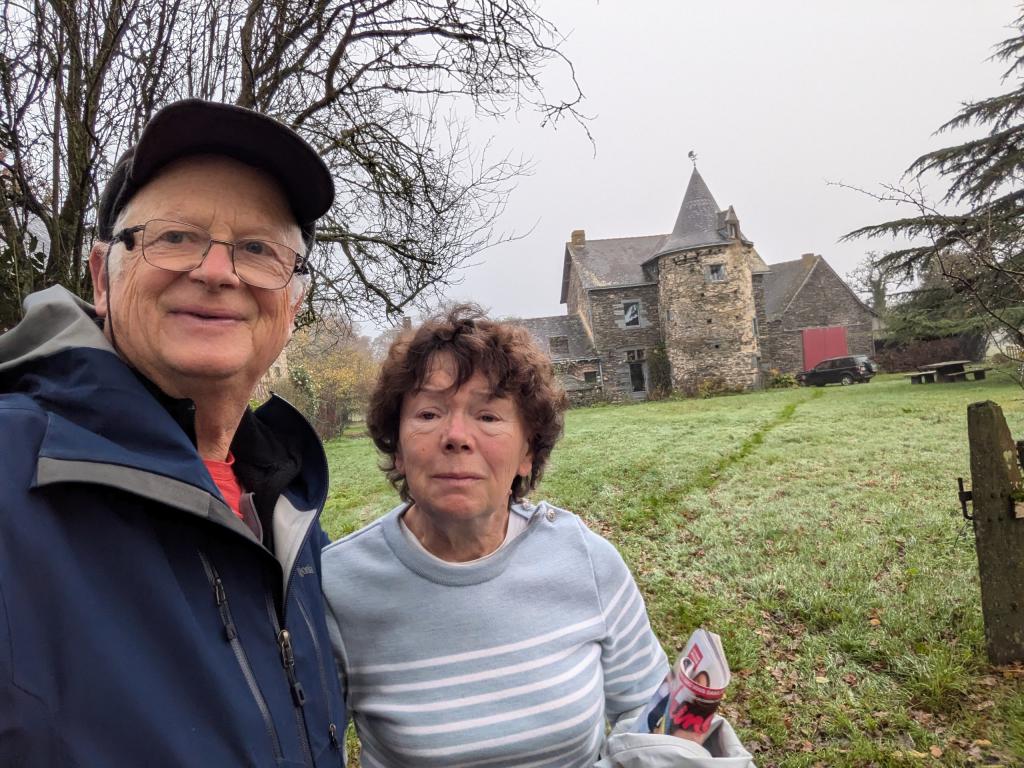
C'est parti ! pour le tour du monde
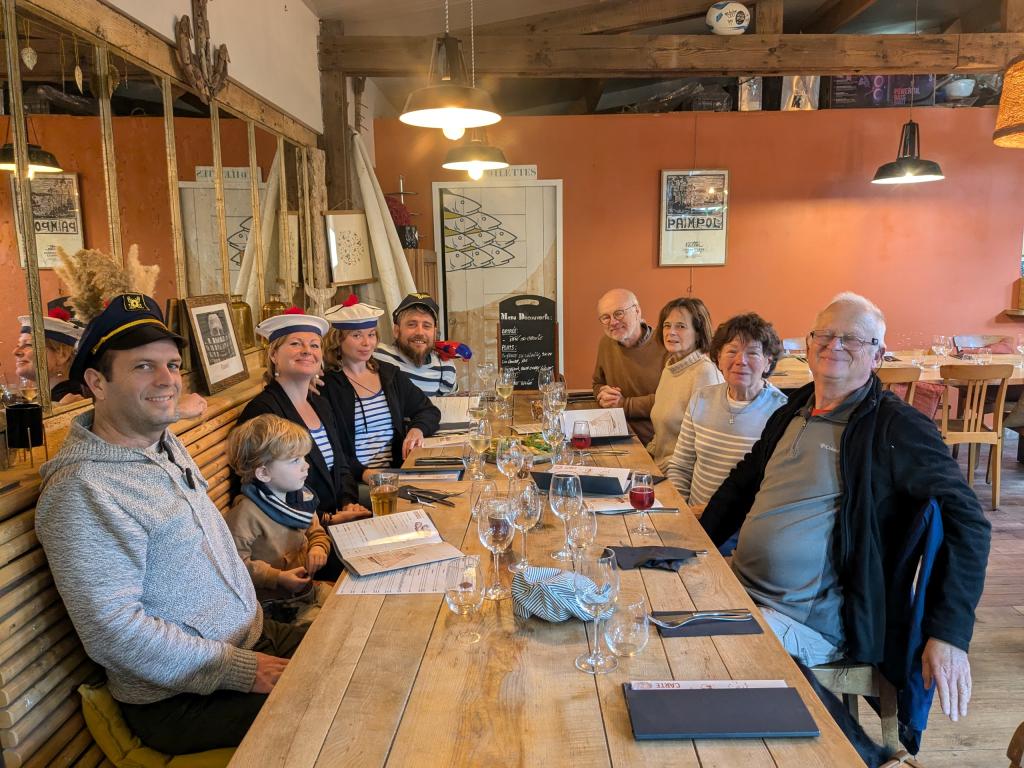
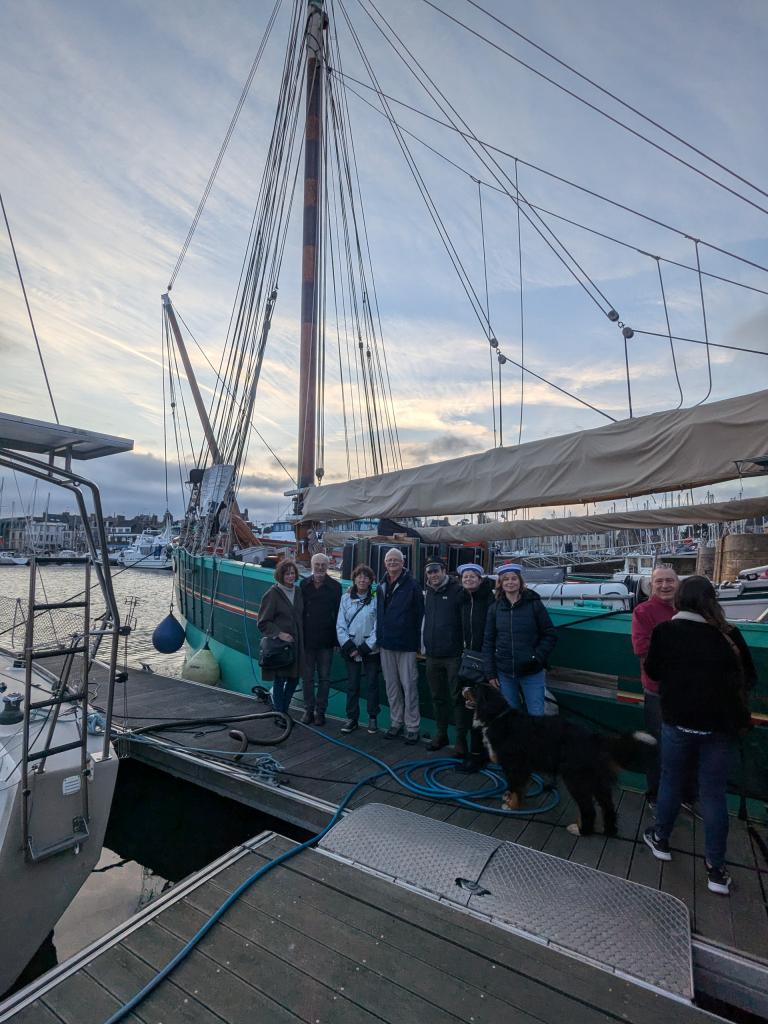
En famille devant la Nébuleuse avant de grand départ
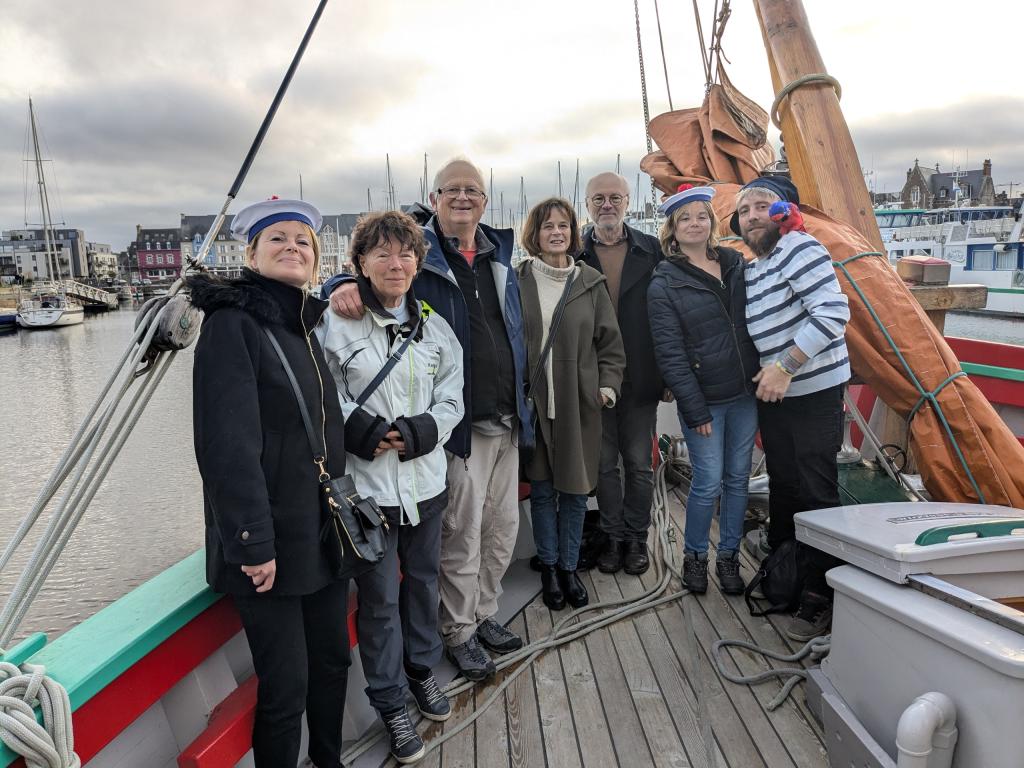
Embarquement sur La Nébuleuse à Paimpol
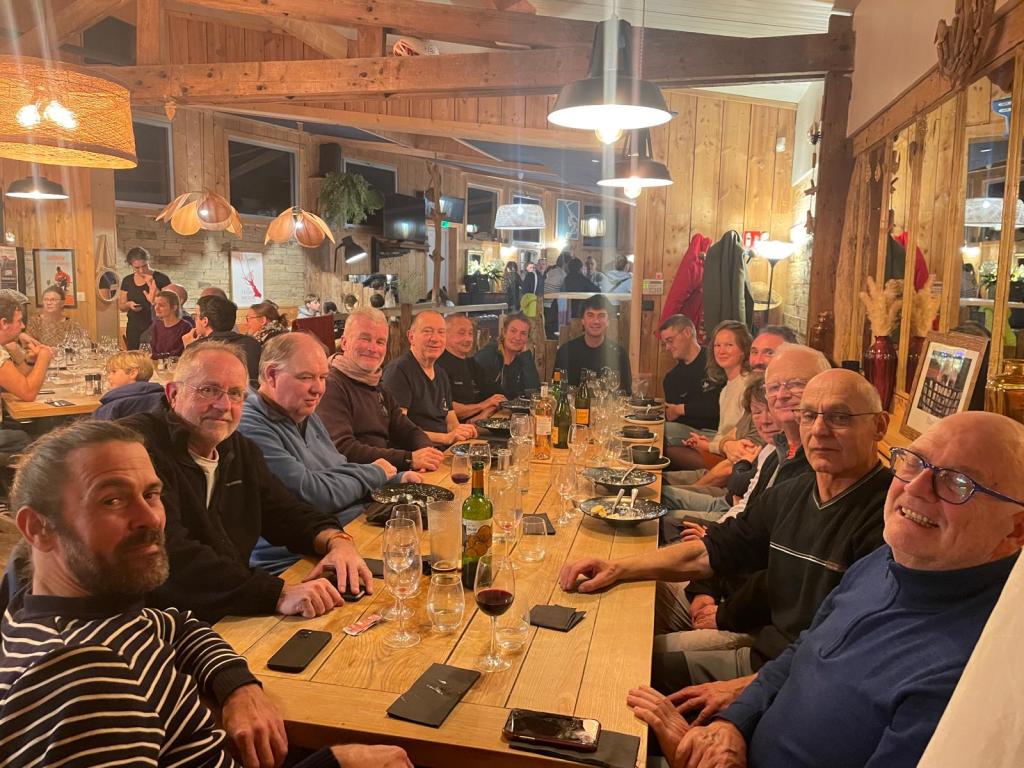
Briefing avant le départ
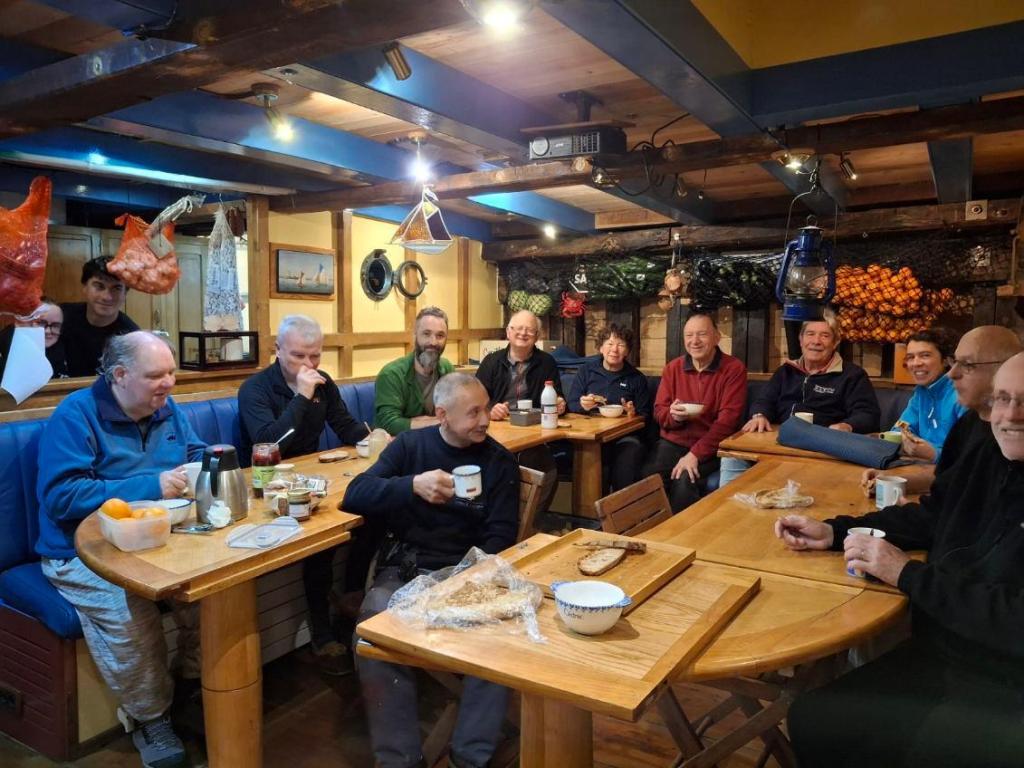
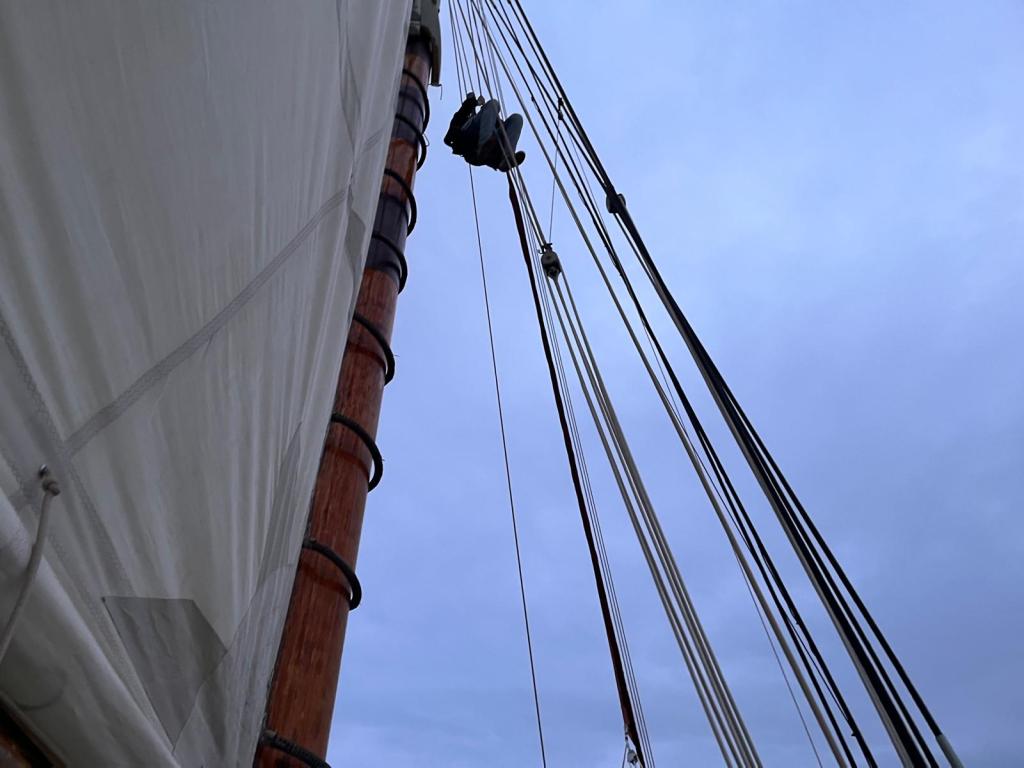
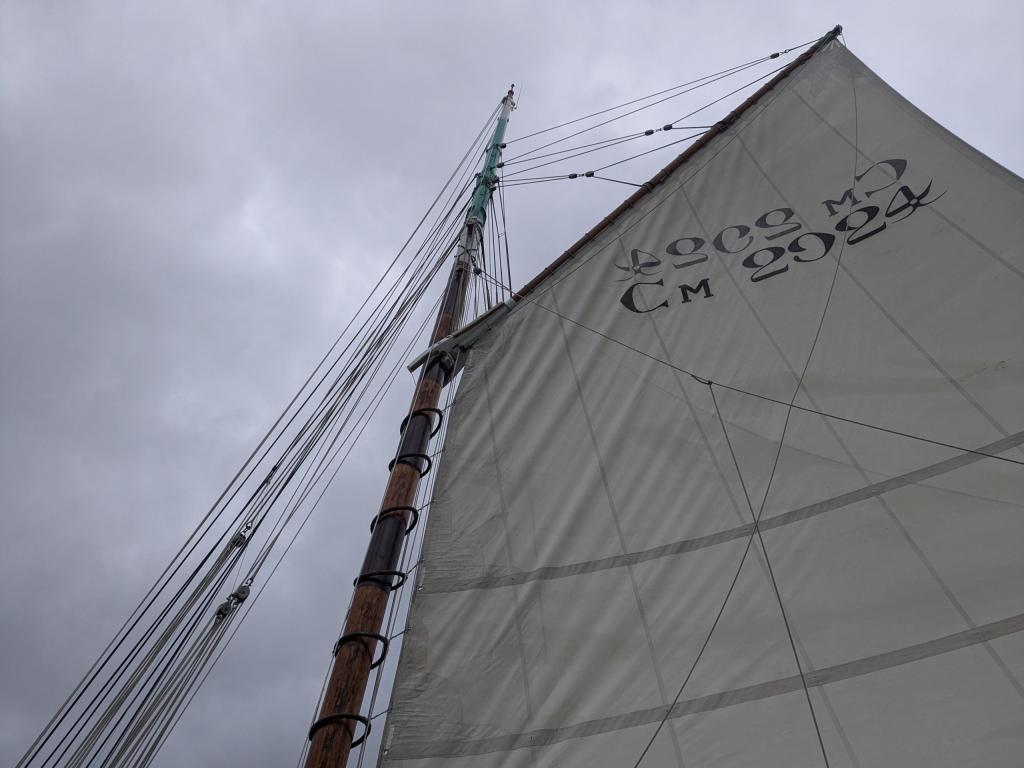
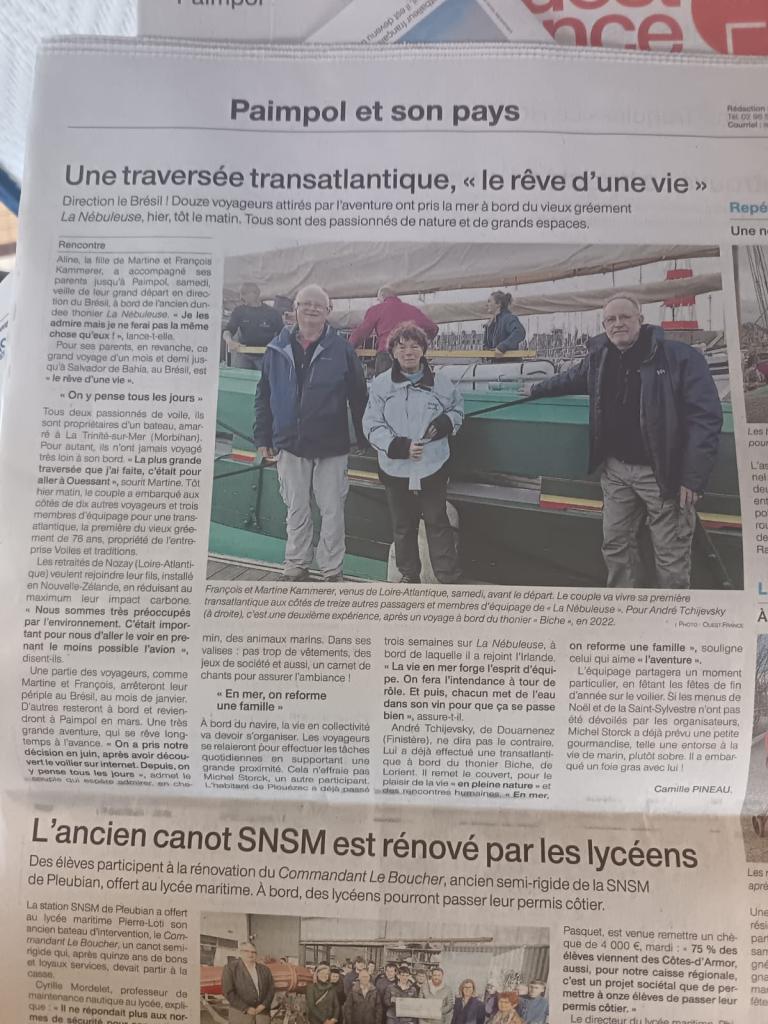
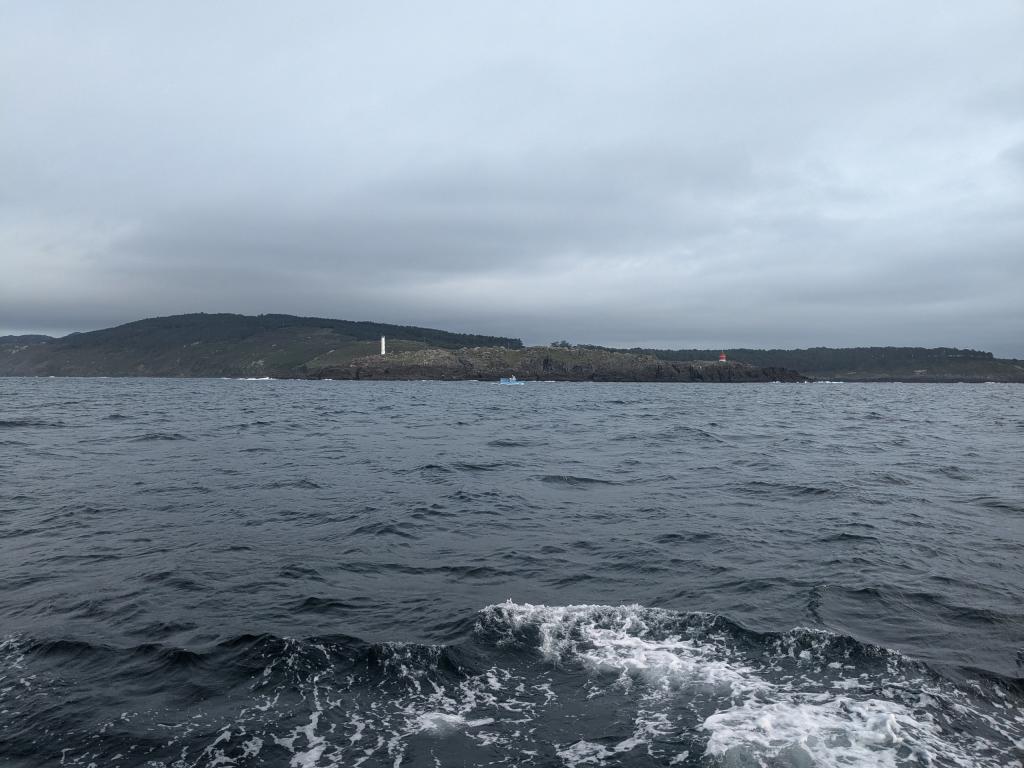
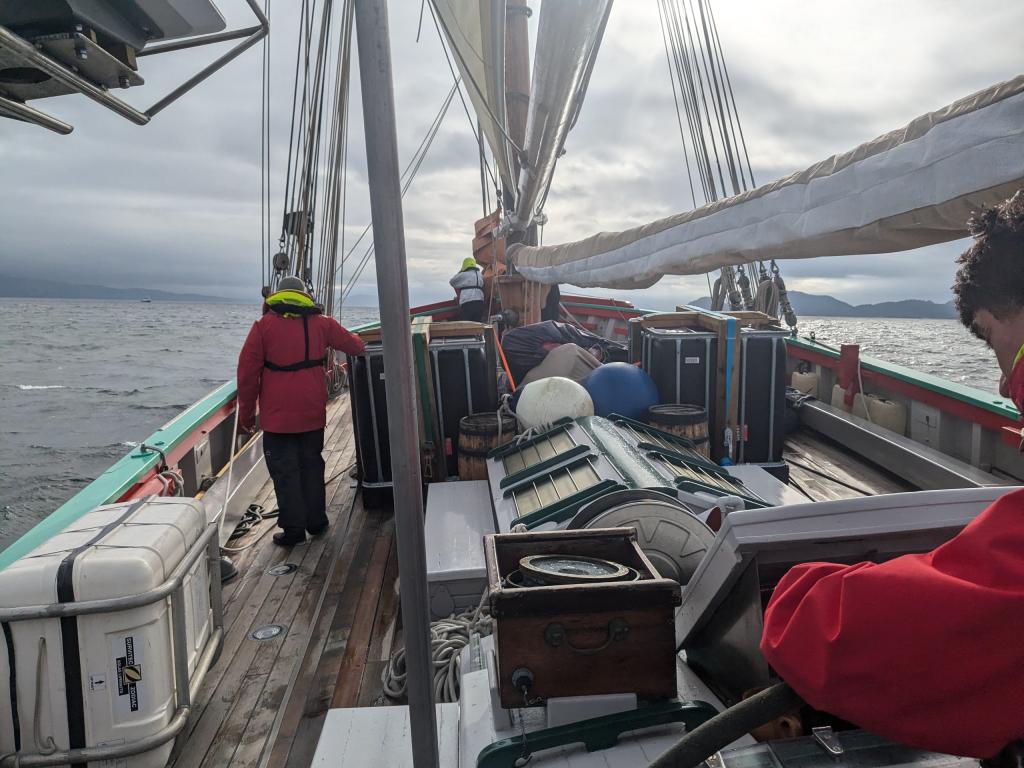
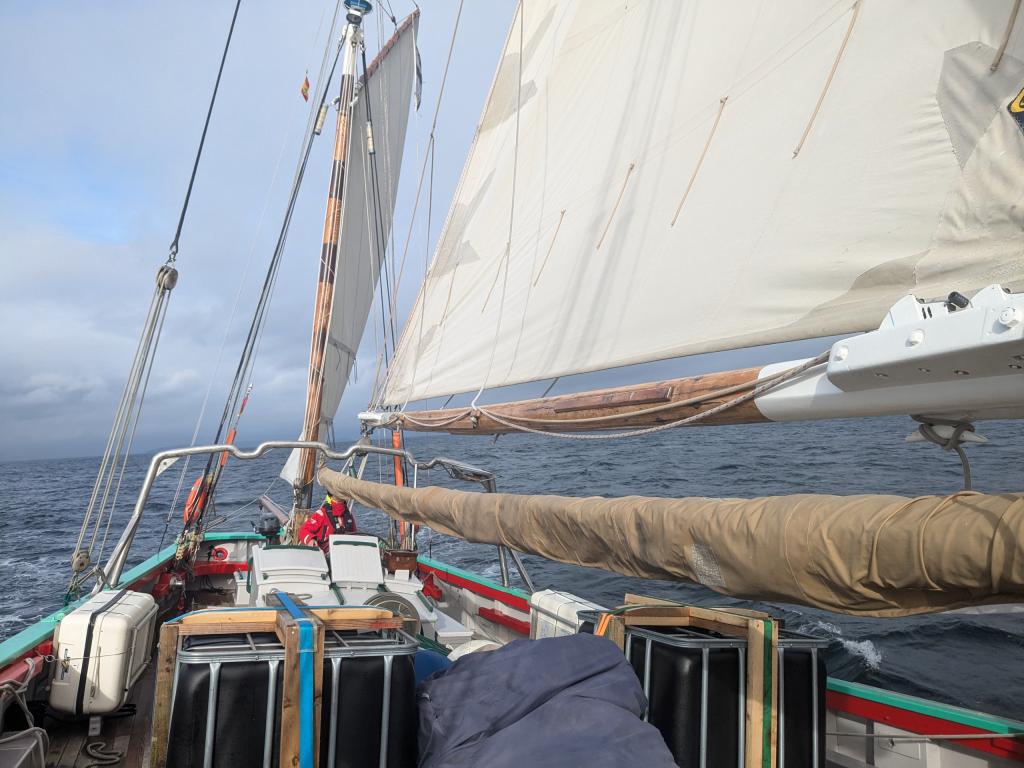
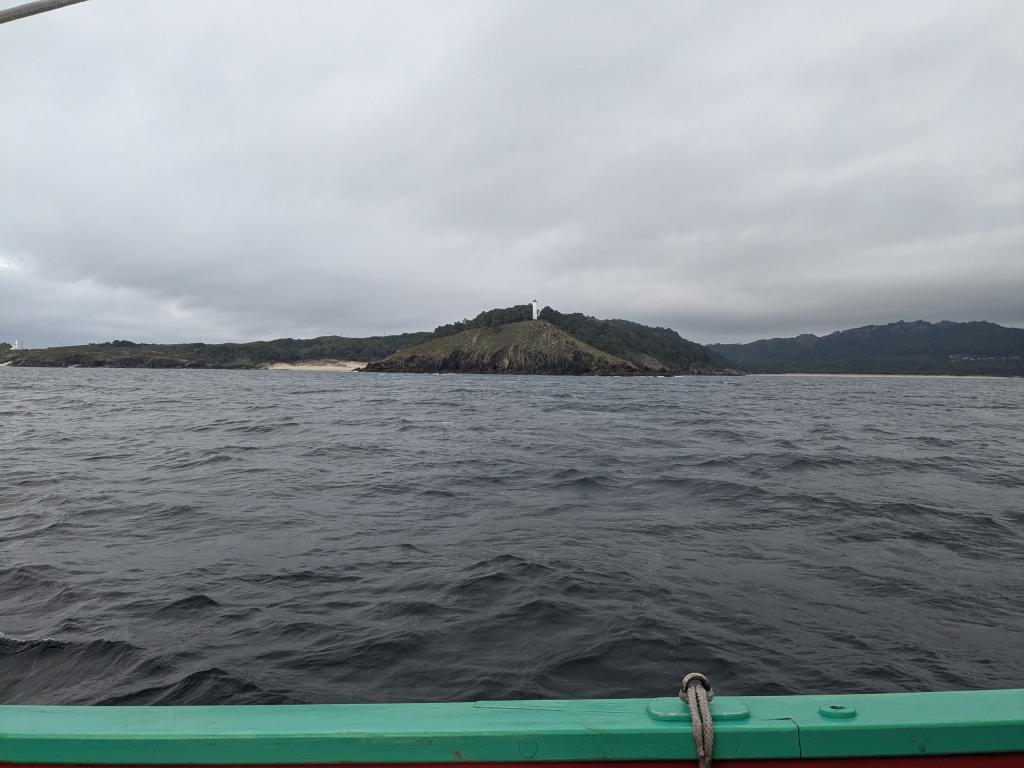
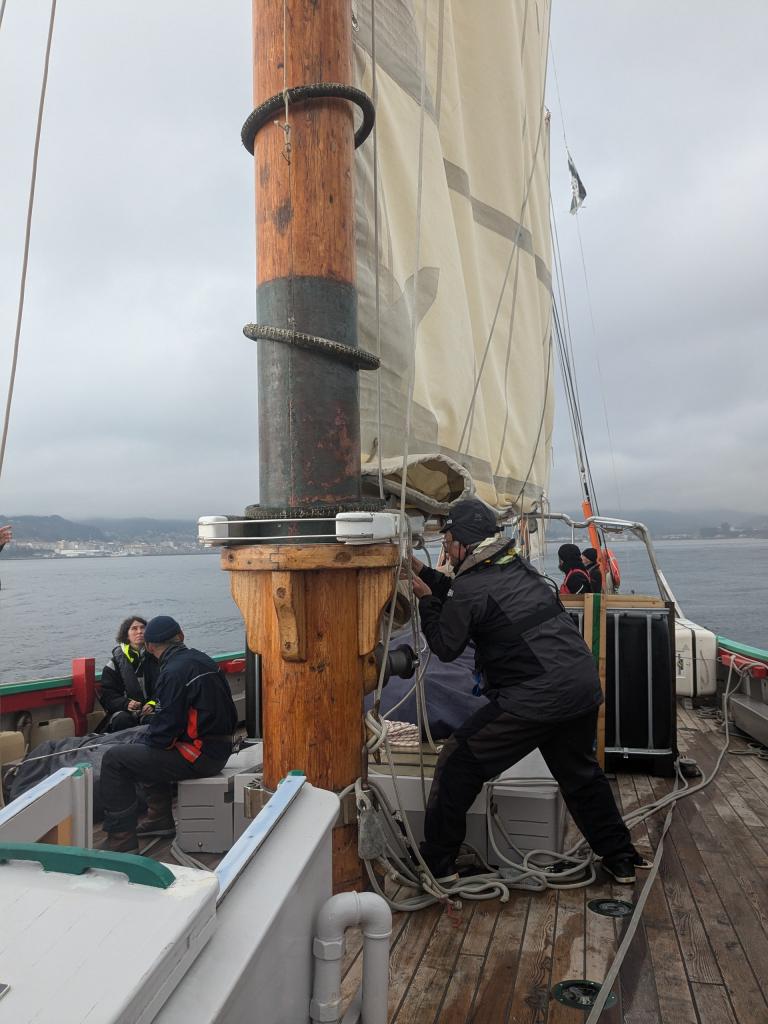
Sunday 1st Dec
It is still dark when La Nébuleuse casts off the quay of Paimpol, greeted by a few early morning hands. After the lock, the boat advances cautiously between the poles to look for an area to hoist the sails. This operation takes a good hour. The new crew members pull rhythmically on the heavy ropes to set the immense mainsail, the red jib at the front and the jib at the back. The fourth sail, the jib, remains in its bag for the moment.
Led by Cédric, the captain, the boat slips between the islands of the Bréhat archipelago.
As we leave, the wind is against us, forcing us to use the engine to get going as quickly as possible.
Lunch is taken on deck. In the afternoon, showers push us to test the comfort of our bunks, certainly cramped, but a cocoon in which we feel good lying down.
At the end of the dinner taken in the saloon, I have hot flashes and feel exhausted. The COVID vaccination that I had 3 days ago, is undoubtedly exerting its unpleasant effects that will follow me for 2 days. Martine is not more valiant because she has taken a rhinotracheitis virus that does not leave her...
At midnight, the boat rounds Ouessant and begins its descent into Gascony towards the Spanish tip of Finistère.
The wind does not help us much and forces the engine to stay active.
Wednesday evening, we reach the Spanish tip, then go down along the west coast.
Today Thursday, we stop near Vigo for a night.
The weather forecast for Saturday is for a strong wind of force 7 with gusts of force 9 in the right direction with waves that will push us towards the Canaries, our next stop. In the north in Great Britain, the anemometer could climb up to 160 km/h.
The captain is confident in his boat which has seen others. These forecasts do not scare him. But, we are going to tie down all the objects that risk being transformed into projectiles by stepping over the crest of the 4 m waves and plunging into the troughs.
With a headsail, as in the event of a leak, the captain promises a good average under sail!
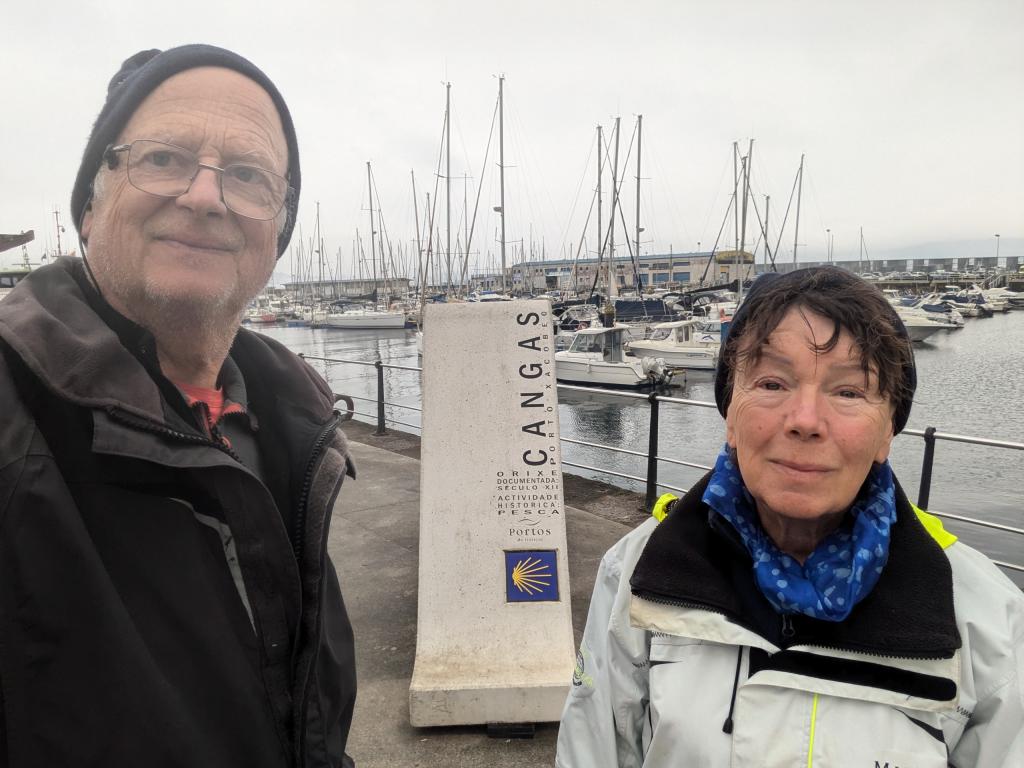
A Cangas près de Vigo, pour une pause de 24 h qui nous permet de donner des nouvelles à nos proches.
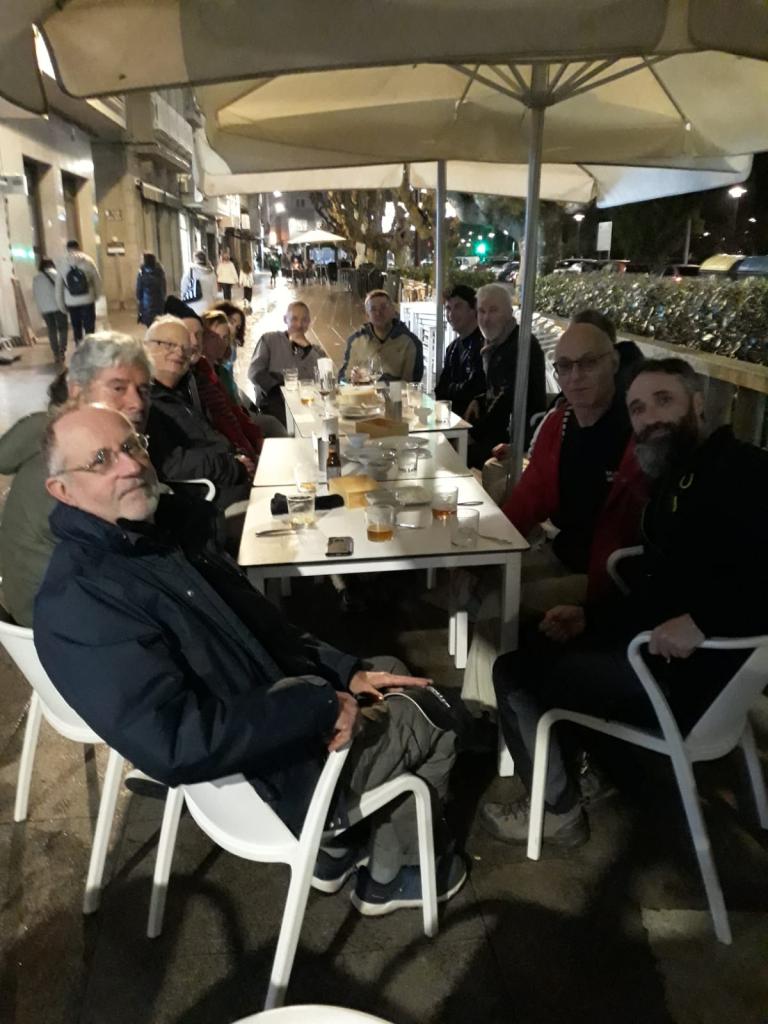
Tapas sur le port
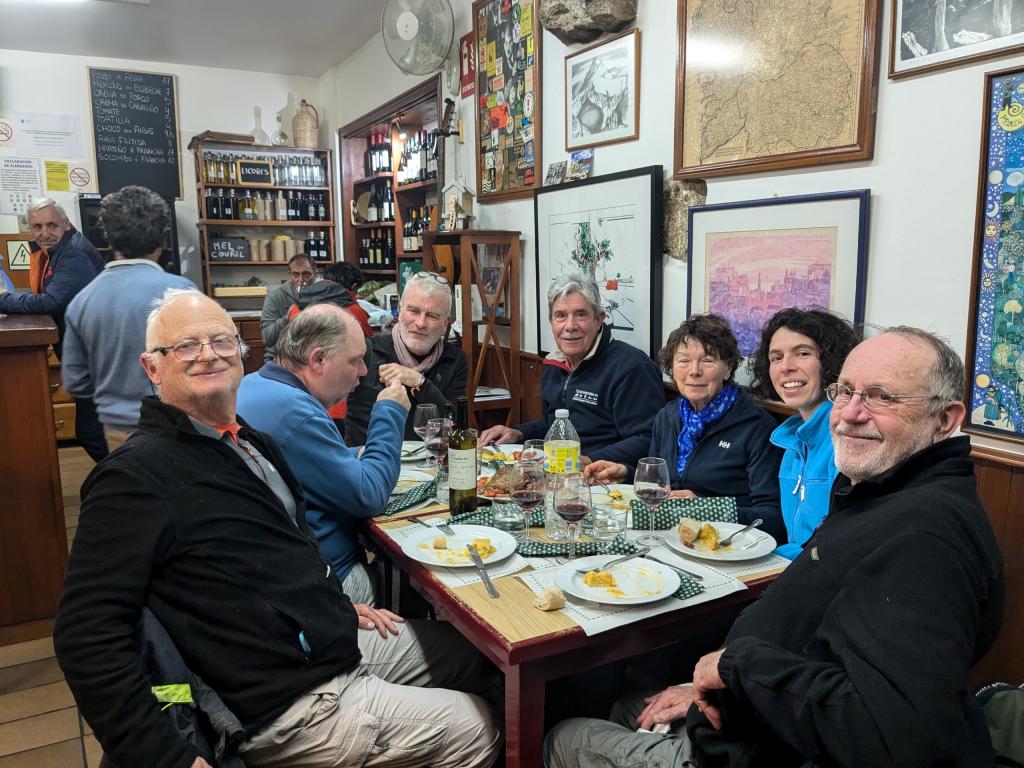
Dîner avec des échantillons de la cuisine espagnole
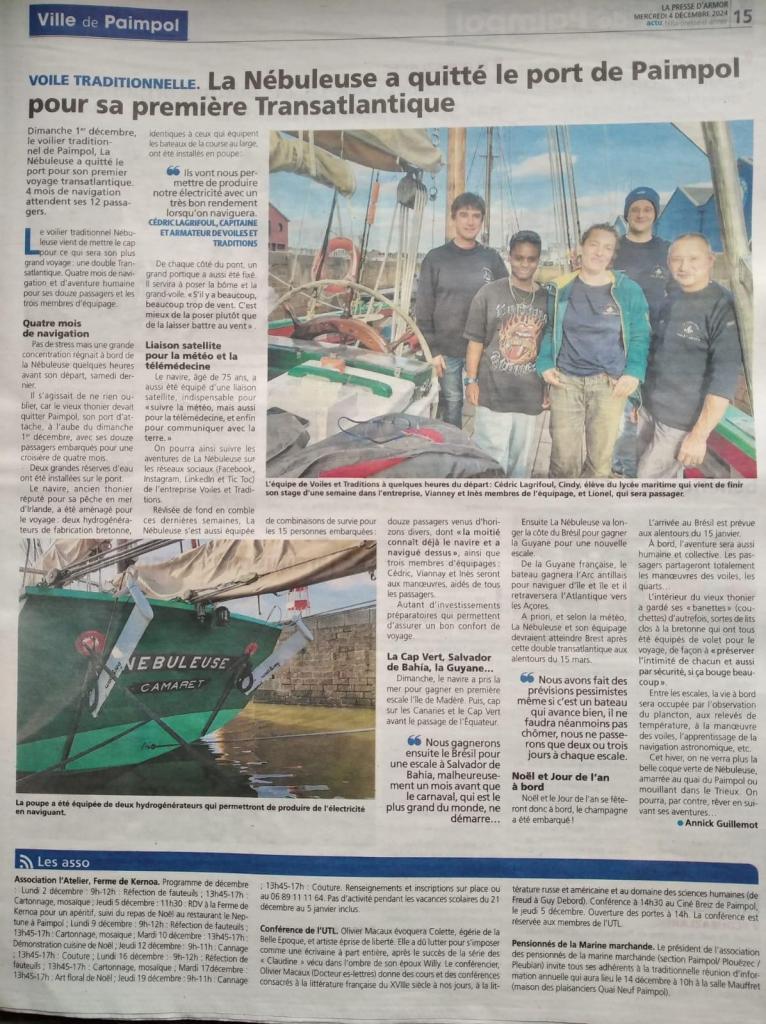
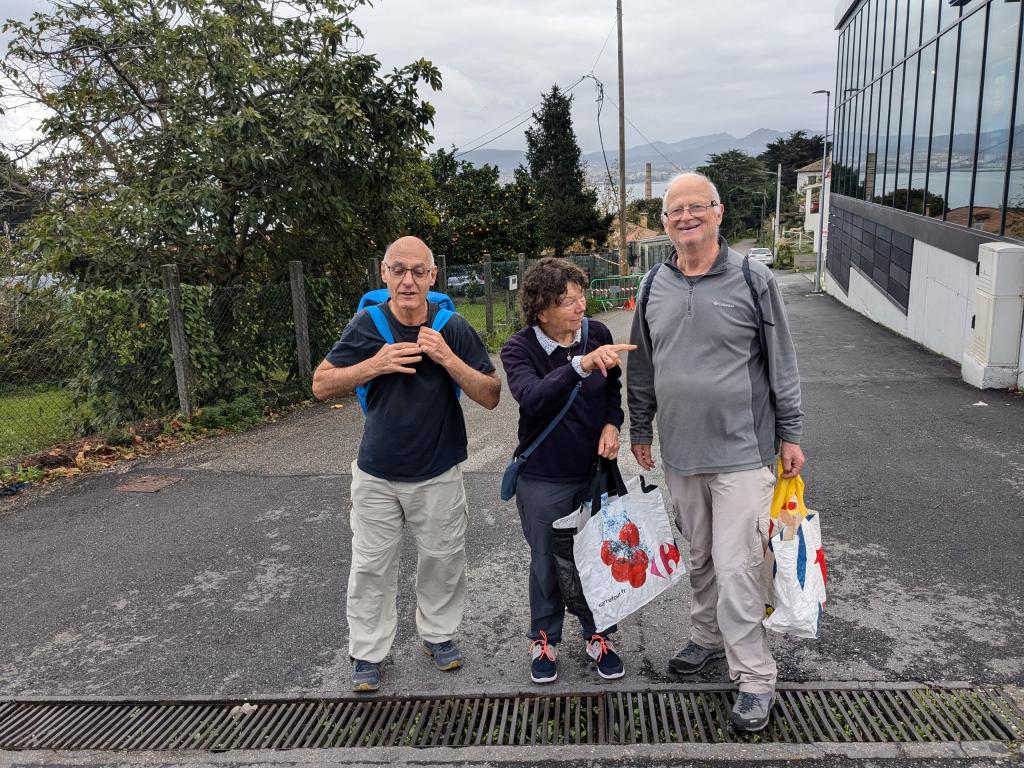
Friday 6th Dec
We extend our stopover in Cangas by one day to repair a few odds and ends. The weather is looking good from tomorrow to push us towards the Canaries.
We can thus rediscover the pleasures of showers and quiet breakfasts. Lionel, who plays the role of bosun, encourages us to enjoy land activities and to take the opportunity to eat on land. We therefore tasted several specialties, tortilla, octopus, scallops ... and pig's ears. The weekly market and a flea market are held on the jetty. But we gave up on acquiring local antiques because the captain does not seem to agree to load them onto the boat !
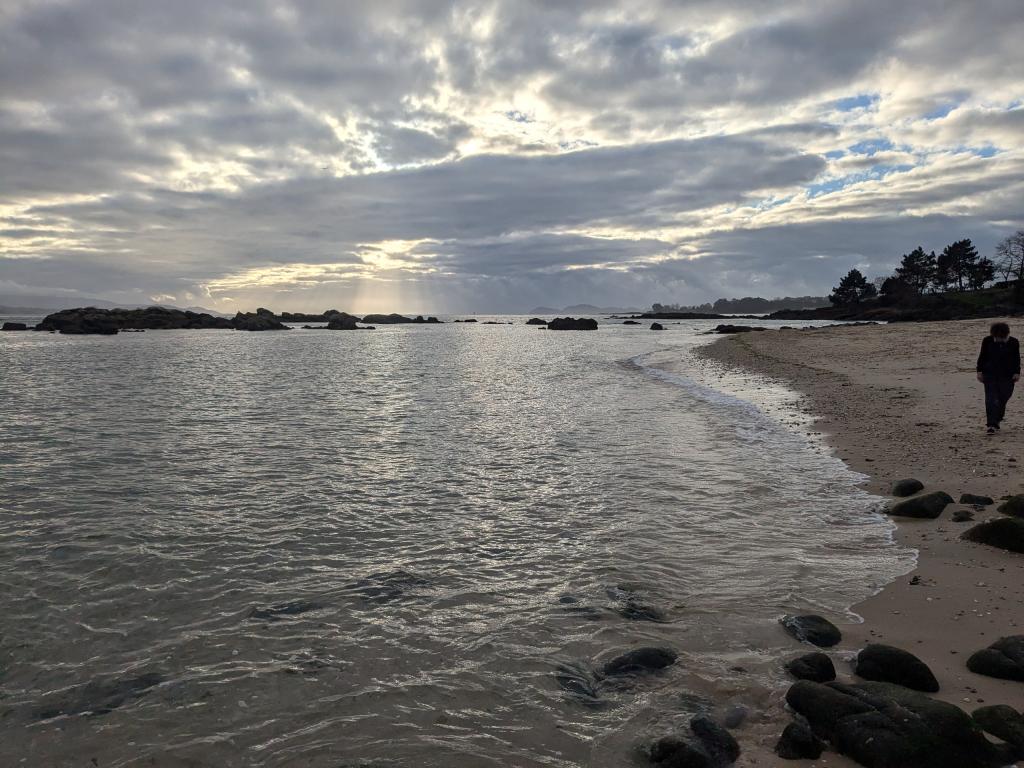
The sun is sinking towards the ocean. The cloudy strips announce an atmospheric change. Tomorrow, this tranquil setting will be transformed into a winter gale that will sweep our skiff towards the tropics.
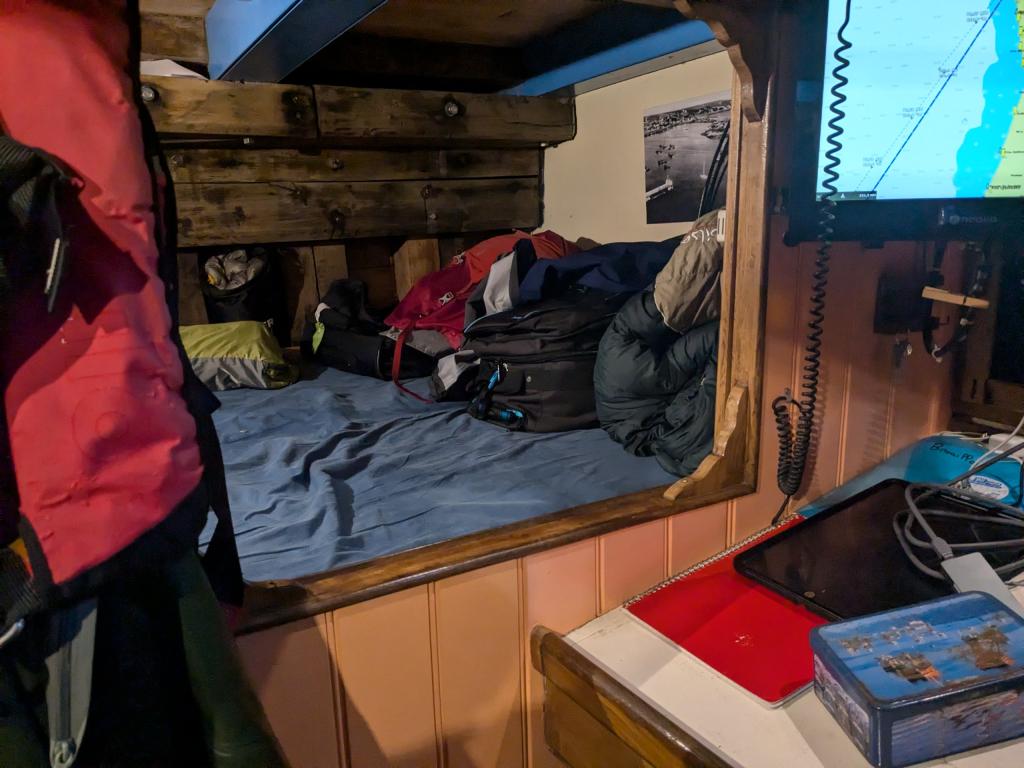
The exeguite of the bunks is part of the charm of the life of the old cooper, a relative discomfort compared to the life of the fishermen who left and still leave today on fishing campaigns.
Our bunk measures about 2 m by 1.3 m. It also contains our bags. We have a light and a 220 V socket. A central beam often reminds me that I am tall, even sitting.
To access it, I lower my head, I lean on the lower bunk with my left foot, I look for the corner of the chart table with my right knee while trying not to crush the captain's computer, finally I try to throw myself into the bunk. The operation becomes complicated when the list gets involved.
For the night shifts, Martine and I were selected for the midnight to 3am shift with Nicolas and Michel. It is one of the most fun shifts. Barely embraced in the arms of Morpheus, the pleasant ringing of the alarm reminds us of our duty. We have to put on heavy clothes to reach our post on the bridge and attach ourselves to the lifeline. The main part of the work consists of looking for the emergence of submarines not detected by the AIS. It is also possible that ancient sailing ships, without AIS, are on a collision route. There are also maneuvers that require many arms.
When the relief team surfaces, we return to our bunk with undisguised pleasure.
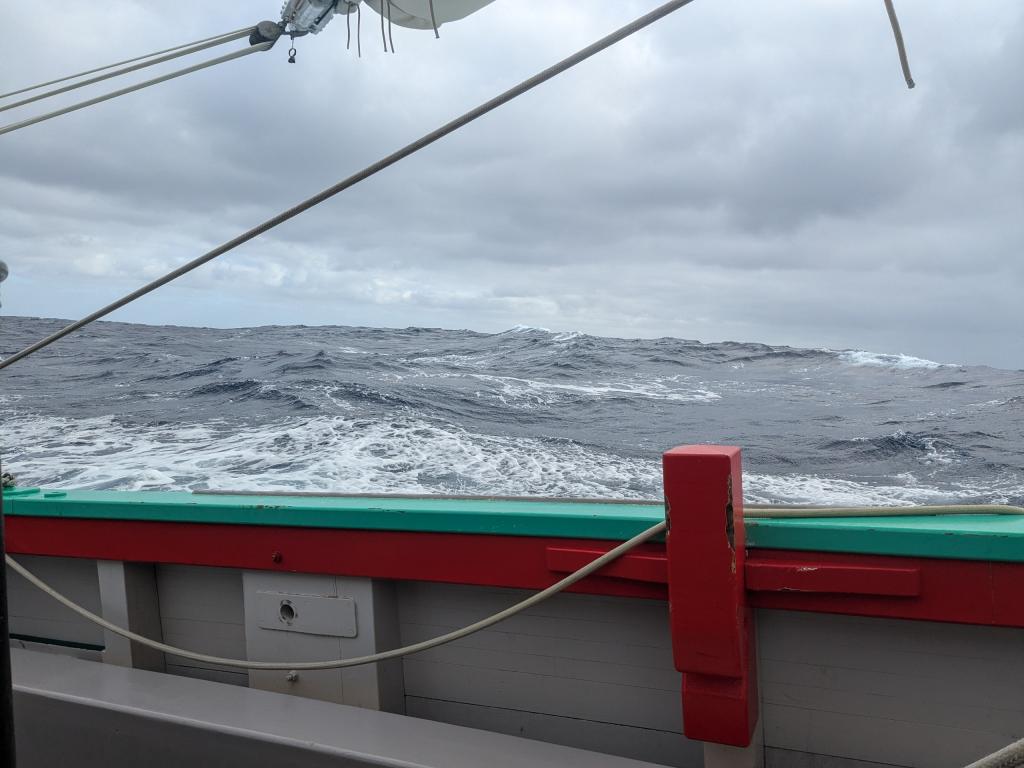
The noises in the boat
By ear, we understand the behavior of the boat.
With each rolling movement, the wood twists and creaks like when you walk on an old floor.
The flow of water along the hull and the wind create the rhythm.
The ropes squeak as they stretch and relax. I also think I can make out bleats coming from hesitant sliding or noises like creaking doors. Dogs sometimes bark when two pieces of wood rub against each other. Shrill cries of seagulls, croaking of crows or other birds populate the marine environment.
Are you okay?
Don't worry!
Sound combinations can make you believe they are words, sentences or sometimes laughter. It's not surprising then to believe you are also hearing voices from beyond the grave.
Sometimes, a sail flaps, indicating that the boat is straying from its trajectory. It suddenly sways and re-inflates. But you have to avoid accidentally tailing the mainsail, which can break the rigging and is dangerous for the crew members in the trajectory of the sheets.
The hydrogenerator contributes to the music on board and changes note depending on the speed, like the dynamo on an old bicycle. When the sound stabilizes at a high frequency, the boat is no longer slowed down by the waves and goes faster. It is the boat's only source of natural electrical energy.
At regular intervals, restarting the engine to top off the battery recharge breaks the spell by reminding us of our dependence on fossil fuels.
The autopilot is noisy. The pneumatic hoses pass through our bunk. Martine feels like someone is playing a bugle in front of her right ear.
From the kitchen, we sometimes hear exclamations when a dish has slipped out of our hands.
Life as a sailor isn't easy!
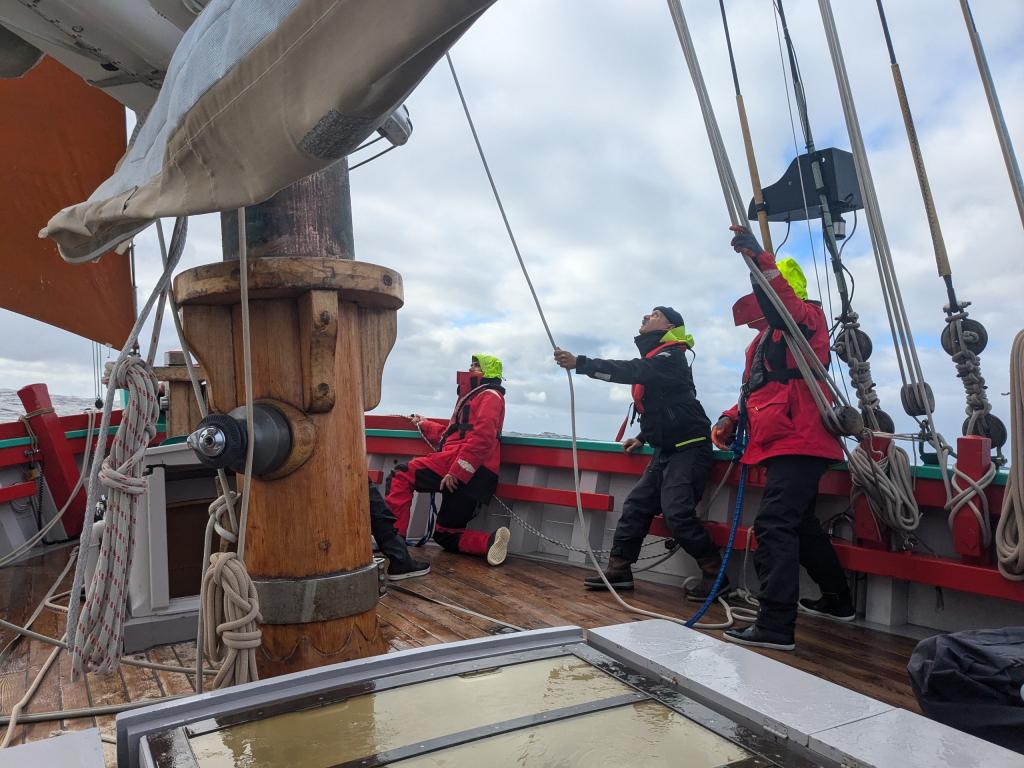
Tuesday 10th December
A wooden pulley broke under a squall. A gust of wind surprised us at the end of the manoeuvre to secure the white jib. Under the tearing forces, the pulley gave way and forced us to bring in the sail that had just been installed.
The sail of the spar tore over its entire height during a reef reduction, forcing us to remove it to have it repaired by a sailmaker later.
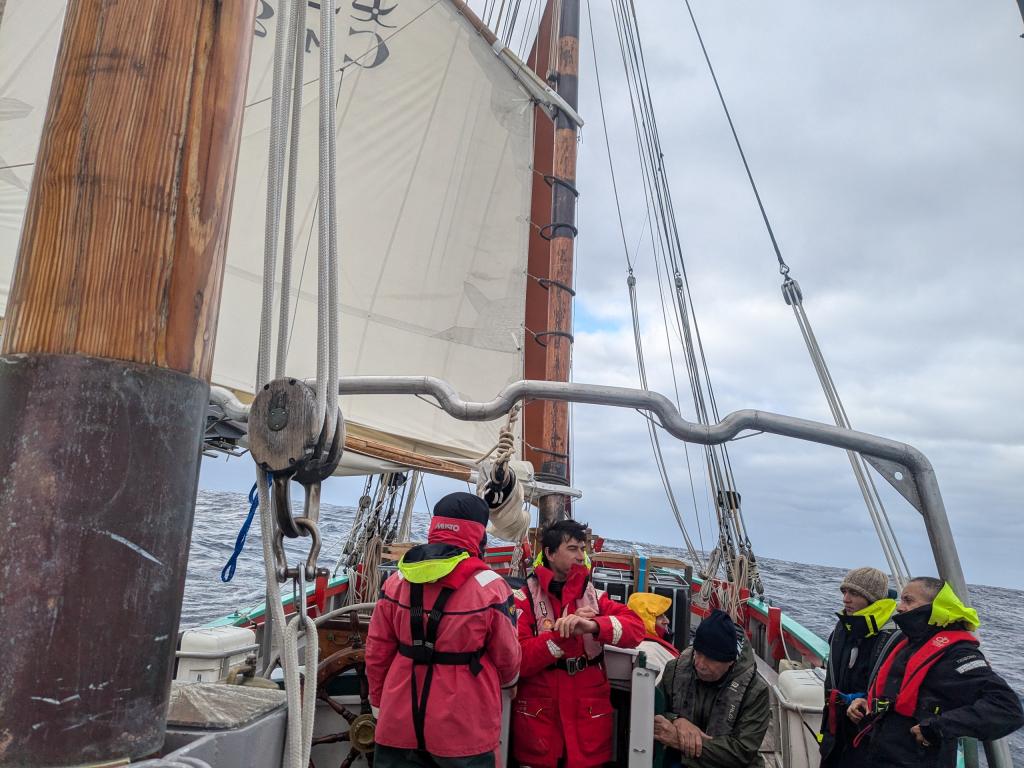
Ho hoist, ho hoist, Vianney paces to hoist the sails.
To succeed in the maneuvers, small groups combine their forces.
For the mainsail, you need a team to hoist the peak and a team to hoist the mast.

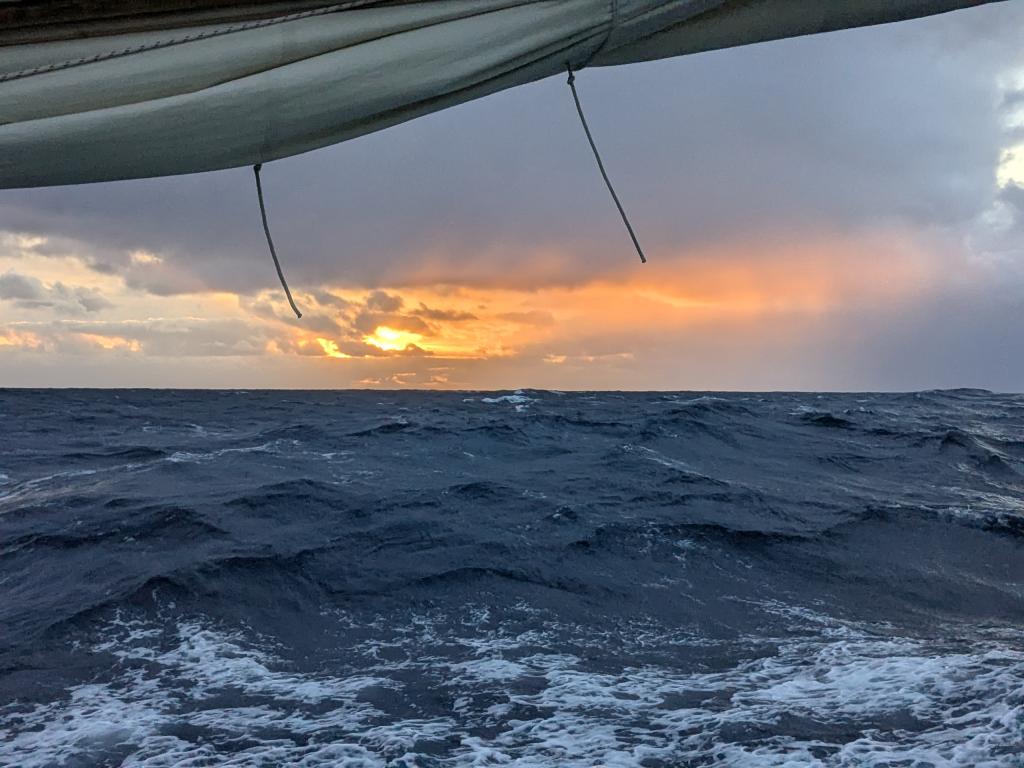
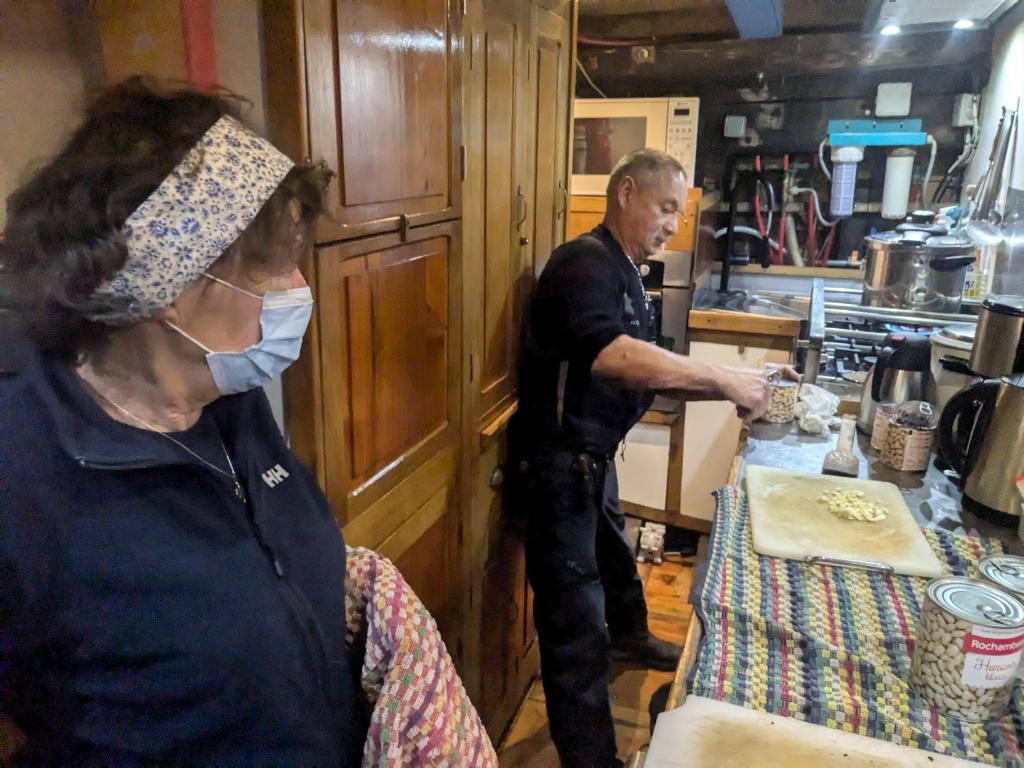
Wednesday
At dinner in the wardroom, we talk about Christmas and crossing the equator. For Christmas, Thierry talks about garlands. We should be in Cape Verde for Christmas.
For the crossing of the equator, 3 members have been named dignitaries of the ceremony since they have already crossed the line by boat: Nicolas, Lionel and Thierry. Nicolas coming first since this honor goes to the one who crossed it by sail. They will secretly prepare the tests they will subject us to, like hazing.
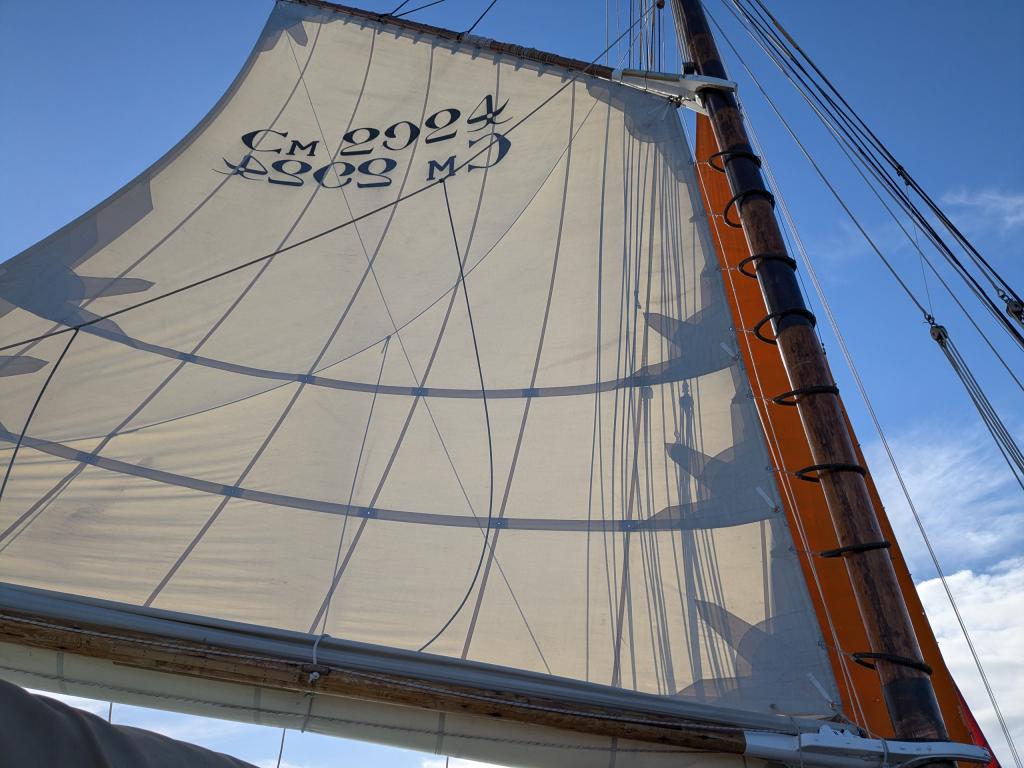
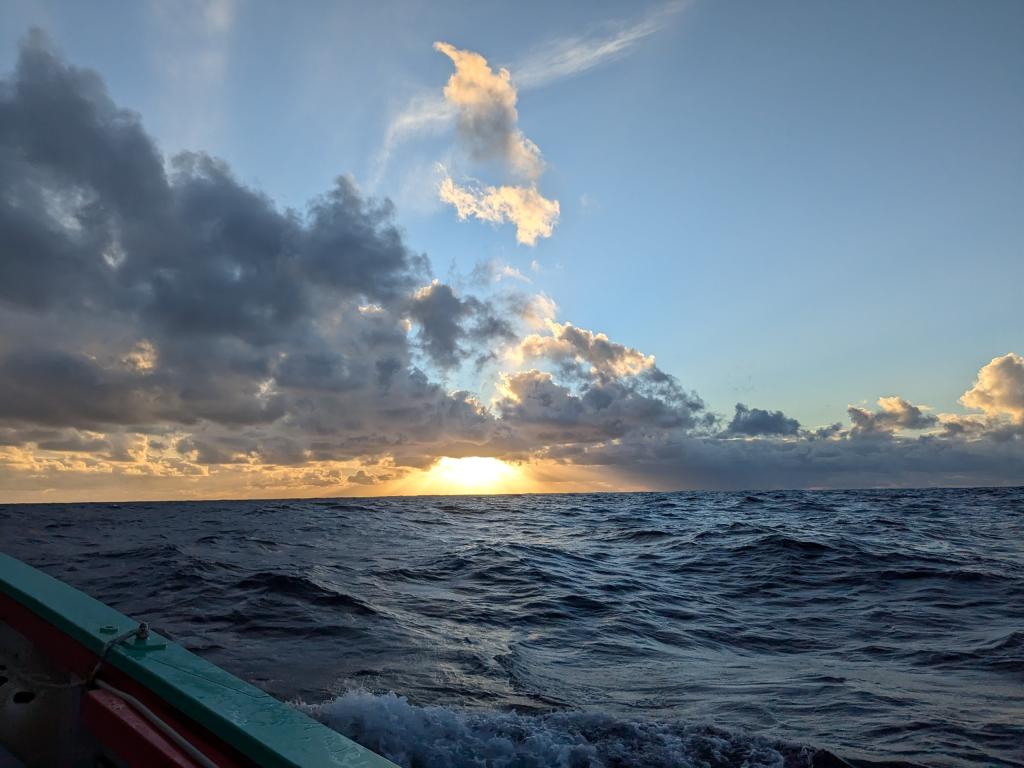
The sky is a permanent spectacle that never tires me. I can contemplate it like a child hypnotized by his favorite series.
Shapes are drawn with superpositions of shades of colors with a dominance of white, gray and a hint of gold in the evening.
The light volutes are pursued by the threatening cumulus clouds. The picture is completed by clumsy tubes and ink stains.
I see ephemeral sculptures: Obelix flying, an elephant, a rhinoceros, a polar bear, a dog, a Michelin man, a boat carrying different characters, a shark, a seahorse, icebergs, lace, a flying saucer, a windmill, the Concorde ...
Repeated rainbows allow us to formulate good wishes for the rest of our adventure.
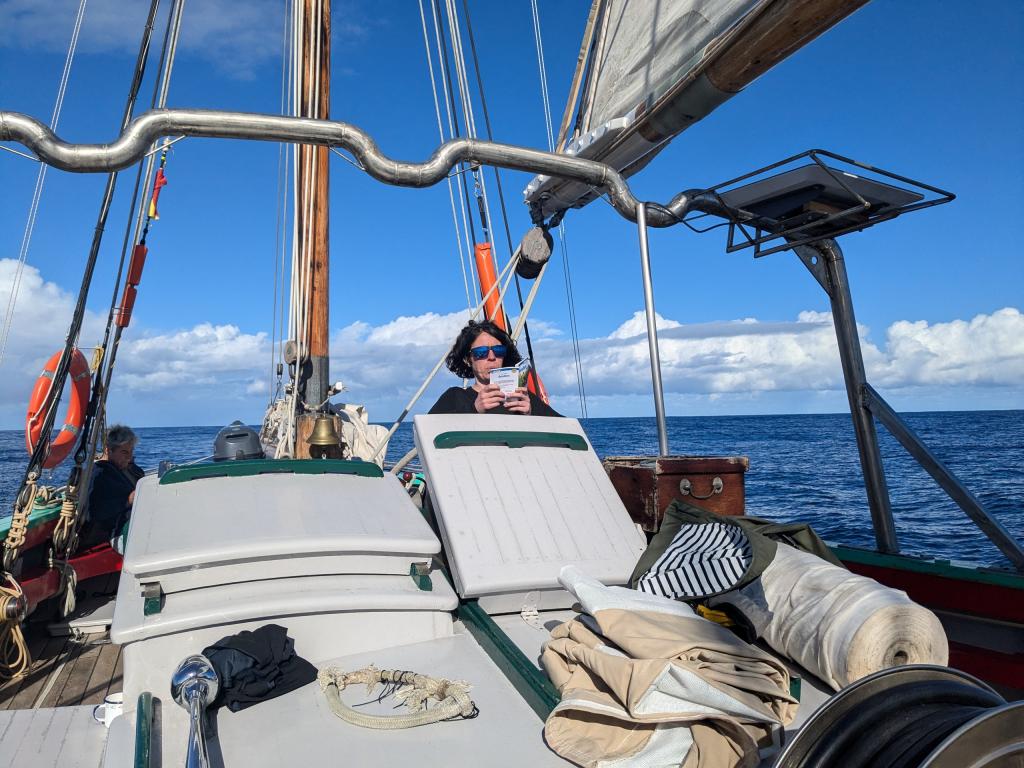
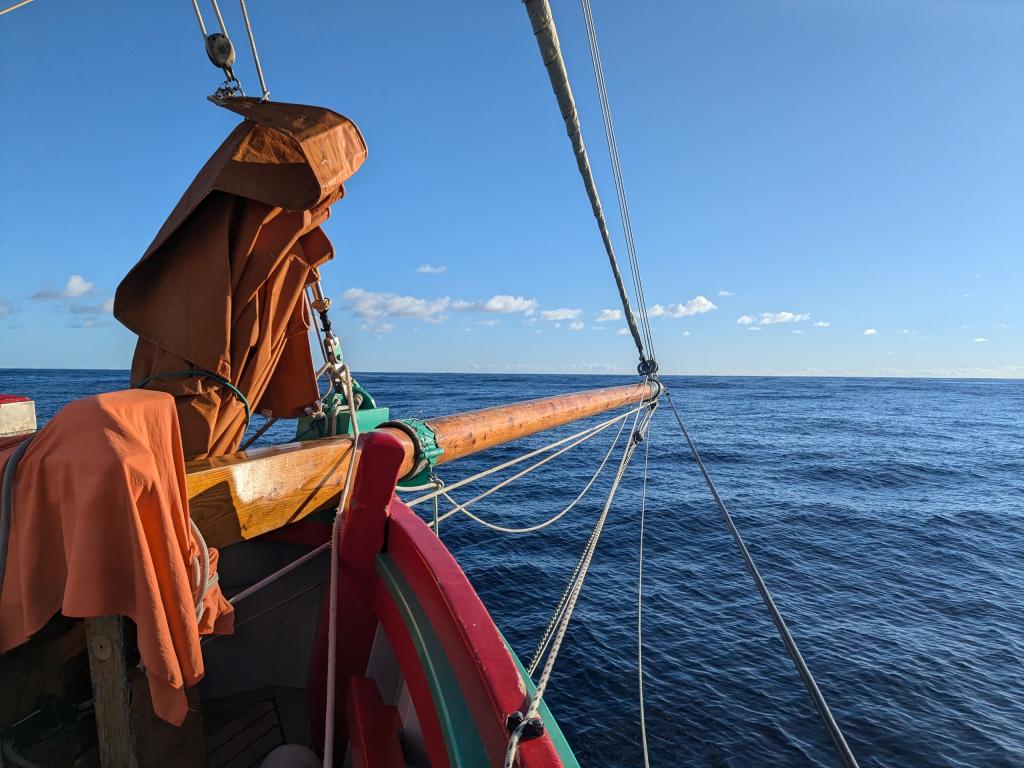
Thursday
The north wind forces us to deviate from the straight route towards the Canaries which are due south to avoid the tailwind.
No more water at the tap. After transferring the water reserve to the tank, the circuit has been deprimed. In the meantime, we find a little water in the bottom of the kettle for breakfast. Thierry was soaping himself in the shower when the water stopped. He smells of soap now!
The sun is becoming more present. Sunscreen is becoming essential for extended stays on deck.
The engine is no longer working! Studs on the injection pump have broken. We have to make do with the light wind to move the boat forward. Arrival in the Canaries seems delayed.
Lionel is using his skills as a mechanic to try to repair it. As he is also in charge of the kitchen, we are doing everything we can to make his life easier in the hope of not dying of hunger and thirst on our boat.
The korrigans have managed to cook without water! Thanks to the inventor of tin cans.
The small waves toss the boat and the mainsail swings around the mast, creaking in a worrying way. The boat's movements no longer have an uncomfortable effect on our bodies, which have become accustomed to being jostled.
In the early afternoon, the engine is temporarily repaired and takes over from the wind to push us towards Tenerife, the Canary Island where we could find mechanics and sailboats to repair our damage
The calm sea offers us a well-deserved comfort after these first days of sailing. I never tire of watching the spectacle of the sea and the sky while listening to Gérard's stories.
I rehearsed the song Loguivy-de-la-mer with Thierry by listening to his recorded version and repeating the words on a damp sheet of paper that had suffered the ravages of the rain in his bunk. We will need a few more rehearsals to be ready.
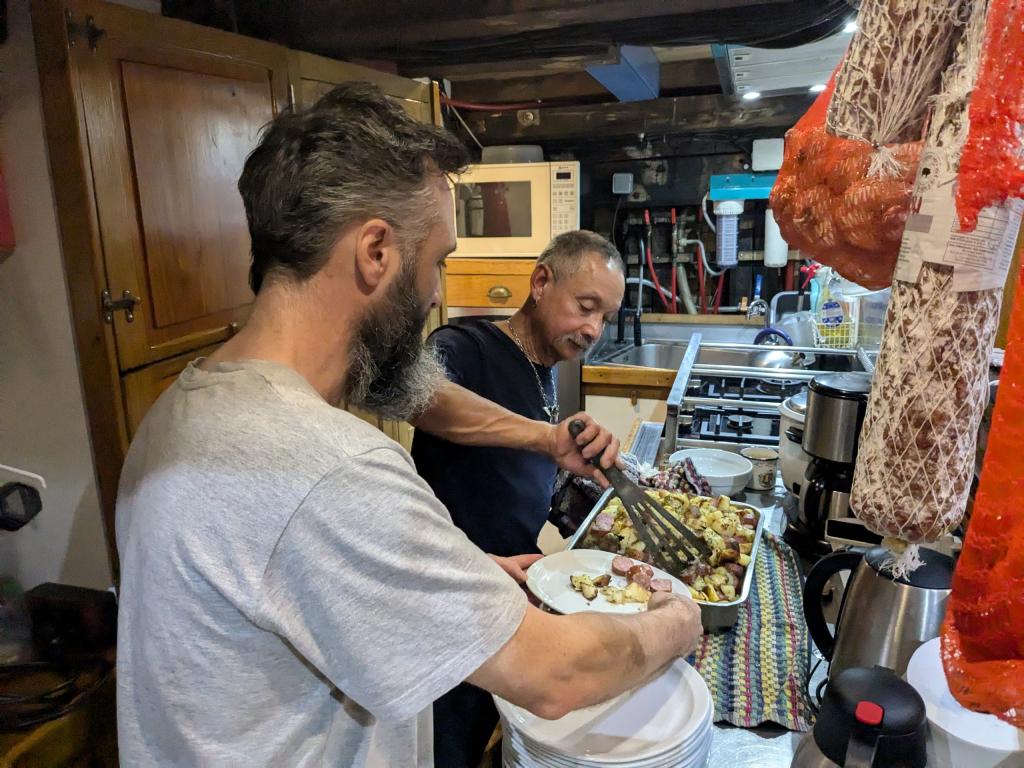
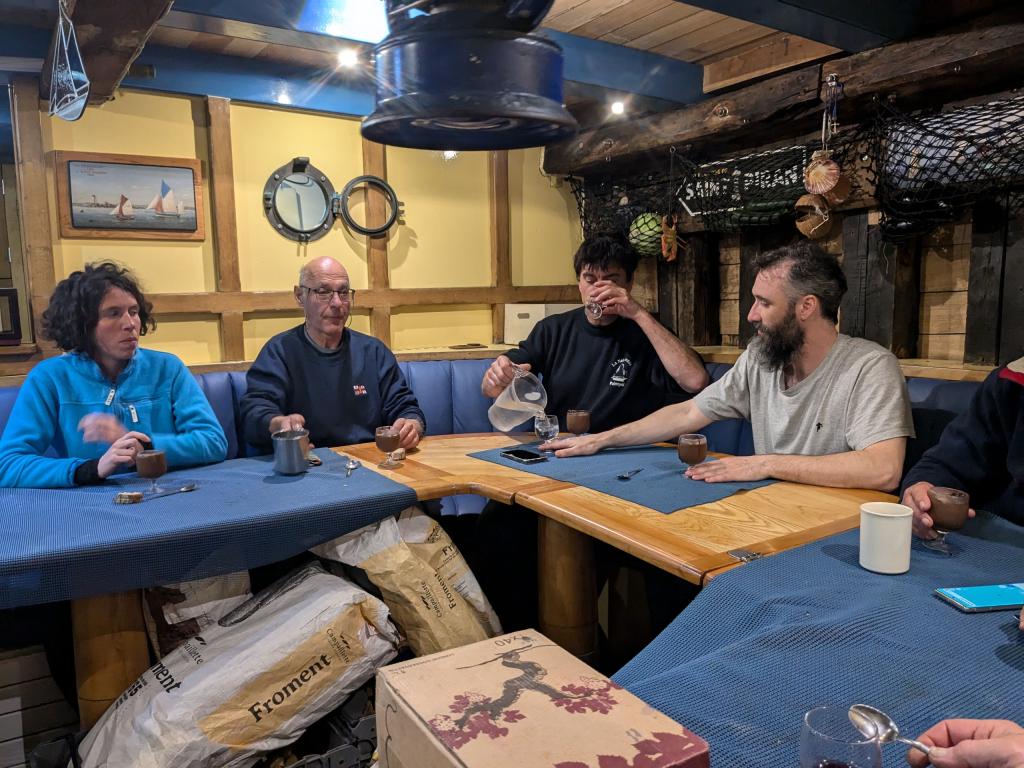
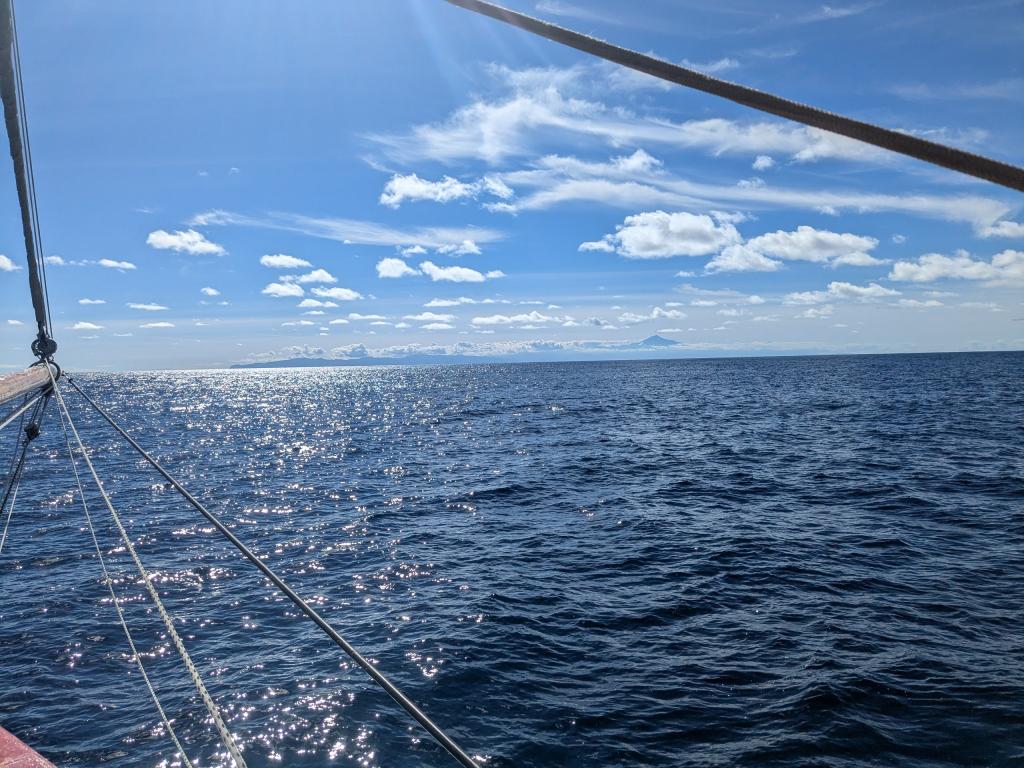
Friday 13
The day begins with the midnight watch at 3am, as usual. The flashes of a lighthouse signal us a land on our port side. It is an islet called ila Selvage, the first land after 6 days of sailing. It houses an astronomical observation station. Its highest point is at 136 m. It is therefore better to go around it carefully.
The moon powerfully lights up our environment and relegates the stars. I try for the first time an application that gives the names of the stars and planets by pointing in their direction. We thus spot Mars and Jupiter. Venus is revealed lying below the horizon. The Big Dipper begins to sink in the north and will disappear completely when we are in the southern hemisphere.
Going up on deck this morning, I discover the volcanic island of Tenerife looming in the distance 55 miles away with a peak culminating at 3500 m high. The mist envelops it, giving it an alpine profile alternately with steep slopes falling sheer into the sea or the illusion of smoke from a volcanic eruption.
The temperature is mild. A few wisps of gray clouds float above the ocean.
The DIY workshops keep everyone busy. A pulley seized by salt, a pipe to fish out of a water tank, a fishing line to untangle...
The pleasure of sailing is there. The progression between winter weather and this return to spring contributes to the general good mood.
The stage in the Canaries could extend until next Tuesday or Wednesday depending on the dynamism of the mechanics and sailboats to repair the damage
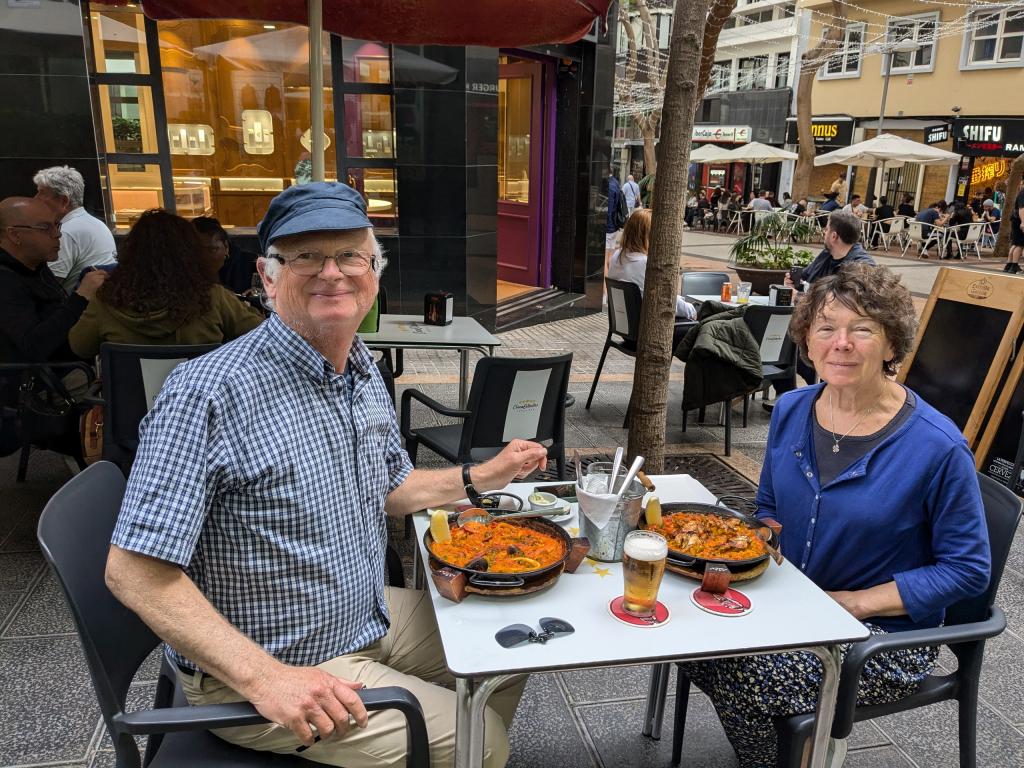
Fifteen sailors left the port
From Paimpol, they set sail
With the engine, crossed Gascony
In Galicia, they repaired.
Left with the north wind,
Leaving Portugal to port
All sails out,
In the Canaries, they repaired.
Pull on the oars on board
South, they headed
With the chief at the oar
In Cape Verde, they repaired
Taking advantage of the trade winds
The equator they crossed
The doldrums, they swam
In Salvador, they repaired
The rest of this story
has not yet been written
But at the end of winter
In Brest, they will definitely repair
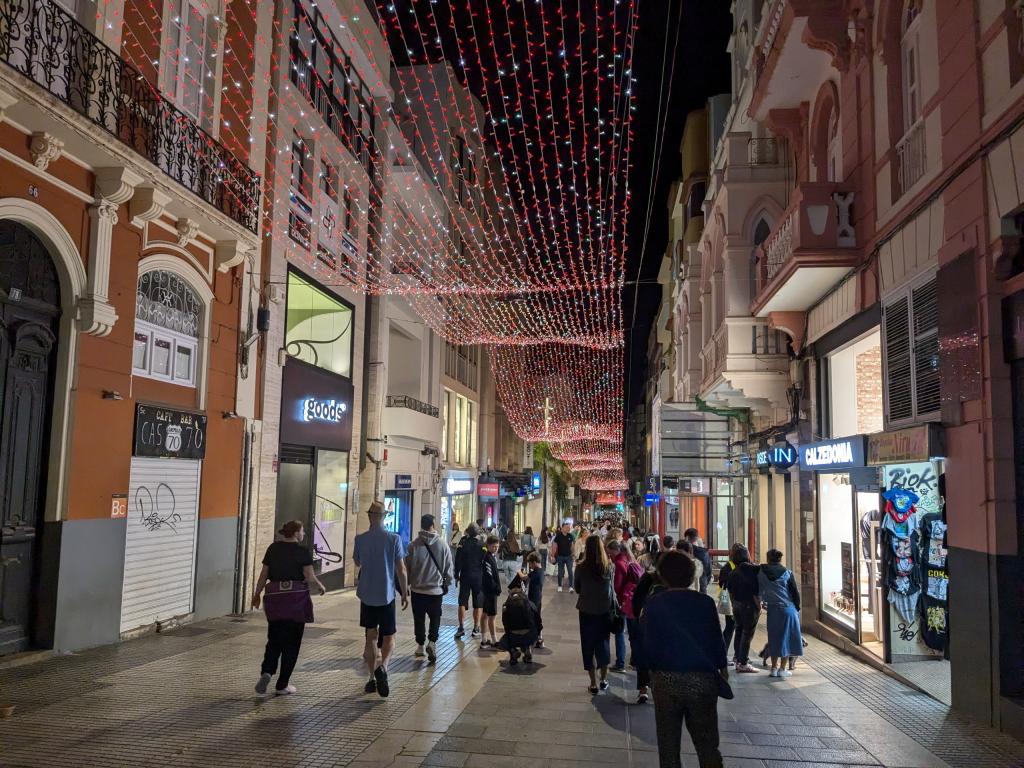
Arriving at the island of Tenerife is a highlight of our epic. While dining on deck, we discover that the massive shapes of the north-eastern tip turn out to be vertical, arid and inhospitable facades. Not a soul on this high cliff on which I think I recognise the mocking grin of a giant.
As we round the cape, we come face to face with cargo ships waiting to unload, which sound their deep sirens when the Nebula passes too close.
Then the lights of Santa Cruz illuminate this less steep side of the coast. We lower the sails in the darkness. Cédric, the skipper, takes the wheel to carefully bring the boat into the port, guided by a Spanish voice on the radio. The Nebula hesitates in front of a 50-metre sailboat, then throws its moorings to the sailors in the port.
We still have time to discover the city at night. Long pedestrian streets are lit up with Christmas decorations in the shape of fir trees and other festive magic. Several happy groups of women are wearing Santa Claus hairdos, shrubs, red gloves, garlands or other artifices evoking the northern regions from where Santa Claus will come laden with gifts!
When my comrades order a second liter of beer, I prefer to throw in the towel to find the boat guarded by Gérard. I climb into my bunk without setting the alarm for 11:35 p.m. for the night shift!
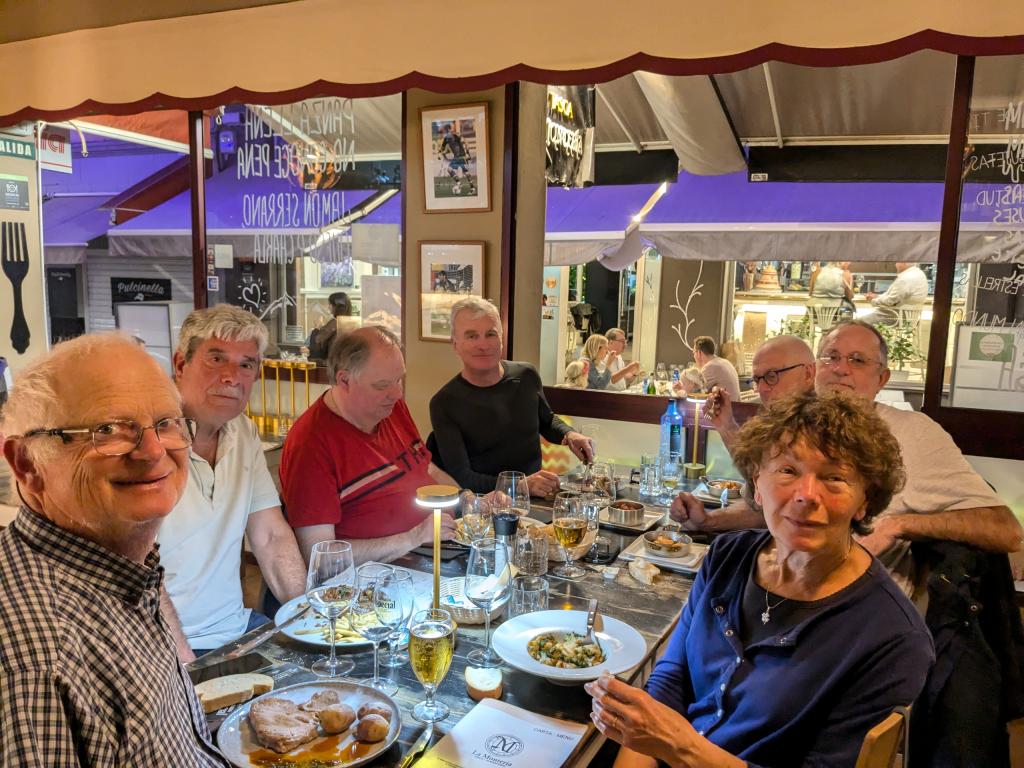
Saturday
It's morning clean-up. Under Lionel's orders, we polish all the surfaces, the duckboards, the tablecloths, the undersides of the floor before discovering the pleasure of a shower that doesn't try to lose our balance.
A paella restores us at noon. Then, Martine and I take the tram to climb to La Trinidad. The cold surprises us in this high-altitude town freed from mass tourism. We walk to the old church with a baroque altar and take refuge in a lively café among jovial Spaniards. I particularly appreciate this different moment around hot tea and cheese cake.
Back down, we have dinner with the group of team members who tell us about their day. François rented a car to explore the big island. We learn that the summit of Teide at 3715 m is closed due to wind and this for several days. That was our goal for tomorrow Sunday!
The news of the boat repairs says that the mechanic did not come this morning to look at the engine and that the sailmaker expected to repair the sail of the scuttle does not feel competent to make a solid repair. So we no longer know where we will spend Christmas? What surprises to distract our trip!

Sunday
In the port, we meet two other crews from France. The first 8 m boat left Bretagne in mid-October. The young skipper has enlisted successive crew members from among his friends. He has reached the southernmost point of his program and plans to go back up in the spring alone in small 2-day stages.
On the second 12 m boat, four young people aim to reach Australia. For the moment, they are like us, looking for repairers after a wave knocked the boat over and broke the boom.
They all seem relaxed, and calmly talk about their itineraries and adventures.
While Martine waits for the laundry to finish, I go to explore the areas to the southwest of the port. A church door is open and mass is starting. So I attend the ceremony in Spanish led by singers and guitarists. At the end, I approach the Christmas crib in which the baby Jesus has already arrived!
François rented a car to go around the island. He tells us: it is the most efficient way to get around and discover the different environments: pine forests, steppes and volcanic areas and on the other hand to meet the inhabitants far from the tourist circuits.
The bus is a complicated alternative that we are trying to use to be consistent with our desire to control our carbon footprint. But we have not yet managed to make a nice plan, especially towards the famous Teide. The offers are aimed at hotel accommodation customers. The niche of sailboat travelers is not the priority of tourist operators. So we continue to crisscross the neighborhoods of Santa Cruz... on foot in the wake of the locals who on Sundays go back and forth through the busy streets hoping to meet acquaintances to chat with.
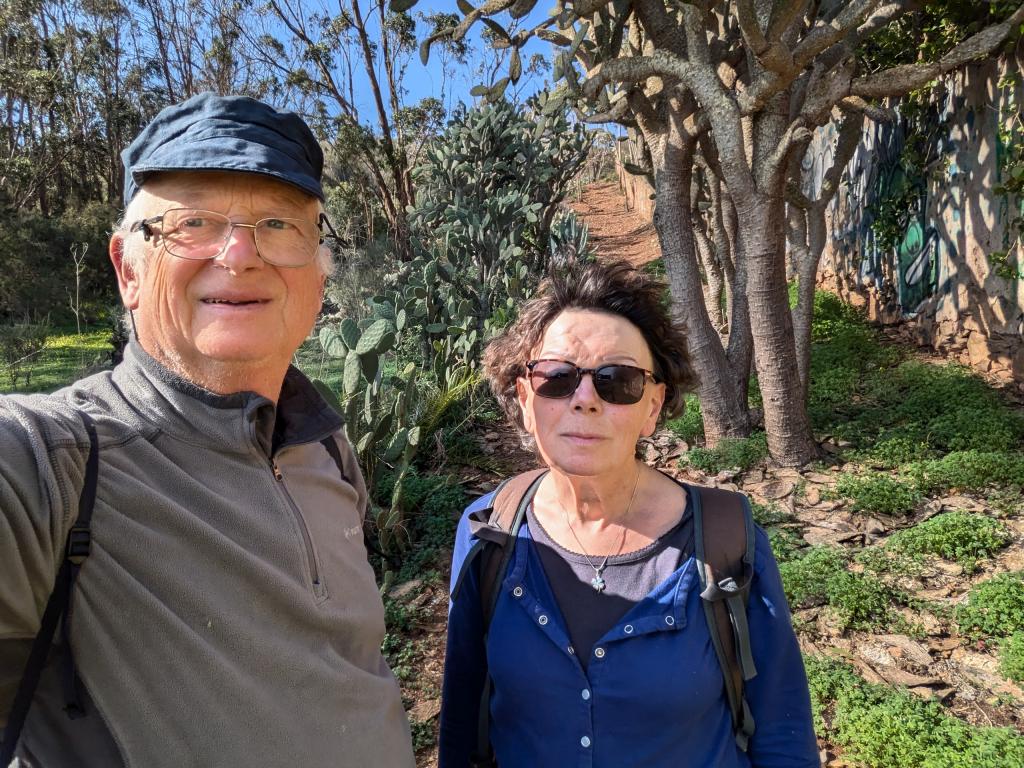
Monday
In the port district of Santa Cruz, large cruise ships pour out crowds every day who have only a few hours to take away souvenirs of the city. You have to go far to find authentic places living to the rhythm of the local population and the natural landscapes forged by the volcanoes.
We take the tram back to La Trinidad and stop at the Cathedral of Laguna. The audio guide bombards us with names and dates that I immediately forget. Some interesting paintings like the one representing three layers of characters: at the bottom: purgatory with tortured souls, in the middle the judges of our life with a scale to weigh good and evil, at the very top the venerable blessed who have managed to escape torment. The best part of the painting: an angel taking a soul out of purgatory.
We then try a blind climb and are lucky to find a rustic path that takes us towards rugged reliefs in the middle of eucalyptus trees and a hostile community of cacti!
Despite a strong wind that would not send a boat out, we manage to close our eyes under a pine forest to digest the garlic soup from lunch with our backs on small black slag.
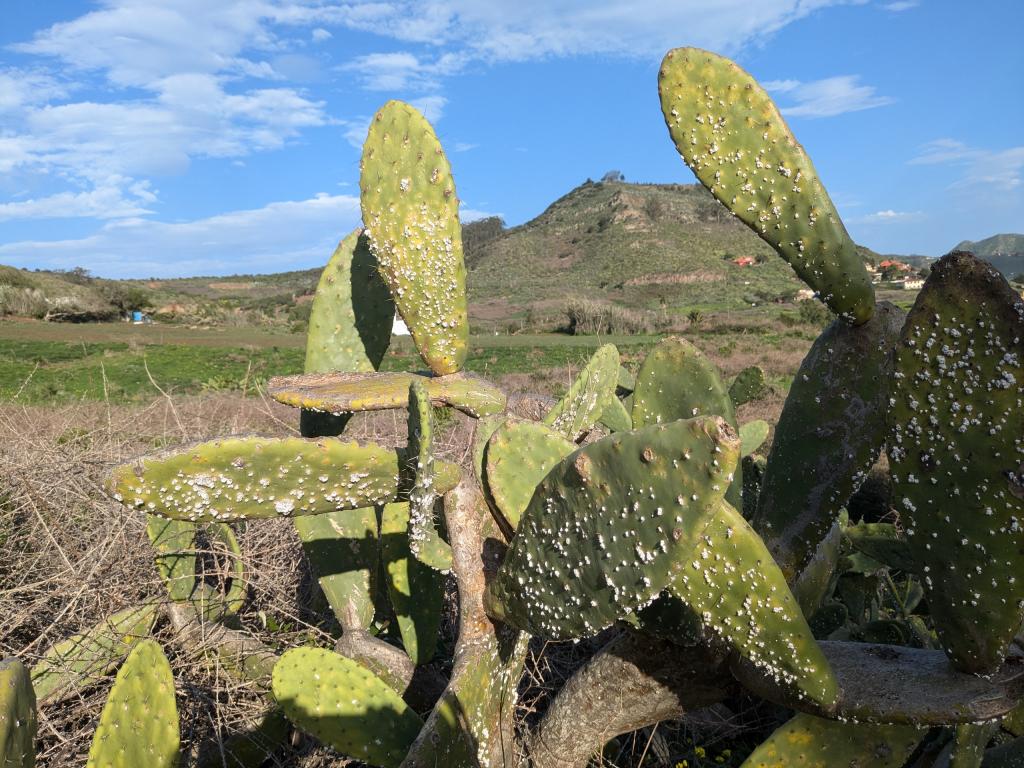
Tuesday 17th Dec
The engine of La Nébuleuse is repaired by the mechanic who has finally arrived. We welcomed him warmly! The captain also found a small sail to replace the torn sail of the tape-cul. We are still waiting for the tanker truck to deliver 1000 liters of fuel.
We are heading back south and moving further away from Europe. When we leave the Canaries, we will no longer pay in euros and the phone's SIM card will no longer work in Cape Verde.
Unless I find a local SIM card in this independent country or wifi, I may not be able to give any news before Brazil in mid-January. But La Nébuleuse will continue to be connected with a starlink antenna to receive weather information and send urgent messages. Information will be available in the news section of the Voiles et Traditions website. https://www.voilestraditions.fr/actualites/
The ship's positions will also be sent to a few emails.
Latest news: I just successfully purchased an esim for Cape Verde. So I will be able to stay connected and give news in a week.
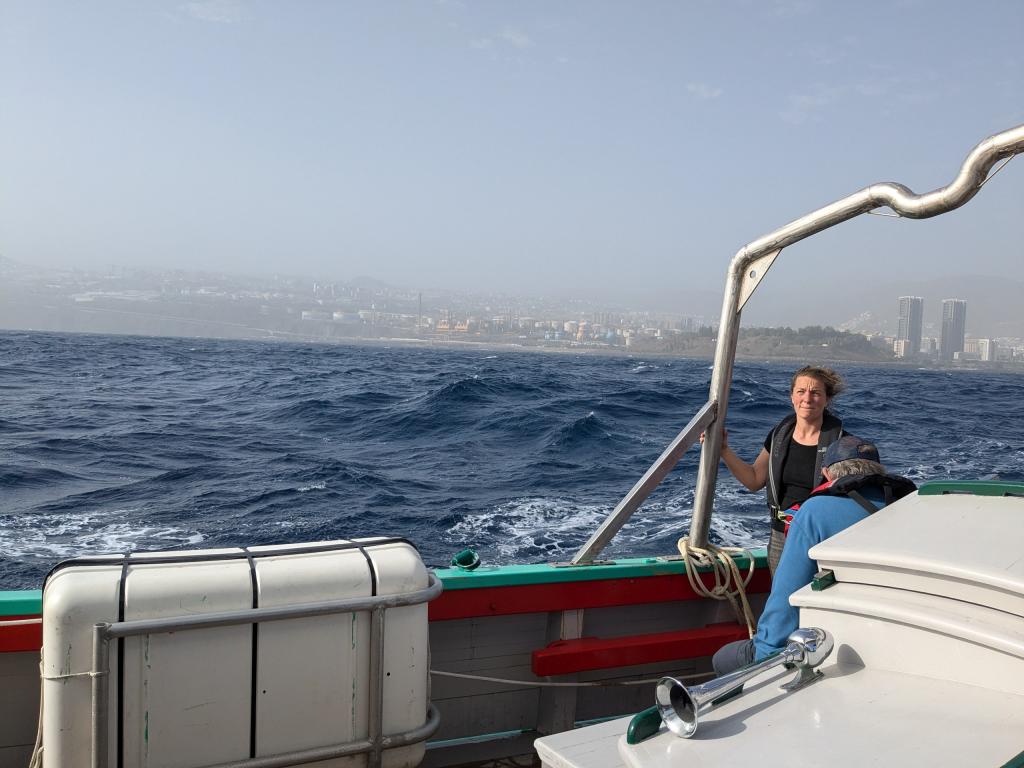
Tuesday
The forecast on my phone's Windguru is ideal with winds between 15 and 20 knots pushing us on a broad reach towards Cape Verde.
We think we're well-seas after 2 weeks of sailing.
So we don't take a Stugeron to reduce the risk of seasickness.
But the departure from the Canaries is in fact disrupted by a force 7 wind. The other sailboats stay in port. We pass another sailboat coming from the south advancing with reduced sail towards the port.
At first, I don't have any particular symptoms. But in the evening, I prefer to skip dinner, which fits well with my diet plan! When I take my night watch, I vomit and go to my bunk with a basin rather than the deck.
Anyway, these are not symptoms of cancer, since I decided to throw him overboard and drown him at the bottom of the ocean right here at the Tropic of Cancer line!
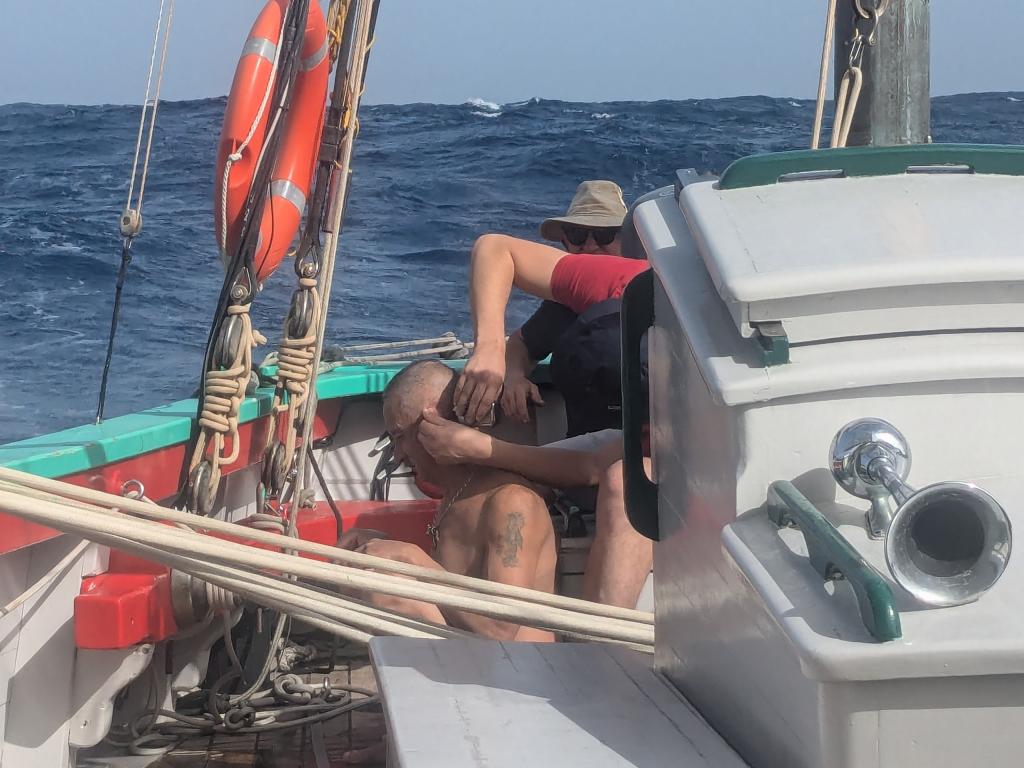
Tuesday
It's Martine's turn to be flat. Time is long in our coffin bunk in which we are immobile refugees. Other crew members are also suffering in their bunk.
The drugs Stugeron, Mercalm ... do not manage to stop the process quickly.
Finally, I return to duty on the night shift.
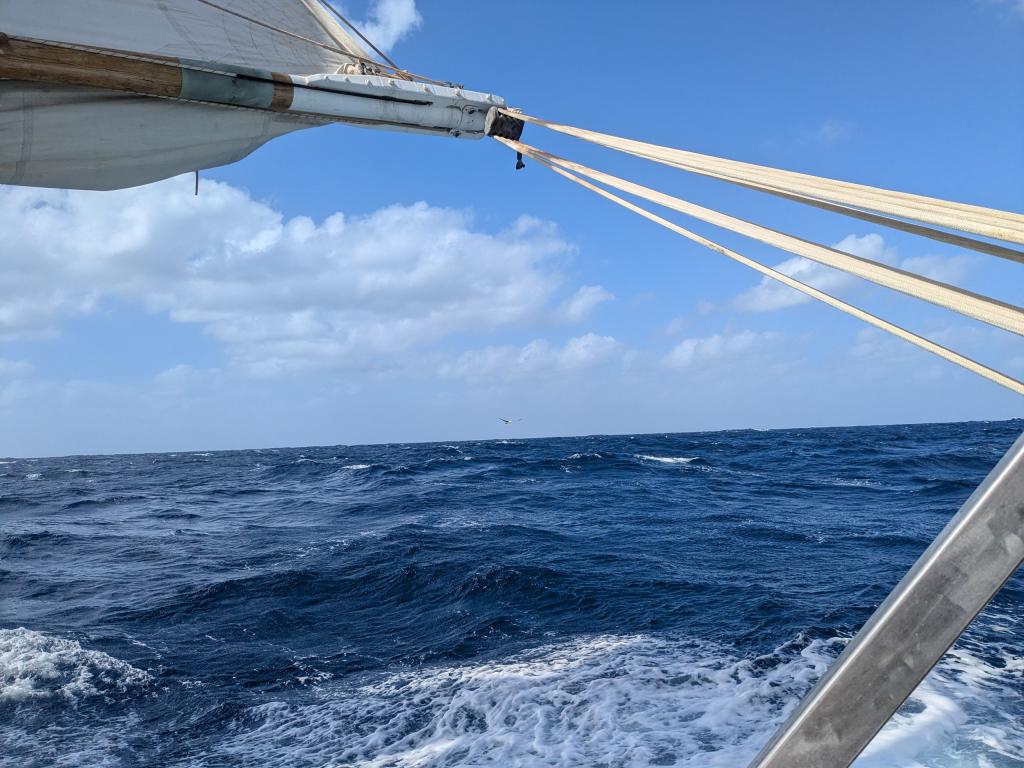
Wednesday
The east wind is pushing us vigorously towards Cape Verde. The waves are jostling us and roughing up the crew, who are taking refuge in their bunks when tasks don't keep them in the kitchen or on deck.
At 11:45, the boat is suddenly lifted with a crash, taking off everything that isn't secured and letting everything fall back down.
Voices are worrying:
What happened?
Did we fall on a shoal of the Arquin Bank like the Medusa?
In my head, the evacuation, the survival suits, the installation in the life raft pass by... And I take inventory of the objects that I absolutely want to keep in the shipwreck.
An initial search for a waterway is unsuccessful. The depth sounder seems to have paid the price. The captain's computer is dented. And the unwedged objects are to be put back in their place.
I attribute the shock to a large marine mammal, a sleeping whale...
It would seem in fact that it was a nasty wave that played this impressive trick on us that did not have any real unfortunate consequences at the time. The 45 mm wooden hull resisted well.
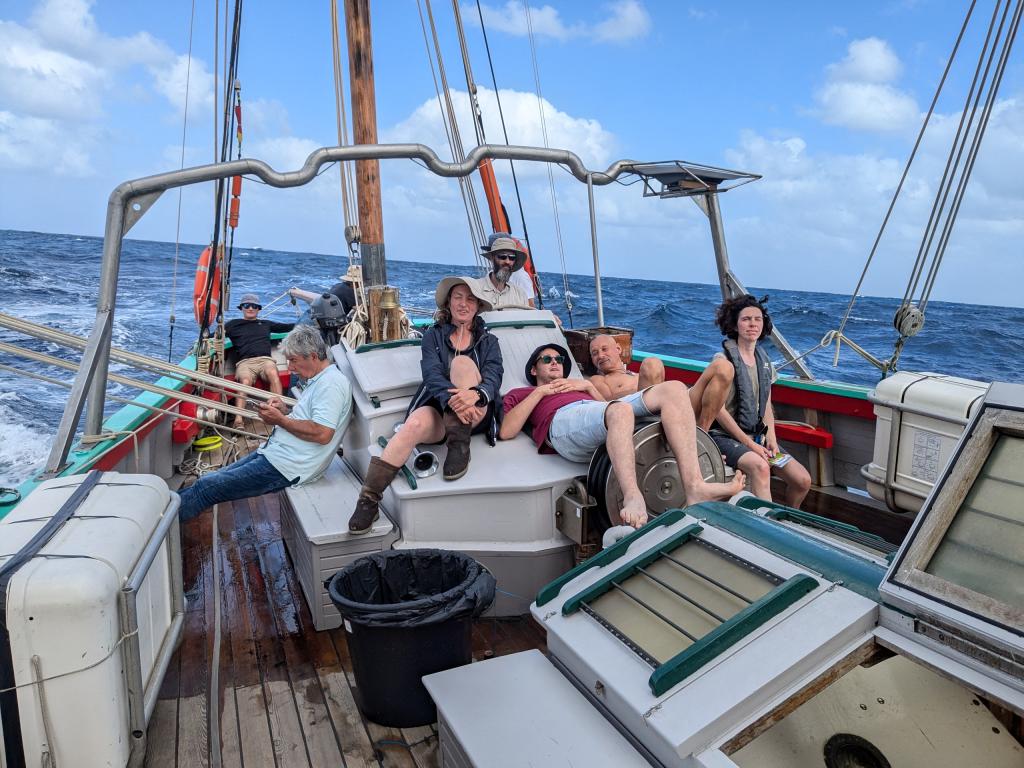
Thursday
The mainsail tack is repaired.
Laurent and André are fishing for sea bream, the first fish we kept for our food.
The wind continues to be stronger than expected, around 25 knots, roughing up the crew.
If we had waited for an optimal weather window in Brittany, we might still be waiting in Camaret. The weather in mainland France seems to be cold and unsettled according to Cédric's information.
Everyone is on deck at the end of the afternoon to enjoy a moment of grace and everyone is at the table for dinner.
Martine is testing the anti-seasickness goggles. She has success with the frame with 4 eyepieces containing liquids. Her impression is that they can be useful indoors to trick the brain by visualizing a stable horizontal line. It is still too early to conclude that they are effective.
At dinner, we discuss the future of sailing in relation to the climate.
The weather conditions are proving to be more difficult this year than in the past.
In a century, climatic phenomena will make it more difficult to sail as today. Boats will have to be able to withstand more severe conditions.

Friday 20
The starboard hydrogenerator broke its attachment points. It was only held by the safety rope.
The fresh food is suffering. The large 3 kg loaves of bread from Loguivy-de-la-Mer are starting to go mouldy. The oranges from the Canaries too. We also have to sort the potatoes and remove the spoiled parts.
Every 3 hours, the fire hose wets the wooden deck to prevent the wood from shrinking and cracking.
On a boat that moves, going about our daily business is a constant balancing act and leads us to reduce our toilet requirements... Basic principle: have 3 points of support, for example, your 2 feet well apart and brace yourself with your shoulder to brush your teeth.
Arriving in Cape Verde, night shifts will be maintained to prevent pilfering by a poor population who see leisure boats passing by.
Petty theft certainly doesn't bring much to its perpetrator, but can deprive the boat of strategic equipment.
When steering a boat like La Nébuleuse, you have to tame the significant inertia. You have to react quickly when the boat luffs after a big wave or when the jib starts to sway, which indicates a risk of jibing that must be avoided at all costs. Nicolas often entrusts me with the wheel, the exercise requires tiring concentration when it lasts a long time. I am a little apprehensive about taking on this responsibility in view of the risks and inconveniences that a bad maneuver can produce. Especially at night when the stars are missing and you have to steer by compass and map screen while keeping an eye on the headsails and reacting correctly to the waves on which the boat is trying to surf.
The fishing is good. The 3 beautiful sea bream provide fresh food for lunch. The largest is estimated at 6 kg.
During the night watch, I feel something wriggling at my feet. The lamp shows a flying fish that Martine grabs with both hands to throw it back into the water. A little later, another flying fish touches the hood and sleeve of Nicolas who is at the helm before landing on the deck.
The long watches allow us to discuss the house's work projects quietly. The last hour of the watch is difficult and we are happy to see the relief settle in our place.

Saturday 21
The wind is still pushing the tuna boat at a good speed. The average is over 7.5 knots. The display often exceeds 8 knots and sometimes reaches 10, 11, or even 12 knots. As a result, we might arrive tomorrow in the middle of the day in Cape Verde. Nicolas has already sailed to Salvador on a catamaran and has also stopped in Cape Verde. He gives us tourist information on these two planned stops.
We will have a few days to enjoy the island before setting off again for the non-stop crossing to Salvador in Brazil for 2 and a half weeks.
It's Inès' birthday today! She was born in 1992 and is a merchant navy graduate. The captain popped the champagne corks in her honor! During the aperitif, a stronger wave copiously waters Thierry and Martine who confirm that the water is good!
All day long, the show is provided by the flying fish that can rise up to 2 m above the water and race for about ten meters. For what purpose? To get a little exercise or to escape a predator. Lionel does not think they are big enough to pass them in the kitchen.
Gusts of force 8 risk jostling us from 3 to 4 in the morning. The captain decides not to touch the settings so as not to slow down our progress. Vianney, the sous-chef tells me:
The boat is capable of taking wind at force 8 downwind without taking in any reefs. But usually, the first reef is taken at force 7 and the second at force 8.
The end of our watch risks being tough unless we manage to escape this trail of a meteorological phenomenon on the North Atlantic.
Driven by the wind, our boat cuts through the sea, making the foam spring up on each side like a big white moustache.
With inexhaustible energy, the wind raises waves that ripple valiantly towards other horizons.
On the waves, small wrinkled facets reflect the sky with varied inclinations and shades of color.
As it grows stronger, the top of the waves is covered with white crests. Even stronger, the wind digs ephemeral furrows and streaks the ocean.
I see rogue waves that take our boat for a toy, throwing it into the air and letting it fall back with a roaring roar and laughing to see our dislocated skiff.
In a raging sea, I imagine giant whirlpools ready to drag us into concentric circles, crushing us and swallowing us into the abyss.en:
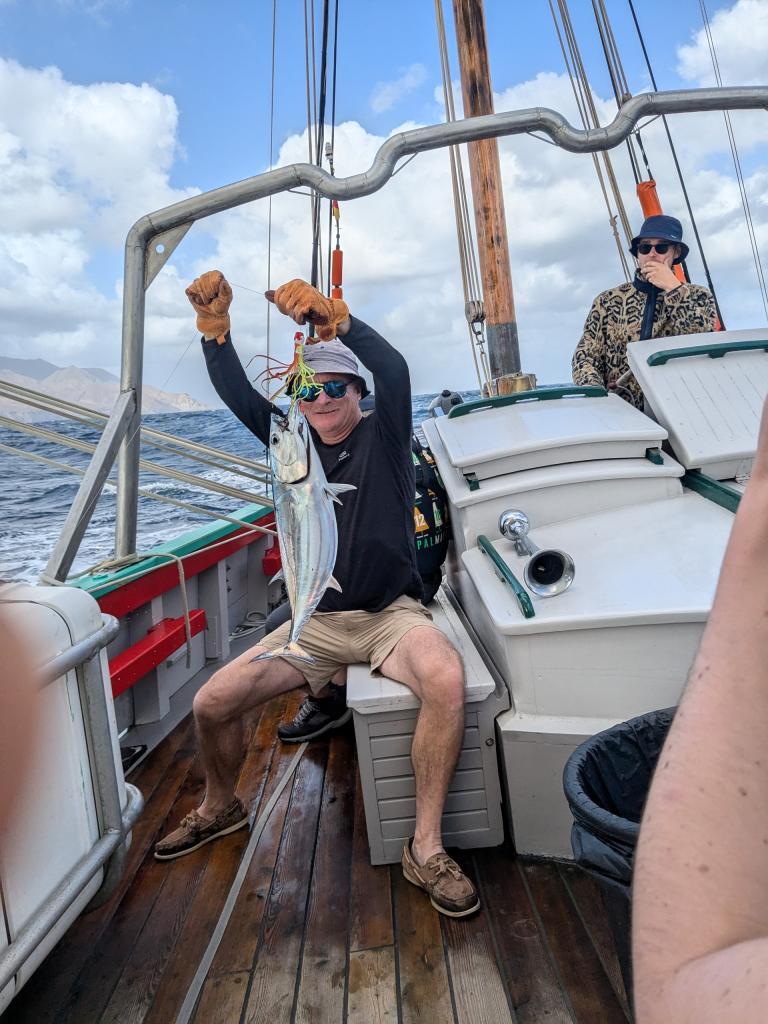
Sunday 22
The wind is still pushing the tuna boat at a good speed. The average is over 7.5 knots. The display often exceeds 8 knots and sometimes reaches 10, 11, or even 12 knots. As a result, we might arrive tomorrow in the middle of the day in Cape Verde. Nicolas has already sailed to Salvador on a catamaran and has also stopped in Cape Verde. He gives us tourist information on these two planned stops.
We will have a few days to enjoy the island before setting off again for the non-stop crossing to Salvador in Brazil for 2 and a half weeks.
It's Inès' birthday today! She was born in 1992 and is a merchant navy graduate. The captain popped the champagne corks in her honor! During the aperitif, a stronger wave copiously waters Thierry and Martine who confirm that the water is good!
All day long, the show is provided by the flying fish that can rise up to 2 m above the water and race for about ten meters. For what purpose? To get a little exercise or to escape a predator. Lionel does not think they are big enough to pass them in the kitchen.
Gusts of force 8 risk jostling us from 3 to 4 in the morning. The captain decides not to touch the settings so as not to slow down our progress. Vianney, the sous chef tells me:
The boat is capable of taking wind at force 8 downwind without taking in any reefs. But usually, the first reef is taken at force 7 and the second at force 8.
The end of our watch risks being tough unless we manage to escape this trail of a meteorological phenomenon on the North Atlantic.
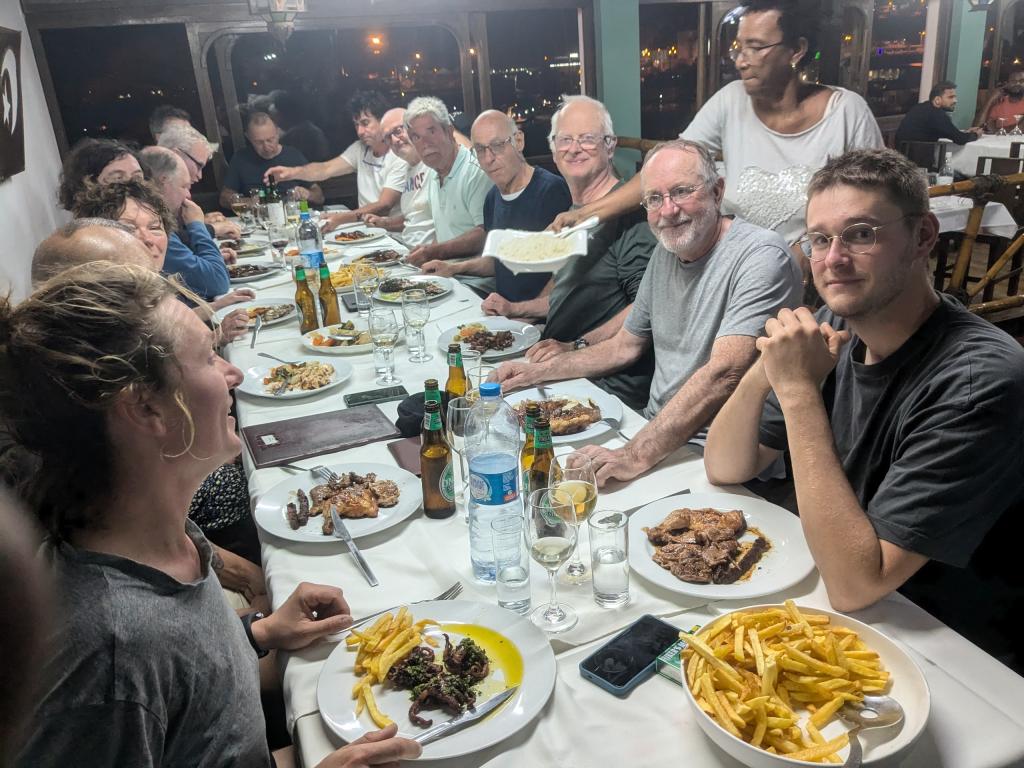
At the port of Mindelo in Cape Verde, the sailboats meet before the final burst of the transatlantic. They stock up on food and water for two or three weeks far from everything. Some are looking to regroup to sail together.
Children and parents come to greet us on the pontoon. These families have chosen to live on their boat and take their time to enjoy the happiness on the water. They left Brittany or elsewhere months ago. I see mostly ten to fifteen meter monohulls on the pontoon and a few catamarans anchored in the bay.
In front of La Nébuleuse, a child says:
That's a real boat!
We put in for 3 or 4 nights. On the program, restocking with food, water, diesel and if possible repair of the scuttle by a local sailmaker. But also cleaning the boat, showering, laundry, hiking, the beach, discovering this country and Christmas Eve!
Cape Verde is a former colony of Portugal that gained independence in 1975. The spoken language is Creole. French is understood by the population we met. To pay, no worries with our bank card and ATMs are ready to give us local notes.
We meet at the floating bar of the marina installed at the exit of the pontoon and having wifi. The esim card I bought on the internet does not want to work on my phone. Our neighbor tells us that he had a day of discouragement during which he had considered throwing in the towel to return by plane here. A discouragement shared in the more difficult conditions than expected due to the harsh weather conditions imposed by our navigation program constrained by dates. In principle, the rest of the navigation should be more pleasant in stable trade winds, confirmed by Windguru.
But the famous doldrums will still be a complicated obstacle with a total absence of wind and a variable sky that can be loaded with heavy black clouds falling in endless deluges, no longer knowing where the limit between water and air is, a pontoon neighbor who has made multiple crossings tells us.
But it is the sea that commands. We must remain humble, lower our heads!
For dinner, we are lucky to find a large table for the 15 of us in a brasserie grill with a spellbinding singer and violinist. Martine and I choose the octopus, roasted or grilled, but well cooked, and the papaya, a local product cousin of melon, with white wine from Cape Verde, which has a hard time competing with French productions. The pace is leisurely and good-natured. We have time to chat between courses. Gérard tells me about his adventures in Russia where he took the Trans-Siberian in another era, without war.
The sweet bill is shared between fifteen. Late at night, we find La Nébuleuse dancing on the water. The moorings are tightened so that Eric, who moves with a white cane, can climb onto the deck. The swell from the open sea continues to rock us gently for a night without waking up and without a watch.
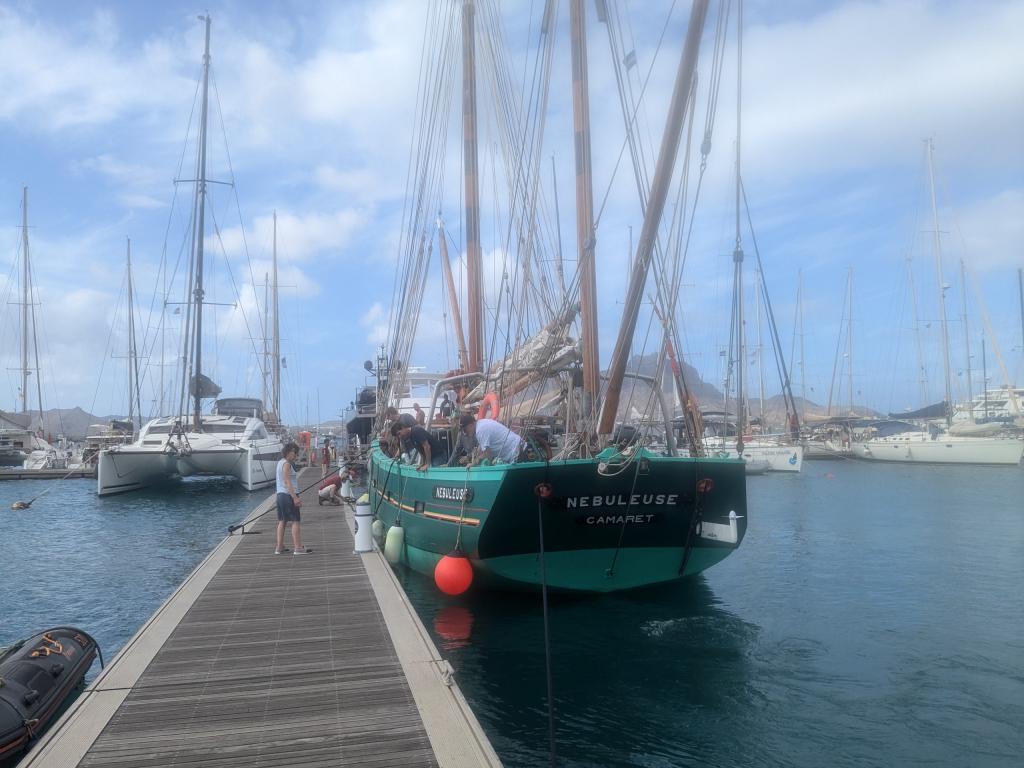
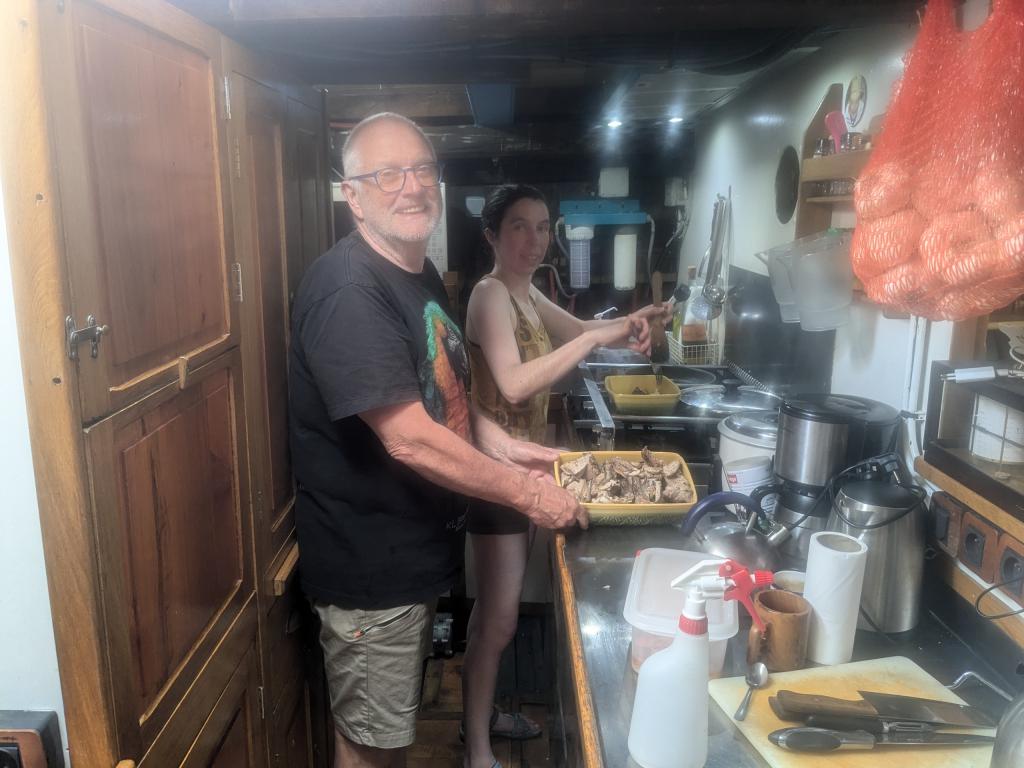

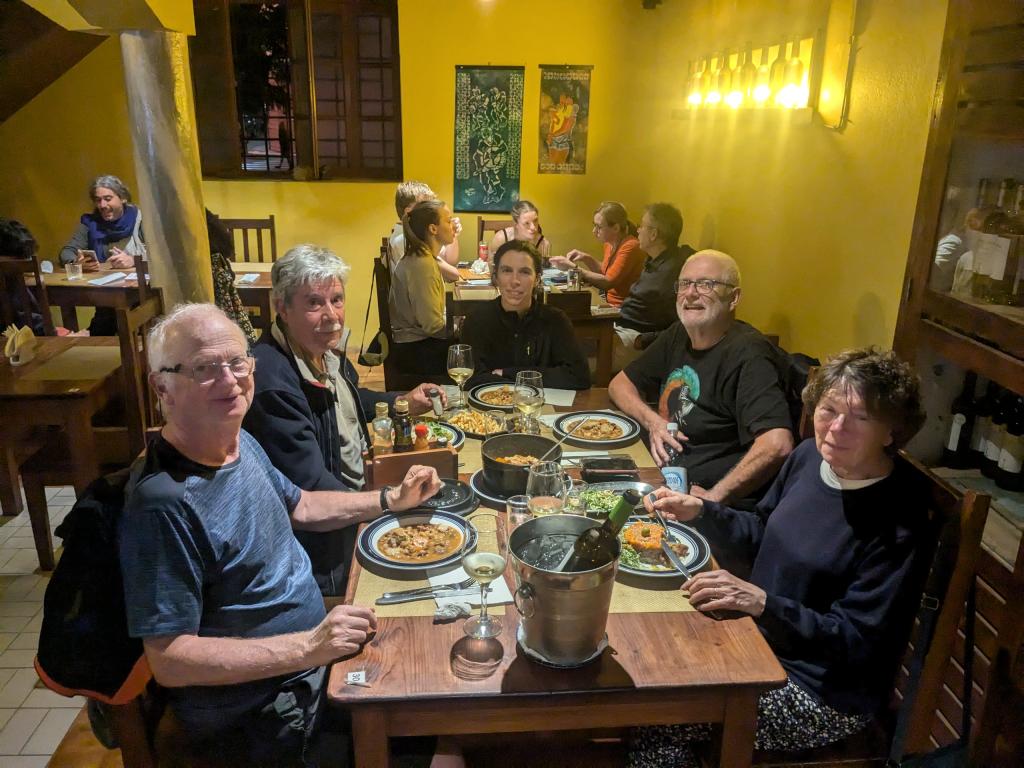
Monday, December 23
This morning, we relaxed, pampered La Nébuleuse, enjoyed refreshments at the floating bar, and toured the washroom facilities. While Martine strolled around, I took a closer look at the other boats that aspired to cross the Atlantic. Among the production boats, I noticed a Sun Odyssée 42i, an Allure 40.9, a Bavaria 38, and a Freedom 35.
In front of Ma'Na Xaa, the 1982 Gibsy, also from Paimpol, one of the owners told me about their life plans on this boat. For a budget of €80,000, they were able to fulfill a family dream by sailing across the Atlantic. The boat was also their home. The two forward sails were ready to be unfurled to take advantage of the trade winds. Even if the wind turbine failed, the two solar panels could provide electricity. I find the large aft gantry a little high, and the raised center of gravity could hinder the vessel's stability in heavy weather.
The Nébuleuse is the star of the pontoon. The other sailors stop and ask us, in particular, about the organization of life on board. The most delicate aspect seems to be the constant and prolonged proximity between 15 people who don't know each other before.
They also tell us about their dreams. One is going to Uruguay, another wants to sail up the Amazon and a river in French Guiana...
Arriving in Cape Verde, their dreams have already come true, with boats eager to cast off. They still experience a moment of grace just before the big jump and don't spoil their pleasure in sharing their enthusiasm with us. Some experience the best moment of their trip here on land, even if hardships await them offshore...
On our deck, we honor the beautiful bonito caught the day before. Since there were some left, I found an interested sailor who, in exchange, offered us a bottle of liqueur.
A SIM card reconnected us to the network, so useful for geographic information and communications with landlubbers, as well as for transmitting my story, written at night with a finger on my phone during my insomnia.
In the afternoon, we visited the small museum of Cape Verdean singer Cesária Évora, the barefoot diva, in reference to her habit of performing barefoot on stage. She lived simply in Mindelo and died in 2011.
Music is very present in the city. In the evening, singers and instrumentalists accompanied our dinner at the Nautilus Restaurant, which served us dishes based on local recipes. I ordered a cachupa, the national dish. White beans mixed with fish and other vegetables made their way onto my plate.
For now, the weather forecast still shows an ideal wind for the coming days: steady, moderate, and stable, blowing westward toward America.
If you can't find a doctor, try the vet! My favorite vet found a needle for mending sails in the ship's toolbox, which allowed him to remove a splinter from my big toe. It's best to take care of minor injuries before leaving.
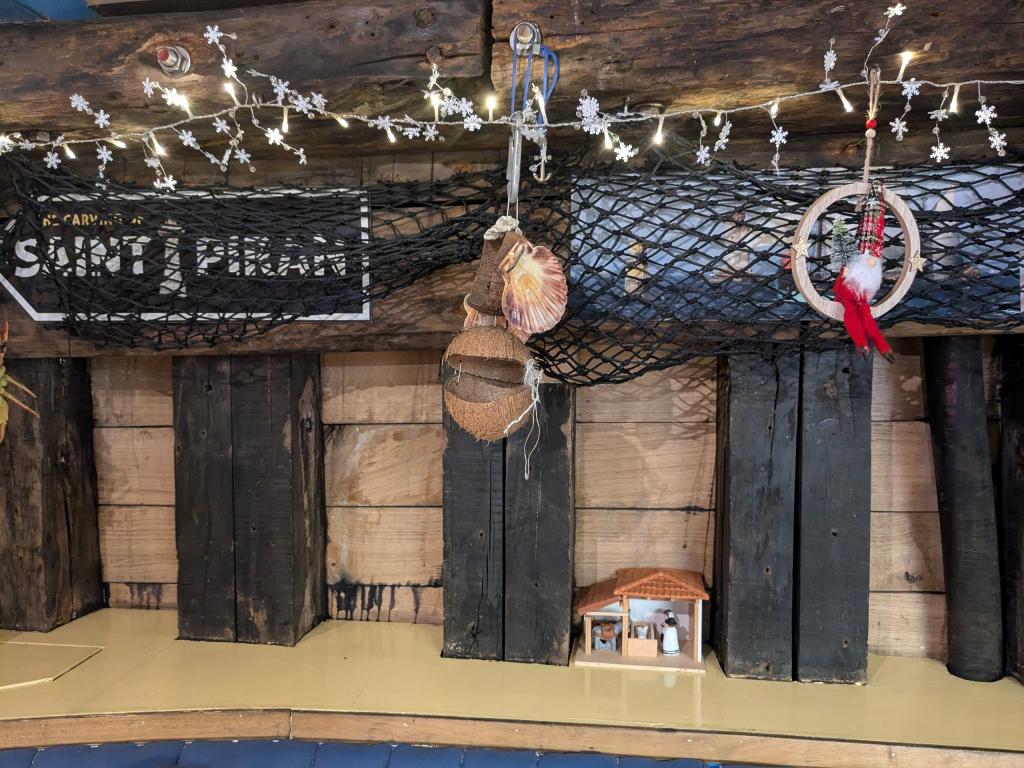
Merry Christmas
A sense of security reigns in Cape Verde. We walk around without feeling like we're putting ourselves in danger. Ophélie aims to climb to the top of the island, 10 km from here. Martine and I are aiming for an idyllic beach in the north with the promise of crystal-clear water at 24°C and a zephyr at 25°C.
This evening, Christmas will be celebrated with the whole crew. In the mess hall, Thierry has installed a string of lights, Nicolas a nativity scene found in the Canary Islands, and I hung a Santa Claus perched in a hoop. Martine has prepared little treats, and Cédric has chilled the champagne so we can properly celebrate the magic of Christmas, even far from our families. We've also found the times for the December 25th mass in this traditionally Catholic country.
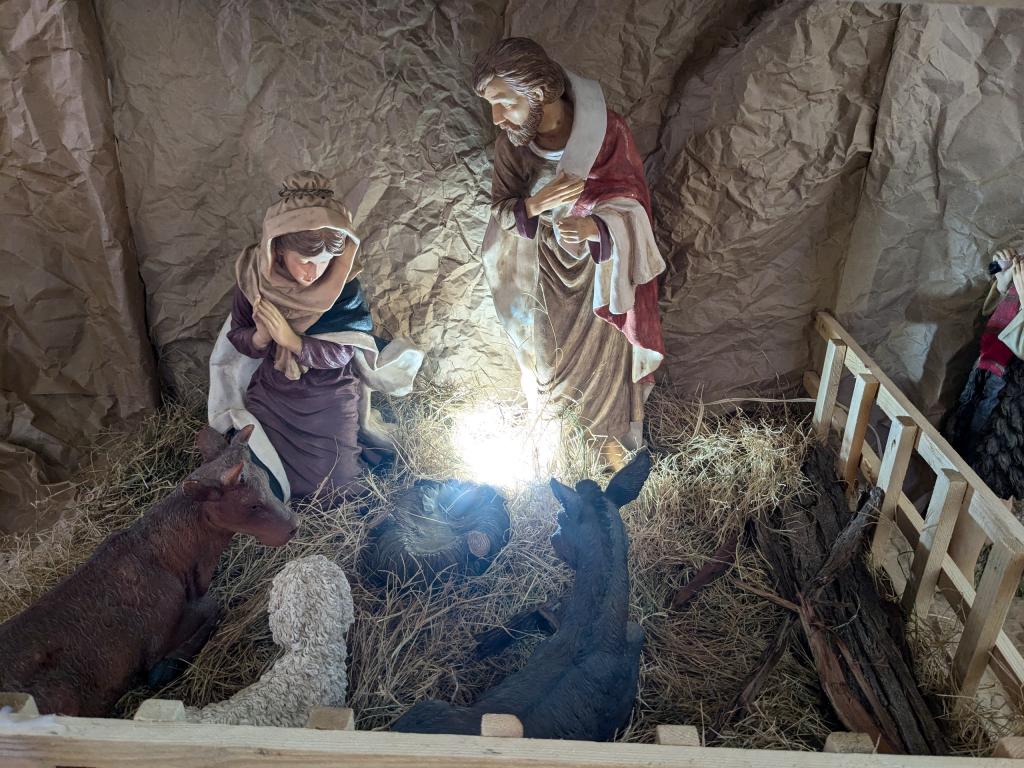
Therefore do not worry about tomorrow, for tomorrow will worry about itself. Sufficient for the day is the trouble of the latter. Matthew 6:34
Here and now. Simply take the path of life with confidence and enjoy every moment.
No need to know what tomorrow will be. It will be another story.
Let us distance ourselves from the sterile worries that seek to encumber us and distance us from the riches of life.
You may say:
- It's easy when everything is going well.
- It's the irresponsible attitude of the cicada that does not worry about the cold of winter
But who is happier
- the shoemaker or the financier.
- the little African who plays with an empty sardine can or the spoiled child who no longer knows which toy to take
- the spontaneous African who sings and laughs, or the one who wants to carry all the worries of the earth.
What a joy to go walking without worrying and to trust in destiny. It is sometimes harder, of course, but often it is the occasion for the most beautiful encounters with happiness.
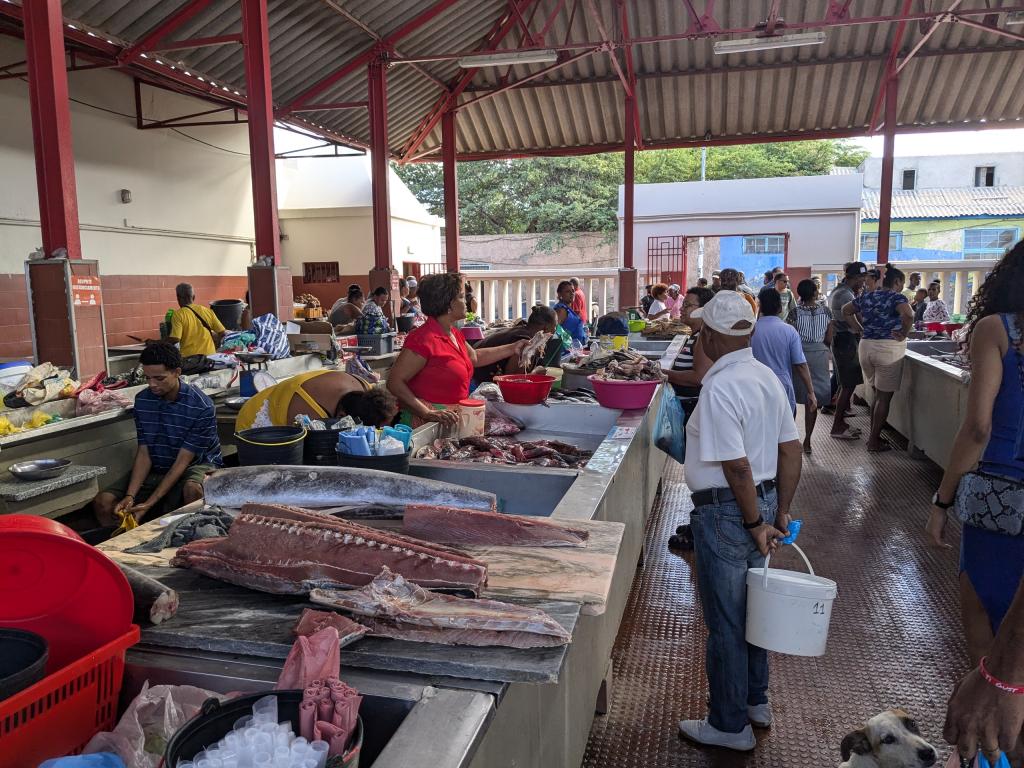
In the fish market hall, the women vendors shout at each other behind their stalls of fresh or dried fish while swatting away flies. In an adjoining workshop, men prepare the largest pieces. The market spills out into the side streets and joins the stalls of vegetables, clothes, bazaars and African art.
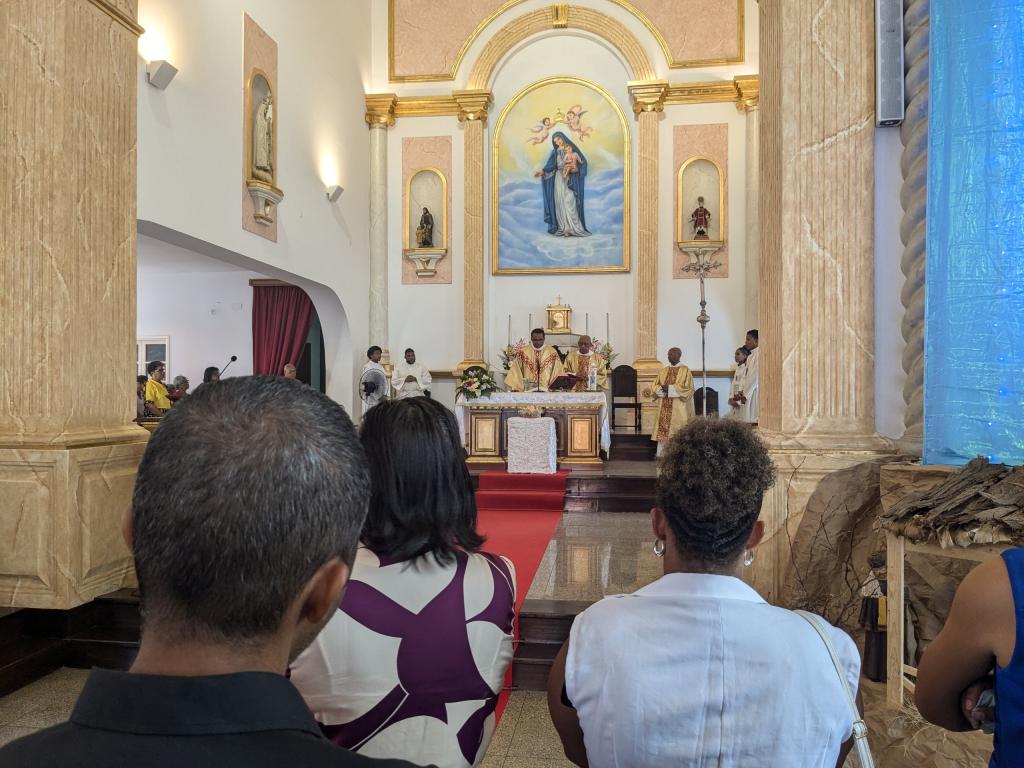
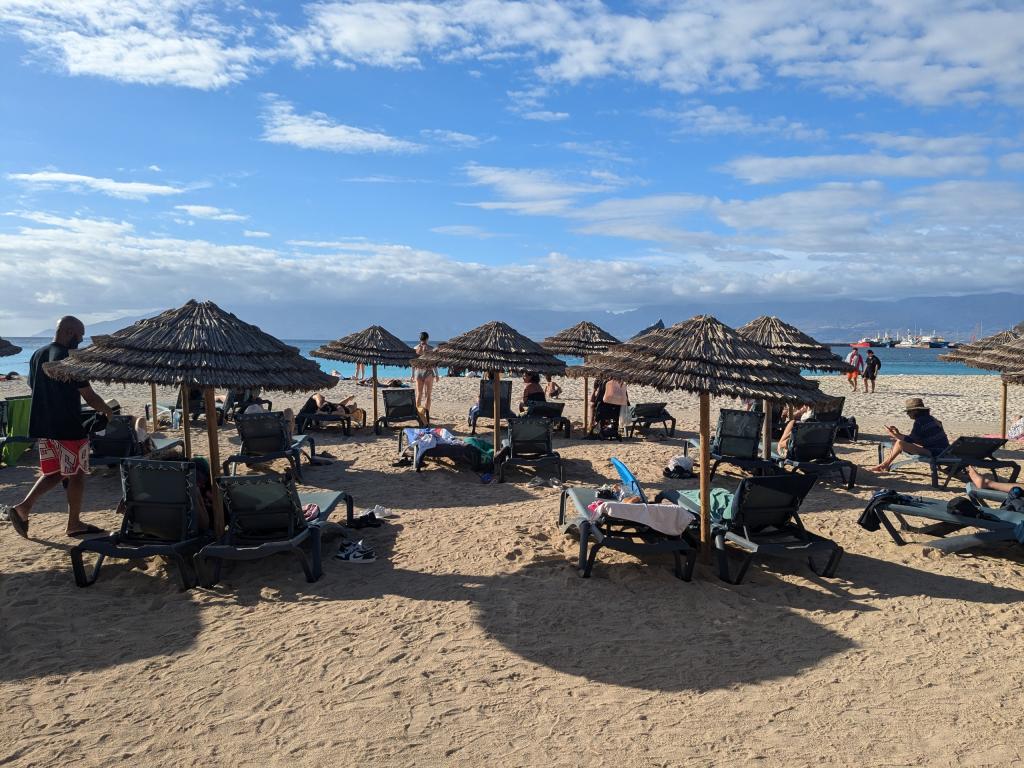
We swim with the turtles in transparent water.
They move lightly around us. With great ease, they swim in all directions, pushing on their 4 legs. Sometimes, they surprise us by passing us just below us. They let us touch their shell with confidence. From time to time, they stick their heads out of the water to breathe before diving deeper.
Other multi-colored fish complete this heavenly picture suggesting that living beings could live together happily and without fear. A great moment of our trip.
Sao Pedro in Cape Verde is an important nesting ground for turtles. As they are used to returning to lay their eggs where they were born, we can surely find them in front of the beach, especially since they are attracted by the pieces of fish thrown from our guide's boat while we swim with a mask and snorkel.
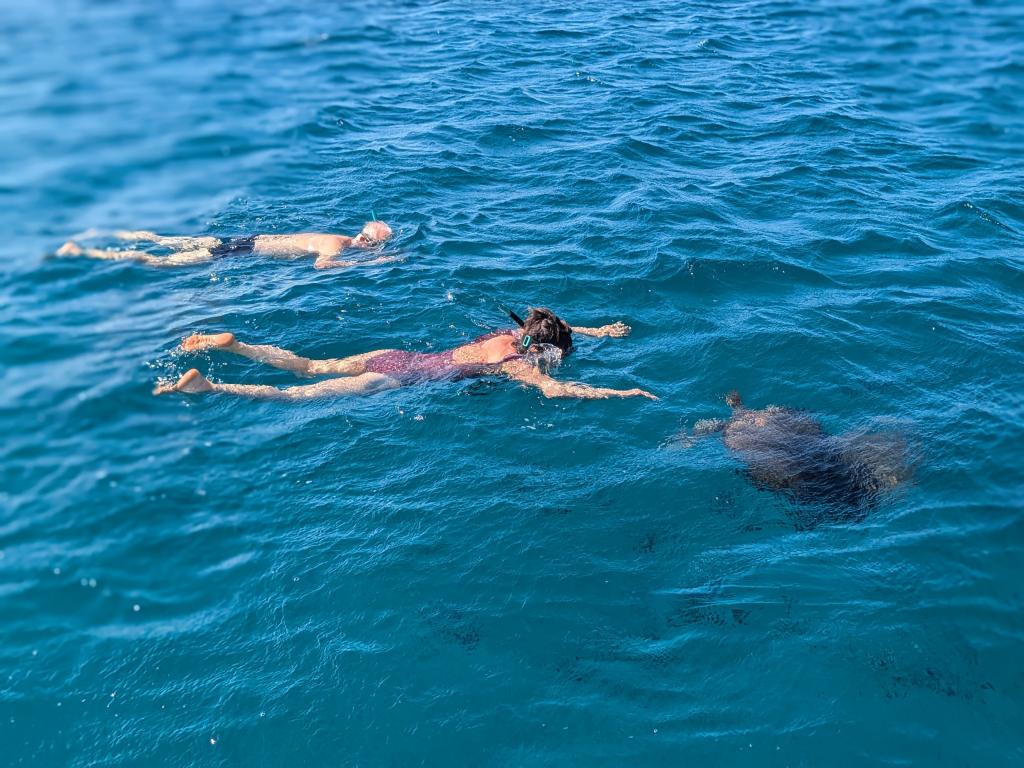
We swim with the turtles in transparent water.
They move lightly around us. With great ease, they swim in all directions, pushing on their 4 legs. Sometimes, they surprise us by passing us just below us. They let us touch their shell with confidence. From time to time, they stick their heads out of the water to breathe before diving deeper.
Other multi-colored fish complete this heavenly picture suggesting that living beings could live together happily and without fear. A great moment of our trip.
São Pedro in Cape Verde is an important nesting ground for turtles. As they are used to returning to lay their eggs where they were born, we can surely find them in front of the beach, especially since they are attracted by the pieces of fish thrown from our guide's boat while we swim with a mask and snorkel.
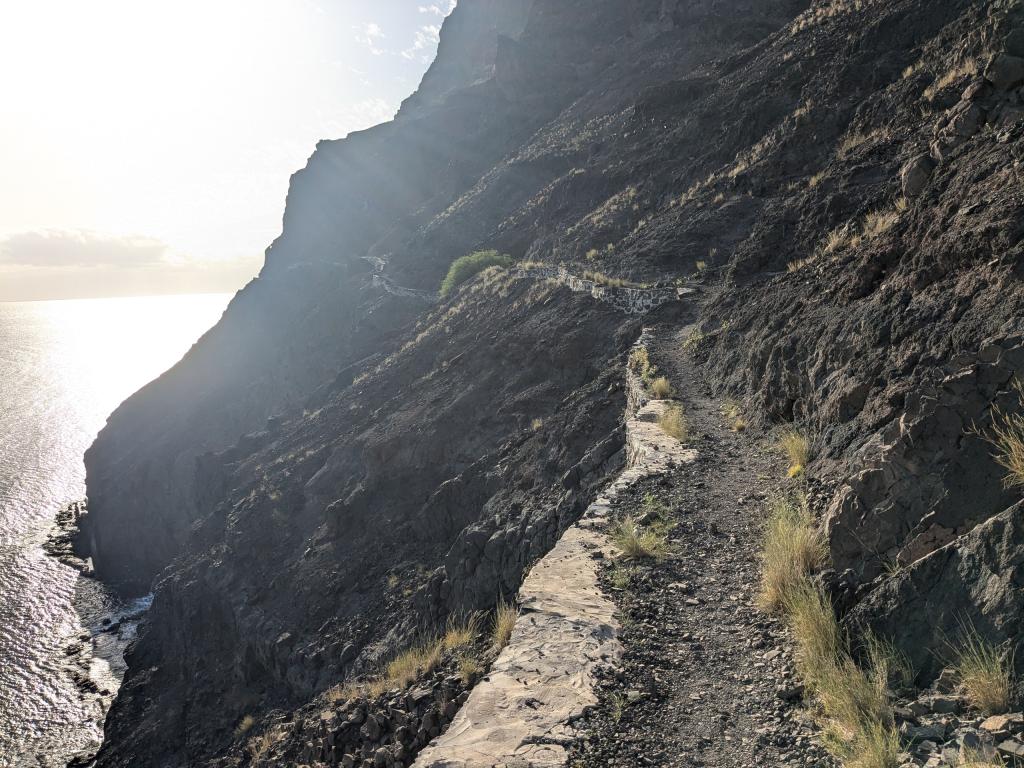
Walk towards the farol de Dona Amelia along a path carved into the cliff.
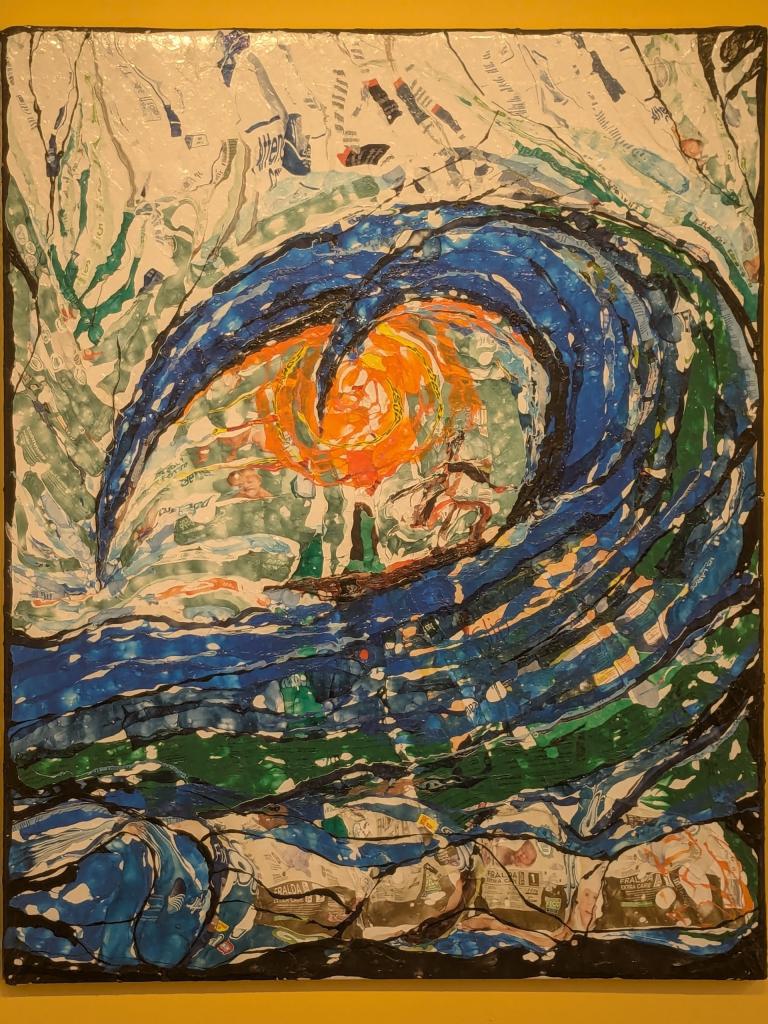
In the saloon, we watched two video projections:
. An old documentary on the transatlantic crossing of the Pekin, the largest sailing ship of all time. The conditions were particularly harsh and put our own difficulties into perspective...
. A presentation of the history of La Nébuleuse and its renovation commented by Cedric.
The name La Nébuleuse was chosen by the godmother of the boat in reference to the diffuse celestial objects playing a key role in the formation of stars and sending us beautiful nuanced images of the fuzzy depths of the sky.
We will probably leave tomorrow 28th or maybe even the day after tomorrow 29th without this calling into question our objective of arriving in Brazil in mid-January. It's a bit nebulous I admit!
The captain shared with us the starlink connection which will allow us to give news at sea.
So today, direction the Arts Center, then we will set off to discover the hidden treasures of our island. The painting above (collage made with plastic waste collected on beaches...) shows a wave awakening the atmosphere of a boat.
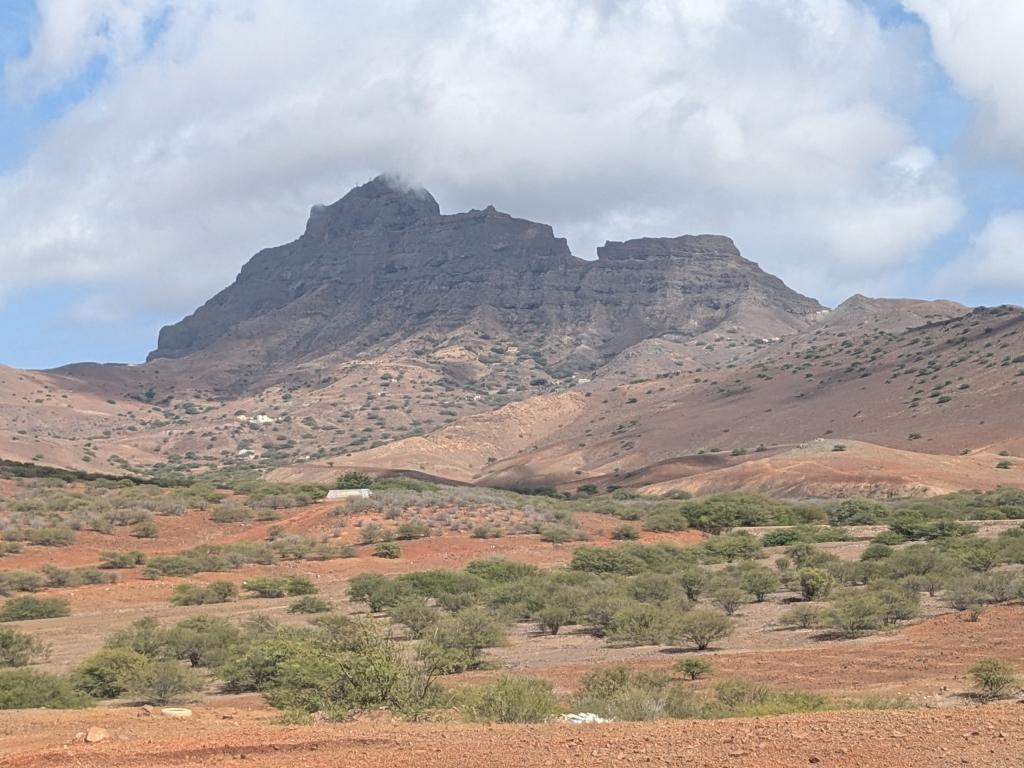
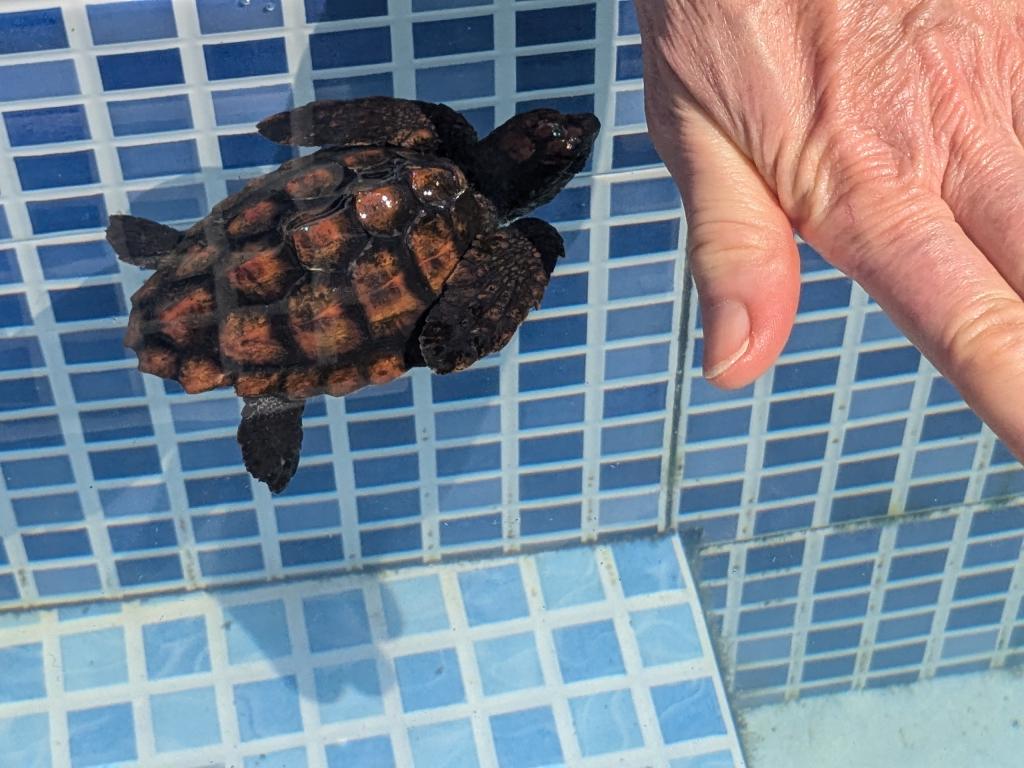

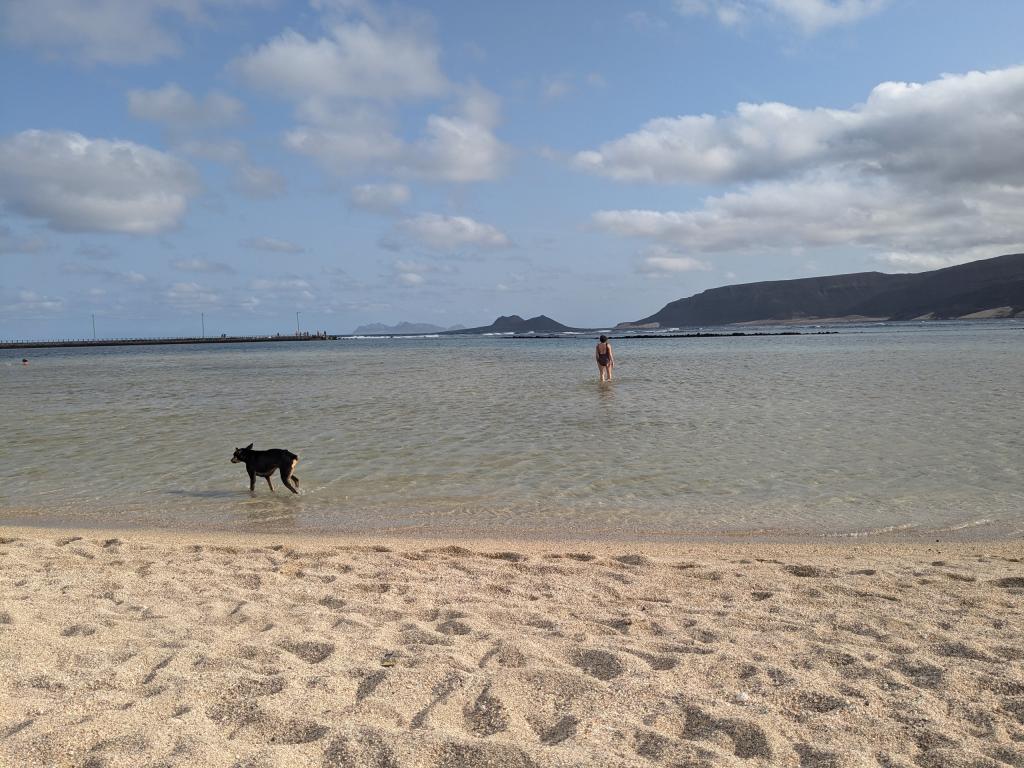
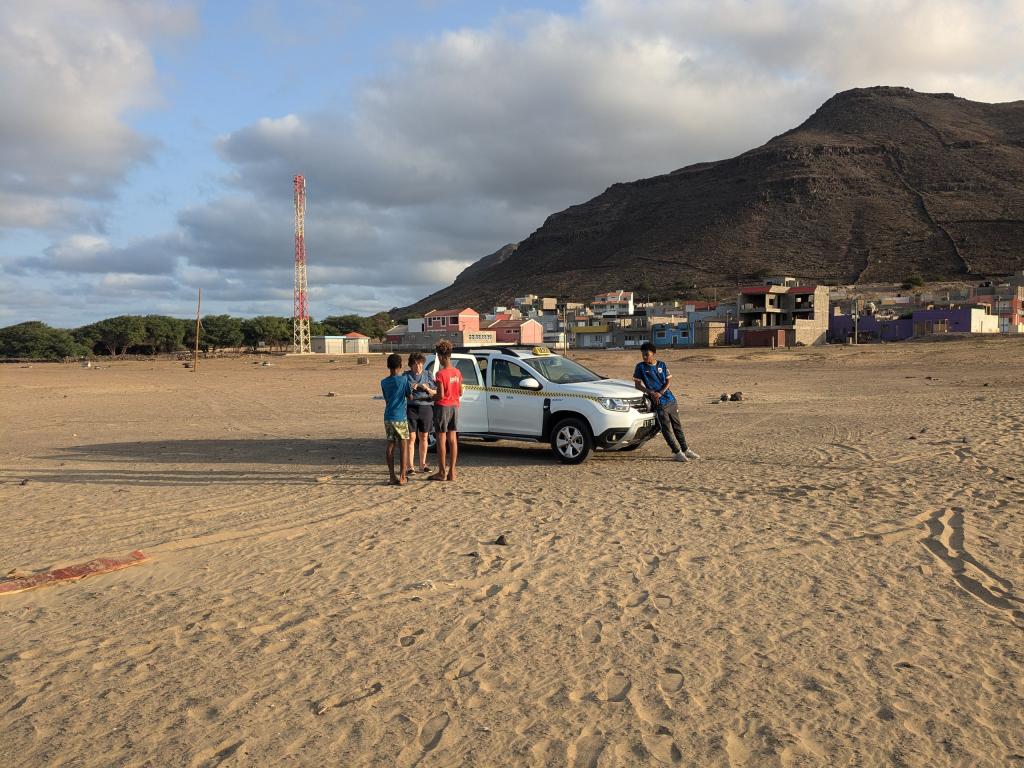

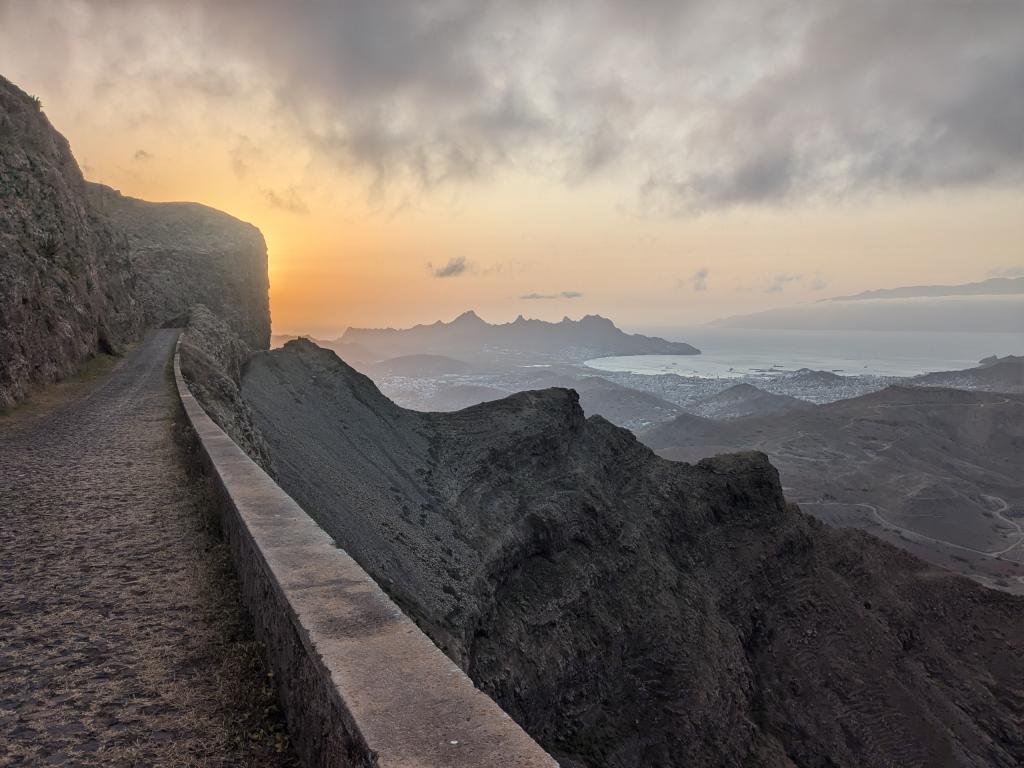
Adriel is a soccer player. He trains at 6 am every morning and plays left forward every weekend at FCF, the Mindosa soccer club. At 20, he gives his all to his passion. To make a living from it, he takes tourists around the island.
Today, Adriel has an appointment with the two of us at noon at the Tourist Office. In his car, we cross the island, passing south of Monte Verde, the peak that tries to catch the clouds at 750 m. Vegetation is sparse. A few blades of grass and a few stunted trees appear from time to time in this volcanic landscape. A dusty palm tree tries to play the proud.
In Caldau, we discover a turtle conservatory. Adriel is our guest at the small fishermen's restaurant before following the bends of the north coast. In Salamensa, we put on our swimsuits to walk in the Baia de Gatas, a natural pool connected to the ocean.
Then the Duster tackles Monte Verde from the north face to offer us a view from above of our island and the surrounding islands.
Wow, wow, wow. At night, without having asked for anything, we enjoy a musical concert that we listen to attentively lying in our bunk instead of sleeping stupidly. After this crazy night, maybe the Nebula will let us sleep this morning and set sail on its own for Brazil?

La Nébuleuse leaves the Mindosa quay at 9:15 am on December 28, 2024.
2,000 miles now await it to Salvador de Bahia for the longest crossing in its history.
Bureau Vallée arrived on the pontoon just before our departure. In the Vendée Globe race, it had to abandon and stop in Mindosa on the way back to France. At 18 m long, it is a large boat for a single sailor. We may come across other competitors on our route.
We pass small boats of local fishermen near São Pedro where we dived with the turtles. Their boat dances on the water without causing any balance problems for their owner.
With the Mercury effect, a stronger wind than expected makes the boat race in a flat sea. By steering at the end of the morning for an hour and a half, I record an average speed of 8.2 knots, a very good performance.
Showers are condemned. Fresh water has become the most precious commodity. It is reserved for drinking. Washing up is done in a bucket with sea water. Washing will also be done with sea water at the back of the boat or with a bucket of sea water in the bathroom. Rinsing with fresh water is tolerated with a supervised sprayer.
Nicolas is dragging a virus and is under treatment for 5 days. Martine wears anti-seasickness glasses as a preventive measure.
On deck, we are in T-shirts, sunglasses and hats. Martine and I turn our backs to the sun.
As a kitchen assistant, I learn how to peel onions on a boat. First, wedge a basin between your feet, then peel and cut as usual. Finally, send the chopped onions into the pan and the peelings into the basin which is emptied over the edge.
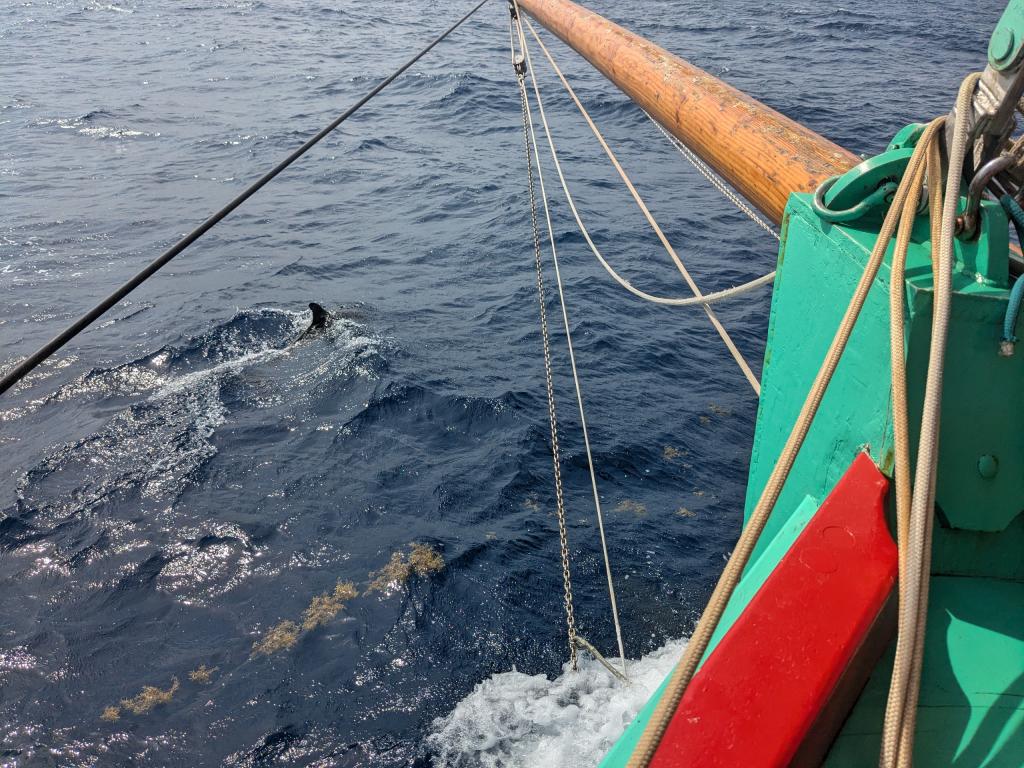
Sun 29 Dec
A normal day. The boat is moving on a course of 210 with a light wind and a calmer sea.
Laurent fished a transparent plastic bag. It is shaped like a small water bag like those that Africans use to drink water.
The pollution of the seas has not been very visible since we left. I have not seen any other plastic in the sea. Only a stray pallet came from human activity.
Probably, the pollution of invisible micro-plastics is also a problem here. These fragments of material torn from our clothes during washing come to disturb the environment of the marine world.
The overall impression is a depopulation of marine fauna mainly because of excessive fishing.
The calm on deck allows you to read outside without much risk of being showered by a wave.
I air The long road by Bernard Moitesier. The beginning of his round-the-world sailing trip in 1968 begins with a descent of the Atlantic. On a similar route to ours, but without stopovers, he describes comparable impressions. Since he goes much further than us, his book responds to my curiosity about what happens further away.
Bernard offers an explanation for the flight of flying fish.
They try to escape from the mouths of tuna. But their efforts are in vain, because the predator manages to catch them when they return to the water. A few turbulences and it's all over for the brave flying fish.
For the culinary side according to Bernard:
Flying fish is a choice dish reminiscent of the taste of sardines but more refined.
Grasshopper alert. Perceptive eyes have spotted a large grasshopper on the top of the mizzen mast. Then a second one in another part of the boat. Are we carrying stowaways who will multiply in Brazil and destroy a sensitive ecosystem useful for the health of the planet?
Ophélie joins our watch to observe the nighttime atmosphere in the different teams. As a result, Nicolas has found a metal playlist that provided the soundtrack for my turn at the helm.
To steer, I concentrate on the small magnetic needle of the compass while trying to stay glued to heading 200 tonight. The exercise prevents me from fully enjoying the spectacle of the stars, of Orion who shows me the right direction, of the Milky Way clearly visible now that the moon no longer appears in our nights. The Big Dipper is still visible behind us above the horizon. Shimmering dots that move, testify to the passage of planes that in about ten hours make the same journey as the Nebula in a month and a half.
I climb exhausted into my bunk.
It is 5 a.m. The wind has weakened too much. The sails are flapping in the wind. Vianney decides to start the engine to cross this calm, waking us up since our bunk shares a partition with the engine room.
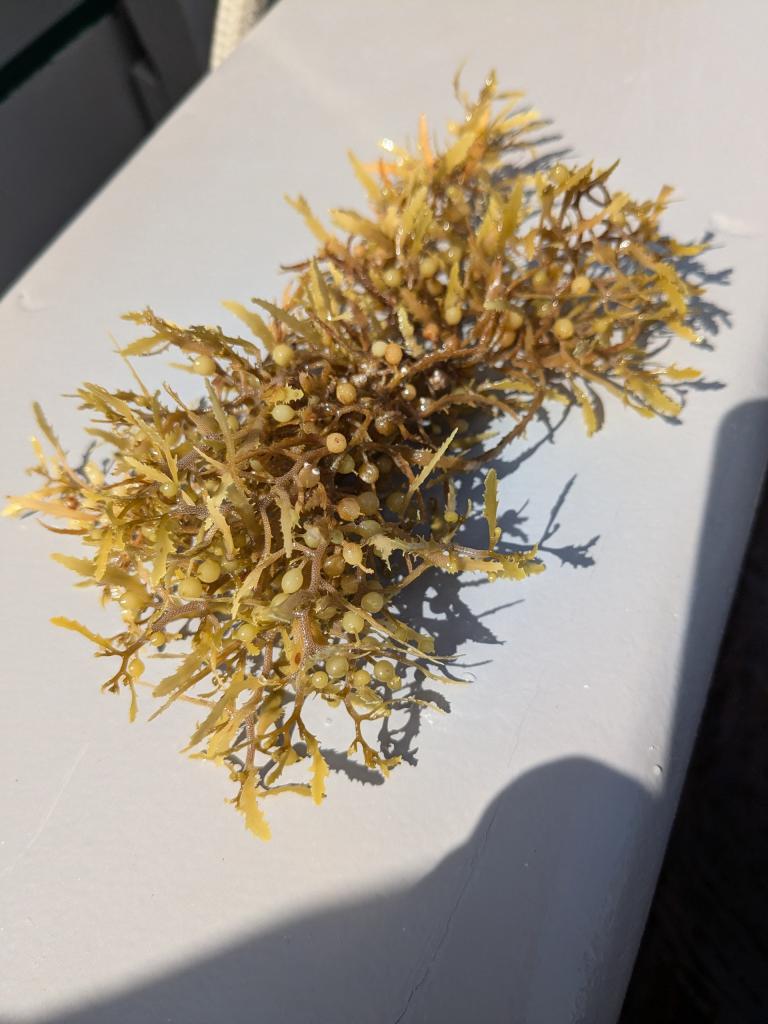
Monday 30th December
This morning, the steady trade winds are back.
Dolphin alert!
Dolphins are guiding us at the front of the boat. It's always a good time to watch their movements and their desire to get in touch with us.
Seaweed is floating in small bundles or in long processions. According to Laurent, it's Sargassum. I suppose it feeds the first links in the food chain.
Using the gaff, I fish out a small bundle. The plant is structured around a branch on which small empty balls are grafted that act as a float and hard leaves on which filaments are sometimes attached. They look very much alive.
The smell is that of seaweed, not making you want to serve it in a salad. In any case, Lionel, the chef, wasn't interested in it.
In Martinique, Sargassum has a bad reputation. It gives off a foul odor when it washes up and rots en masse on dream beaches.
At night, fluorescent flashes indicate the presence of plankton, the whales' favorite food.
A new ritual: 5 p.m. tea
Whale alert, whale alert! Abandoning books and kitchen knives, everyone rushes to the ladder to climb onto the deck.
About a hundred meters to port, jets of water shoot into the air. We make out a family of rorquals heading south, keeping a good distance from our boat. We follow each other for about ten minutes before they disappear.
We are overwhelmed by this encounter with whales. I had already seen them in Canada where you are sure to find them. Coming across them in the middle of the ocean is more impressive.
Midnight. The radio crackles in a foreign language and the radar detects an obstacle. But nothing on the AIS screen. We will have to be extra vigilant during our watch. Otherwise, steady wind and calm sea: the boat should stay on course. Dark night without a moon. The stars are present in the upper part of the sky. Clouds hide the lower part. Rain is not excluded and with it, a disturbance of the wind.
In our bunk, we were very hot, while on deck, the breeze cools us down. The heat could be difficult to bear in the next 15 days of sailing. We are progressing towards the south where it is warmer. The temperature should therefore increase gradually, while remaining bearable as long as we are on the water. In Salvador, I hope the hotel will be cool.
Navionics tells me that we are 1600 milles from Salvador in a straight line. The wind varies from 10 to 14 knots. The average speed over the last hour is 6 knots and we have covered 400 milles in 2 days and 14 hours.
At a low average of 5 knots or 120 milles per day, we should arrive around January 13 or 14 in Salvador. So we are on schedule. The unknown remains of the doldrums.
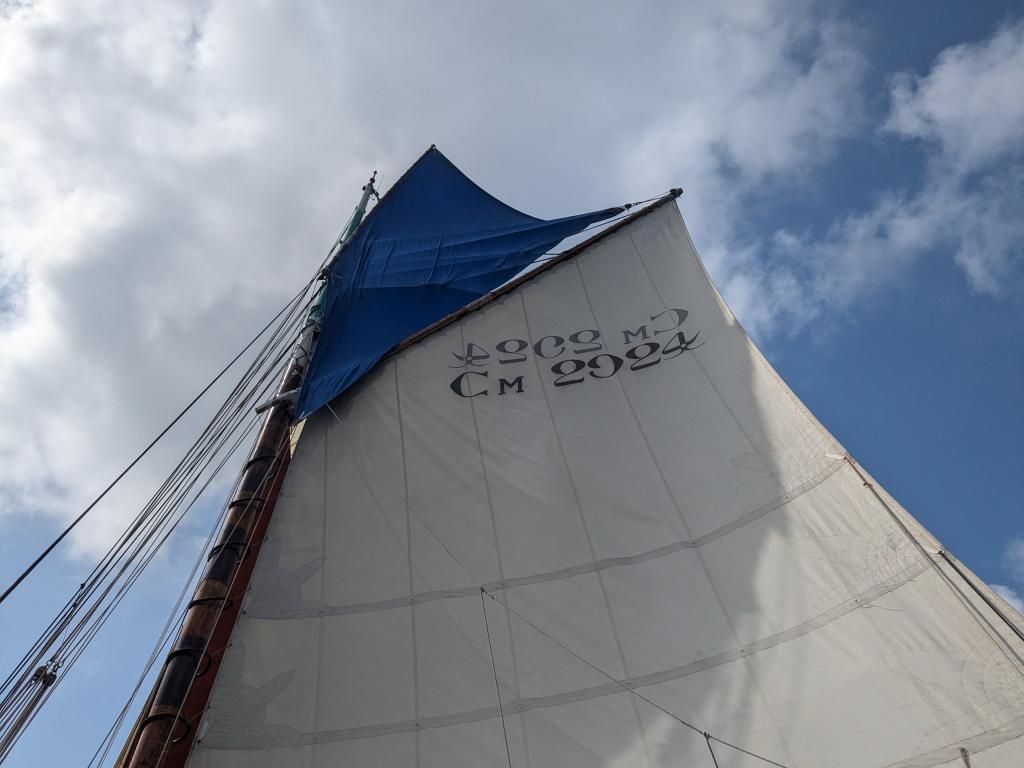
Happy New Year from the middle of the Atlantic
Ah, ah, ah. The mainsail creaks gently on the mast. The boat is happy to have found the wind again and to sail towards Brazil without being slowed down by waves.
At the end of our watch, the wind had dropped. Vianney had decided to start the engine again.
Today is the last day of the year. Martine and Inès are reviewing their cooking recipes to improve tonight's dessert.
Cédric will give us access to the internet so that we can communicate with land.
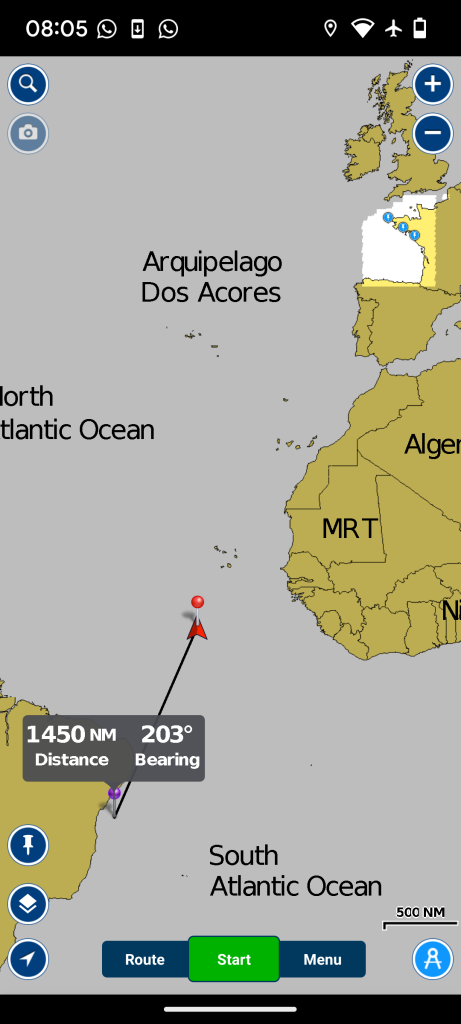
Position of La Nébuleuse on January 1, 2025. 1450 miles to Salvador
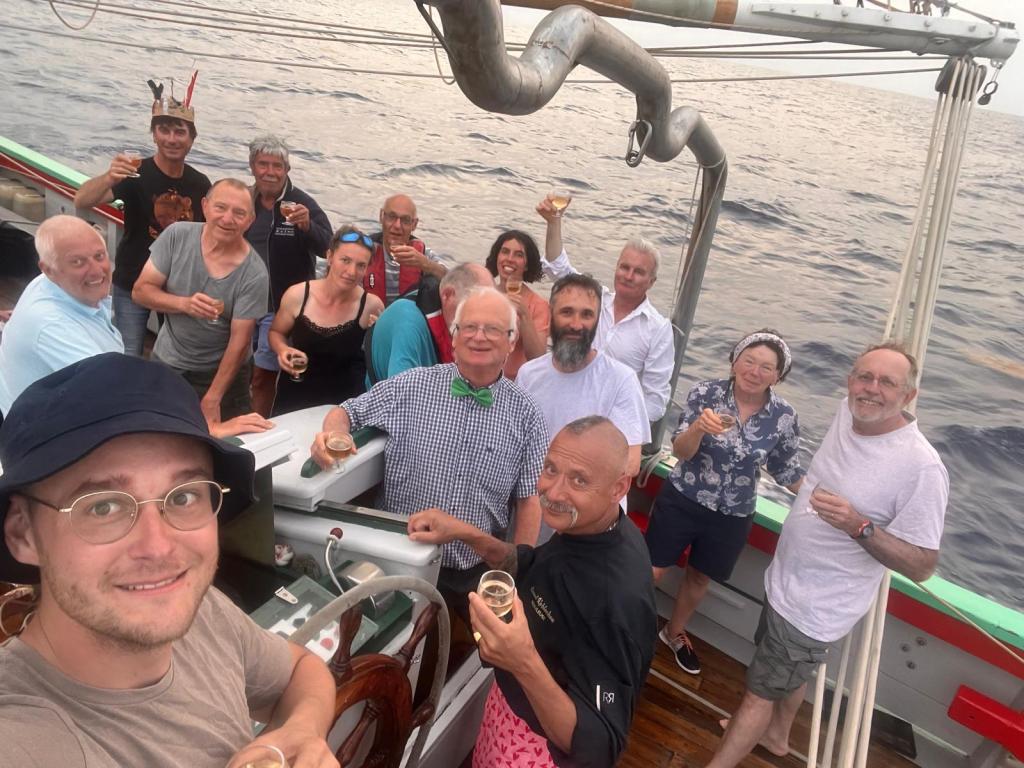
Bonne année depuis le milieu de l'Atlantique

1 Jan 2025
To celebrate the New Year, Michel opens foie gras, Cédric pops champagne corks, Lionel cooks duck confit with chestnuts, Martine and Inès make cakes and Gérard takes out a bottle of Lorraine mirabelle plums. A few fancy outfits and everyone is in a good mood, for a New Year's Eve that is out of the ordinary.
At midnight, French time, we wish each other a happy new year 2025 with loud blasts of fog horns that don't disturb many people in the vicinity.
The flying fish
I feel a slap on my back. I turn around and think I recognize the mainsail sheet. But a flying fish is wriggling at my feet and desperately trying to find its way back to the water. As I try to catch it with my hands to put it back in the ocean, it slips away from me several times like a sticky bar of soap.
I finally lift a trap door so that it can return to its natural environment.
I wash my hands with sea water and gel.
My T-shirt still has traces of scales that I take care to remove completely. But the fishy smell persists. I will have to use detergent to get rid of it.
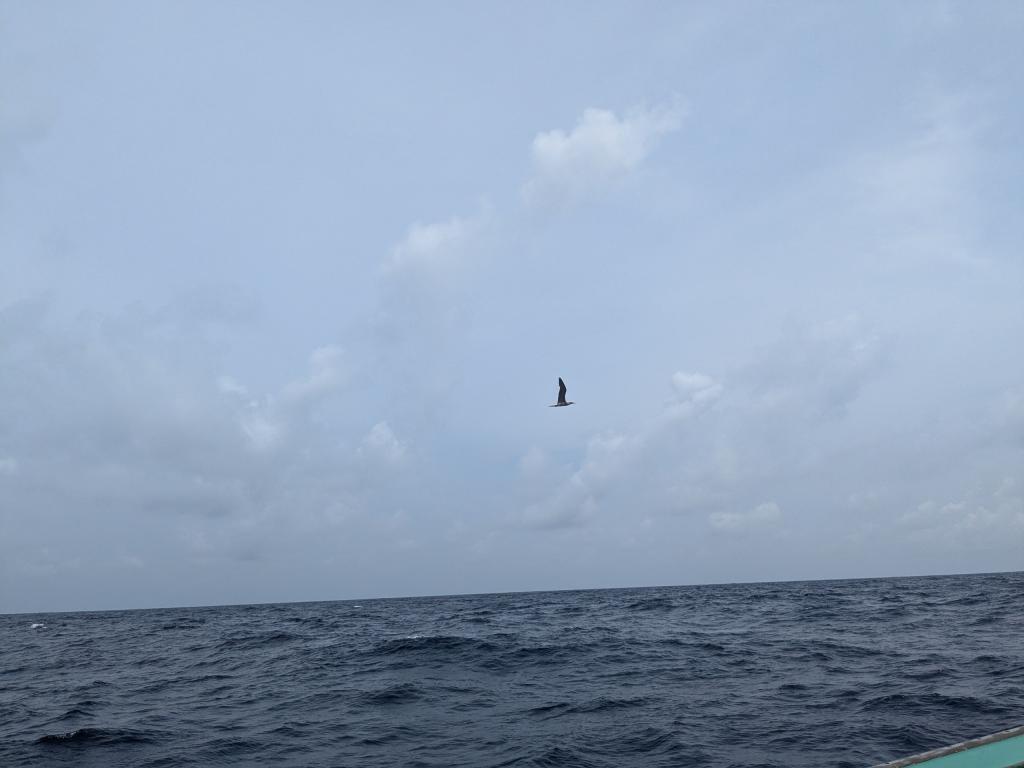
2 Jan
Baguette or croissant?
This morning, the right question is:
Biscuit marin or pain de sandwich oublié?
The biscuit marin is a thick, unsweetened biscuit vaguely reminiscent of the taste of bread. A choking-christian as Lionel says. Its advantage is that it keeps well on a boat.
Allusions to land-based food fill our conversations. Cooking the beautiful sea bream caught yesterday is on the agenda. Choices are made based on simplicity. Eating raw fish does not seem to appeal to André, the specialist on board! According to him, there is a risk of parasitosis, and the fish caught should be frozen to kill the worms.
We will follow his advice and in the absence of a freezer, we will cook the fish in the oven.
In the evening, the clouds darken in the wind. We can see lightning in the distance. We will probably have some atmosphere tonight.
Near the equator, the moon lights up from below and gives us the impression of smiling.
But then big black clouds veil its face. I can still make out it in a halo of light before it disappears. Disturbing flashes of lightning are already dazzling our route. Plunged into the pitch black, we expect the storm to unleash its fury at any moment. But at mealtime, everything is still calm before the storm and La Nébuleuse is all sails out. How will it react when gusts of wind try to destabilize it from all sides? Will it tilt until its sails get wet? Or even put its mast horizontally, and we imagine the mess in the kitchen and in our bunks...
We are sinking into the doldrums.
This intertropical zone has a bad reputation. It is known for its lack of wind, leading sailboats to remain becalmed for days and days. It is also subject to endless storms.
At 10 p.m., a first tropical downpour falls on the previous watch team.
As we take our watch, lightning and thunder join in the dance.
The instructions: no longer hold on to the shrouds and other ropes, move away from the mast, curl up into a ball, closing your eyes and ears.
So we sit in a ball, protected from the thick rain by our watch jackets. We humbly witness the unleashing of the forces of nature.
The lightning flashes illuminate our entire environment for a moment. A sparkle crackles in the distance. Sometimes like a rapid vertical flash, often in successive jerks with horizontal effects. I prefer those that light up the scenery from the side. From the front, they are dazzling. Another request is that the lightning lasts a little longer so that the eye can get used to the lighting and I can better perceive the landscape.
We rarely hear thunder, which tells us that we are still far from the center of the game for the moment. The speed of sound is 300 m per second. It therefore takes about 3 seconds to cover a km. By dividing the seconds between the lightning and the thunder by 3, we get the distance of the lightning in km.
After a nearby flash, I think I smell something burning. But Martine does not share this impression.
Two points of light appear on our horizon. The AIS tells us that they are 2 cargo ships 200 m long. They are not yet the first Vendée Globe competitors on the return route.
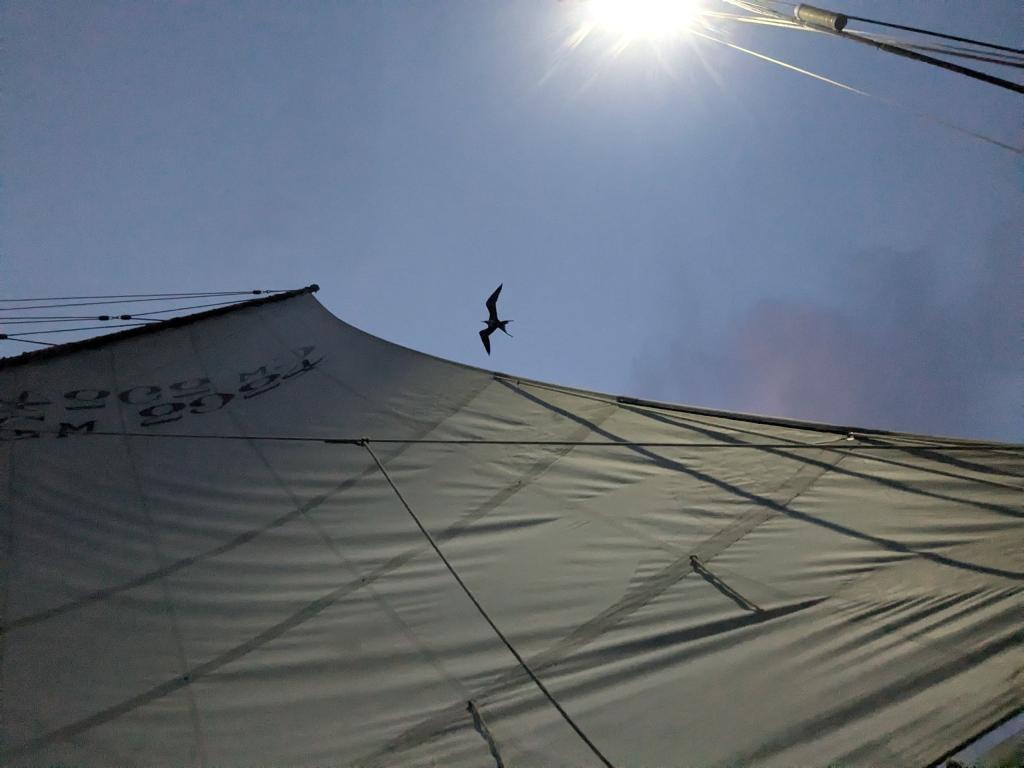
3 Jan
The archipelago of São Pedro and São Paolo emerges far to our starboard side. We pass at a respectful distance these rocks set in the middle of the Atlantic while the surrounding seabed is 4000 m deep. 4 humans live there.
The booby and the frigate
For a few days now, a booby has been following the boat. He certainly thinks he is increasing his chances of finding fish.
He spends his time fishing. He makes circles in the air, and suddenly swoops down and dives into the water. He has become our mascot.
But danger threatens him: a large black bird with a forked tail has joined him and is circling around him. It is a frigate that makes beautiful convolutions around the boat.
When the booby has found a fish, the frigate rushes towards the booby with aggressive cries. The brave fool tries to escape by flying right, left, dives again, takes off again with renewed vigor.
When the frigate flies off alone again, we know that it has recovered the fool's catch. Without any complexes, it flies back proudly around the boat as if it were strutting proudly to be the queen of the sky.
The fool persists and resumes the hunt, hoping that the frigate will not steal its booty next time.
At sunset, the frigate approaches the top of the mast, probably to rest and spend the night there. For long minutes, it is one leg away from landing. With the swaying of the roll, it must estimate the uncomfortable position and ends up flying away.
During our night watch, we listen to the "French songs" playlist in T-shirts. With a light wind in the nose, the boat advances with the engine under autopilot in a dark night.
Around 2 am, without warning, the air suddenly cools and the wind increases.
30 seconds later, drops start to fall and quickly a nice downpour falls on our heads. It is our turn to experience a squall in the doldrums.
A few drops are pleasantly refreshing under the equator. But under this fresh rain, the position is not tenable. While I go down to get our boat jackets, Martine is already transformed into a soaked mop. The rain hits us horizontally for a quarter of an hour and then I do it again one last time.
With our heads curled up under our hoods, we resume listening to the best French songs. When we go down to join our bunk, we are soaked to the bone and the air is cooler. We have to dry ourselves as if we were getting out of the shower. In the morning, I discover that my life jacket has been hit. Did it swell due to the intense humidity or from a shock when putting it back on the coat rack?
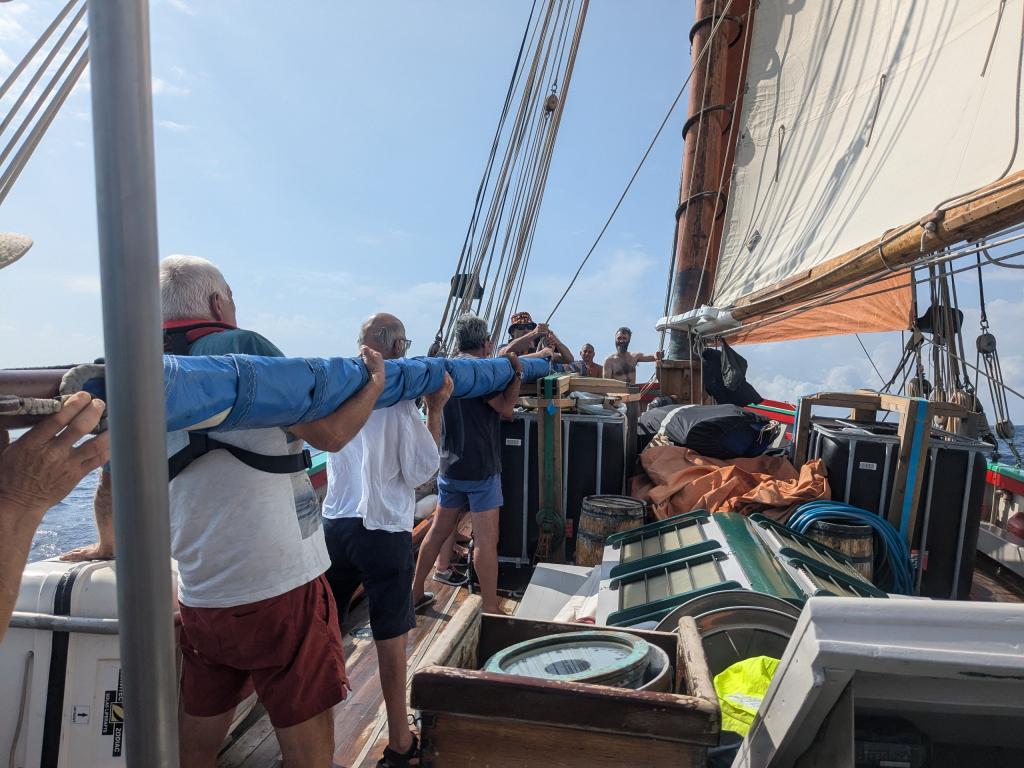
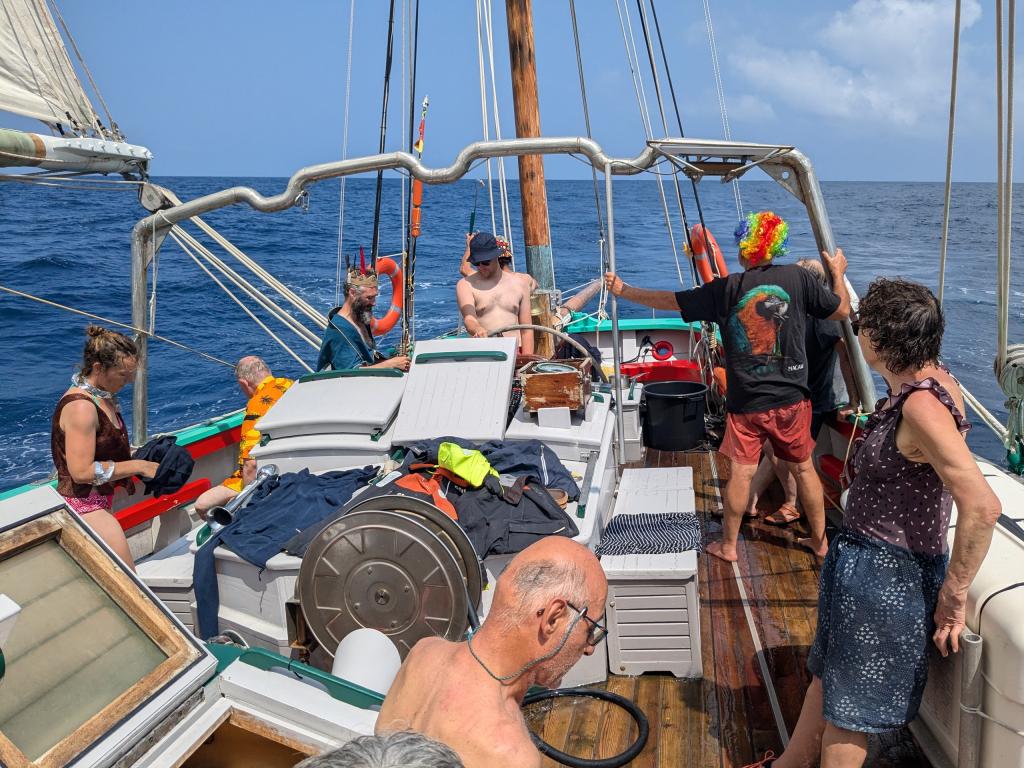
4 Jan
Crossing the Equator
At 10:15, La Nébuleuse crosses the Equator to the cheers of the passengers.
Poseidon, the god of the sea, baptizes the passengers of La Nébuleuse who are crossing the Equator for the first time
Animated by Titi wearing a wig and given the title of Monsignor the Bishop, Nico with feathers on his head playing the role of Poseidon and Lionel with a bucket in his hand guardian of order and terror, the ceremony does not follow strict rules and is left to the discretion of the dignitaries.
In this case, Titi has the art of staging and without pretension, exhorts us to recognize our errors. Poseidon absolves us and asks us to bow before him. At this point, Lionel pours a bucket of sea water on our heads as a surprise. Depending on his mood, he adds a second one. And of course, it all ends with new bottles of Champagne!
A bird the size of a dove approaches and lands on the Starlink antenna, squawking, not at all impressed by our proximity. It is a brown noddy, a cousin of the terns that frequents this area according to our guide on the phone.
During the night watch, three other noddies join the boat. One lands on the tip of the malay tail, another on the anchor and the last one still circles the boat.
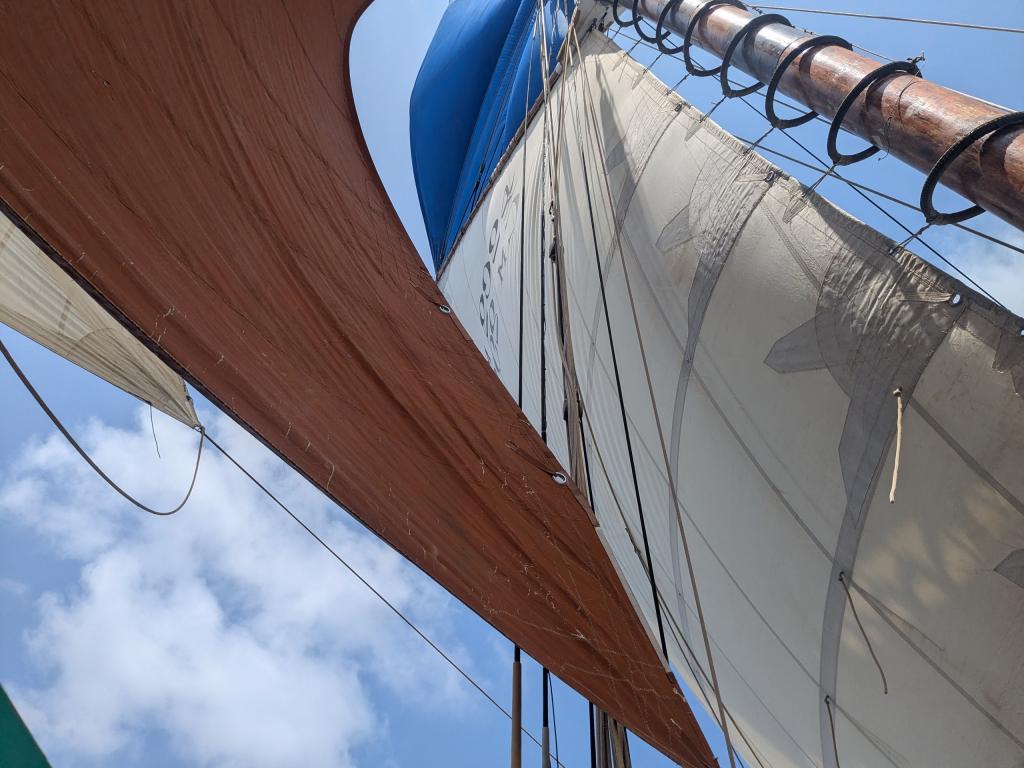
Sun 5 Jan
Arrival in Salvador could be as early as 10 January according to the navigation software. We therefore have 4 nights left at sea. The night watch remains a difficult time. It falls right in our deep sleep time. Despite getting used to this rhythm for 35 days, we continue to fight against sleep. I like steering. But we are happy when the relief comes up on deck and we can hoist ourselves into our bunk.
Orca alert
Two orcas pass on our port side. They are easily recognizable with their black color and the large spot underneath. A large one and a small one, probably a mother with her calf. These have not been trained to make big jumps in front of us and barely cast a curious glance in our direction before continuing their way towards the middle of the ocean.
Maybe they'll see the family in Spain who will tell them about the new game that consists of nibbling on the rudder of sailing boats.
Orcas can be a danger for a small boat. On La Nébuleuse, don't worry. Its 90 tons launched at 8 knots make it too big an opponent for the much too small orca.
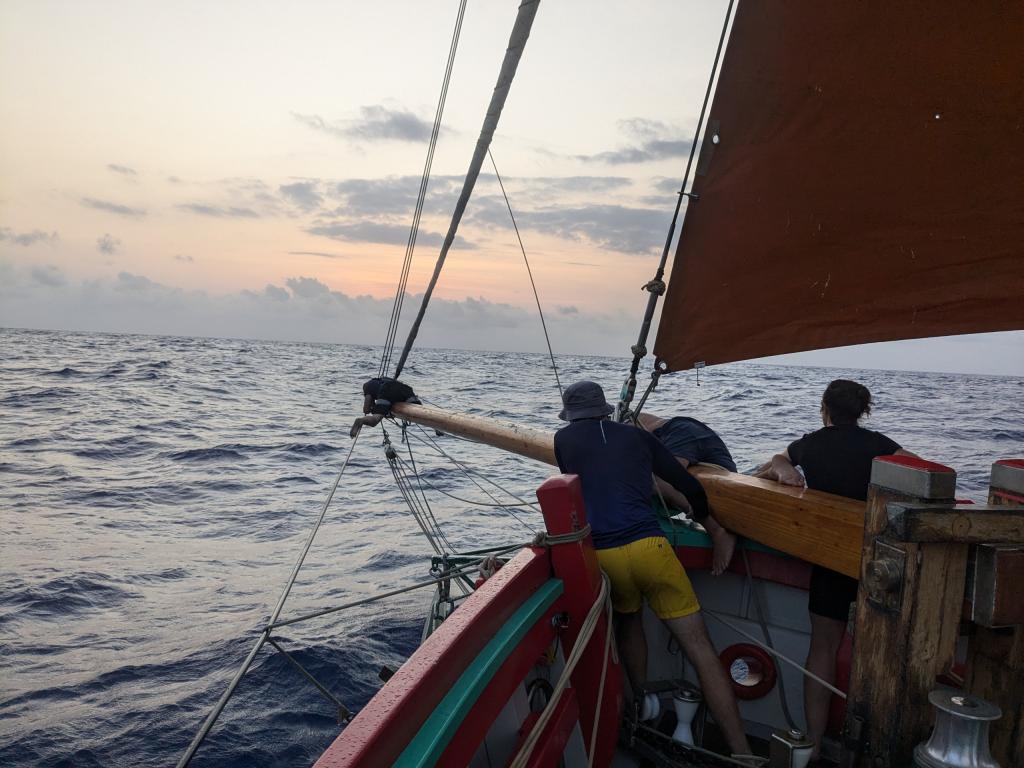
6 Jan
The boat's siren sounds and calls everyone to the deck. As I pass the navigation screen, I see that the boat is on a collision course with a cargo ship coming from the south. And already the Nebula is moving away from it and bearing away 20 degrees.
Arriving on deck, I learn that the emergency actually concerns the under-beam which has suddenly given way. Slightly over-canvassed, La Nébuleuse is testing its fragility.
As everyone knows, the under-beam holds the bowsprit down to balance the force of the forestay which pulls the bowsprit up. The bowsprit is the wooden shaft which extends 5 meters from the front of the boat and allows the sail area to be increased.
Vianney gives orders to quickly furl the main jib which is pulling on the weakened bowsprit. The boat's speed immediately slows down.
The best experts of La Nébuleuse are summoned to the bow. Tools are gathered. The boat bears away again to find a comfortable pace. The man-overboard buoys are ready to be launched.
Like a tightrope walker, Vianney slides along the bowsprit to the forepeak. The crew's eyes anxiously follow the long repair above the sea at the end of this axis that rises and falls in the waves. The wrench escapes and heads towards the depths at 4000 meters. Evening darkness sets in.
Night begins to fall when Vianney returns safe and sound to the hull. The repair is successful and a pulley has been changed. The main jib is relaunched. La Nébuleuse sets off again in earnest towards Salvador.
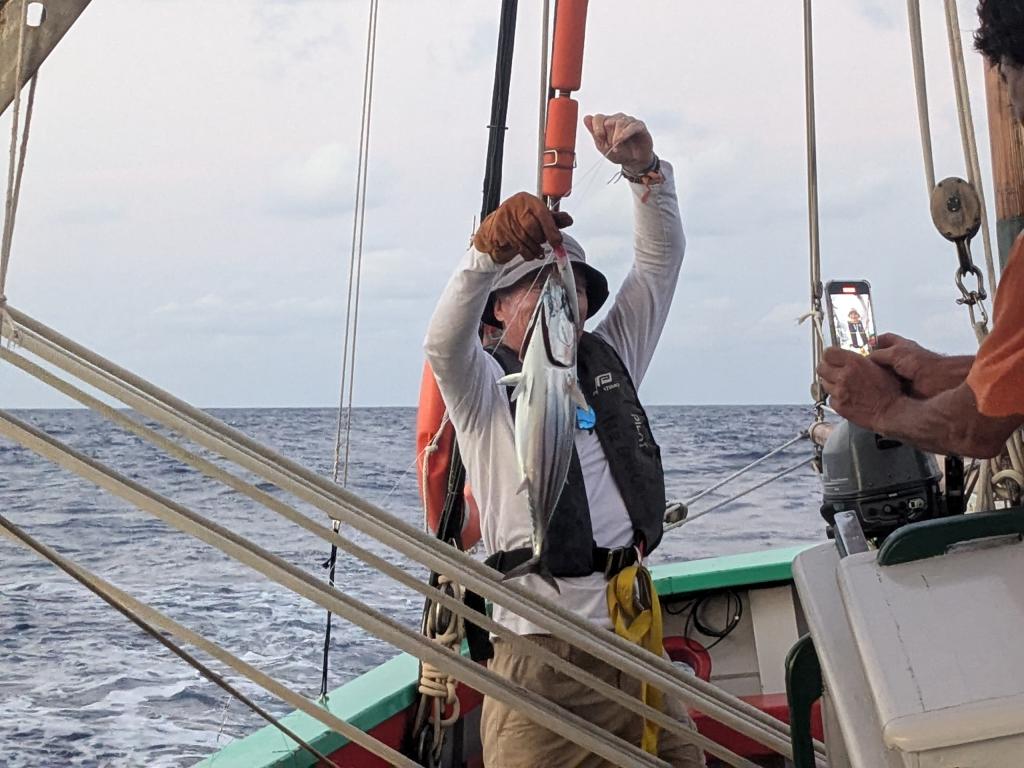
7 Jan
We don't see land yet, but we can feel it. More numerous birds come to meet us as ambassadors and different cloud formations to the west hint at a harbinger of land.
A group flight of about ten ducks passes near us. At the same time, the two trolling lines tighten. Laurent and André bring up two beautiful bonito with the joyful prospect of varying the menu. The ducks move away to follow the school of fish.

8 Jan
No more water at the tap.
Our watch team is doing the dishes tonight. Nicolas is rinsing the rice pot when the tap runs dry.
The boat still has water reserves in secondary tanks. The transfer is not done automatically and the complex manipulation is postponed until tomorrow when it will be light.
For the moment, everyone drinks the water remaining in their water bottle. But no more tea and coffee at breakfast for the early risers.
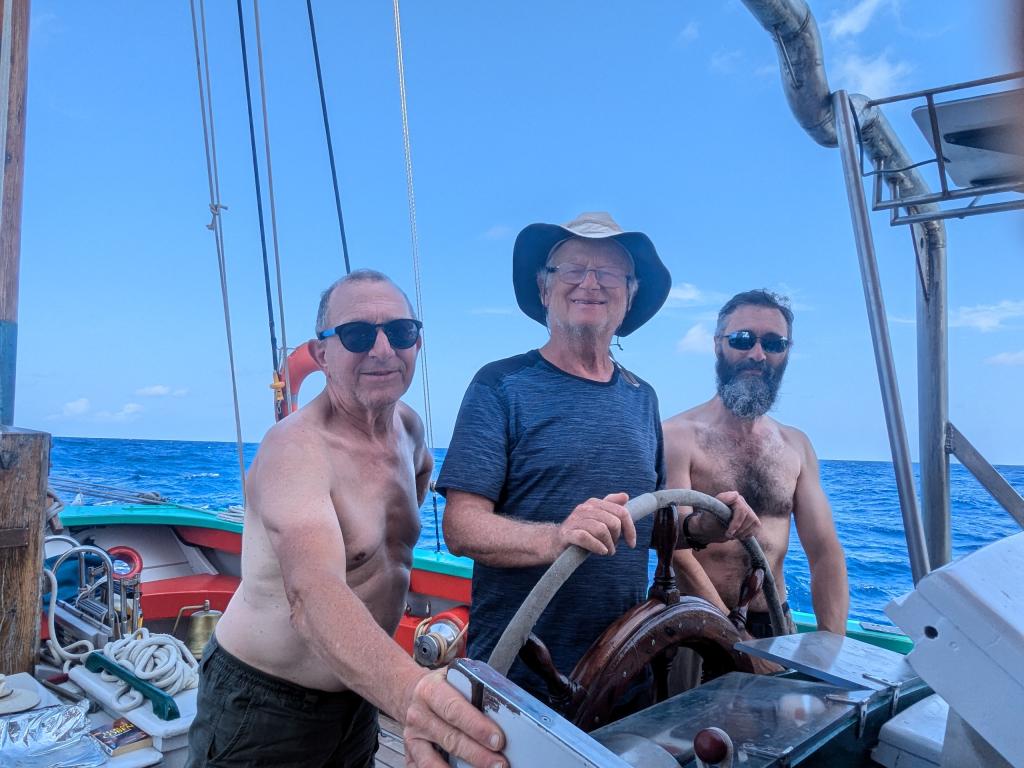
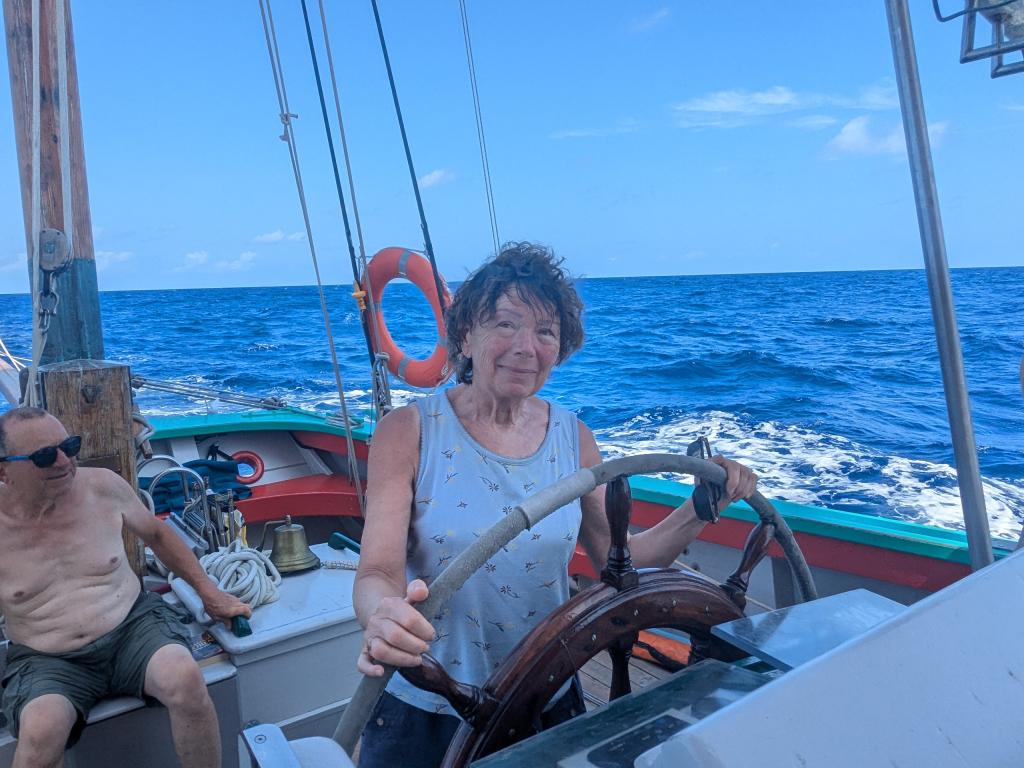
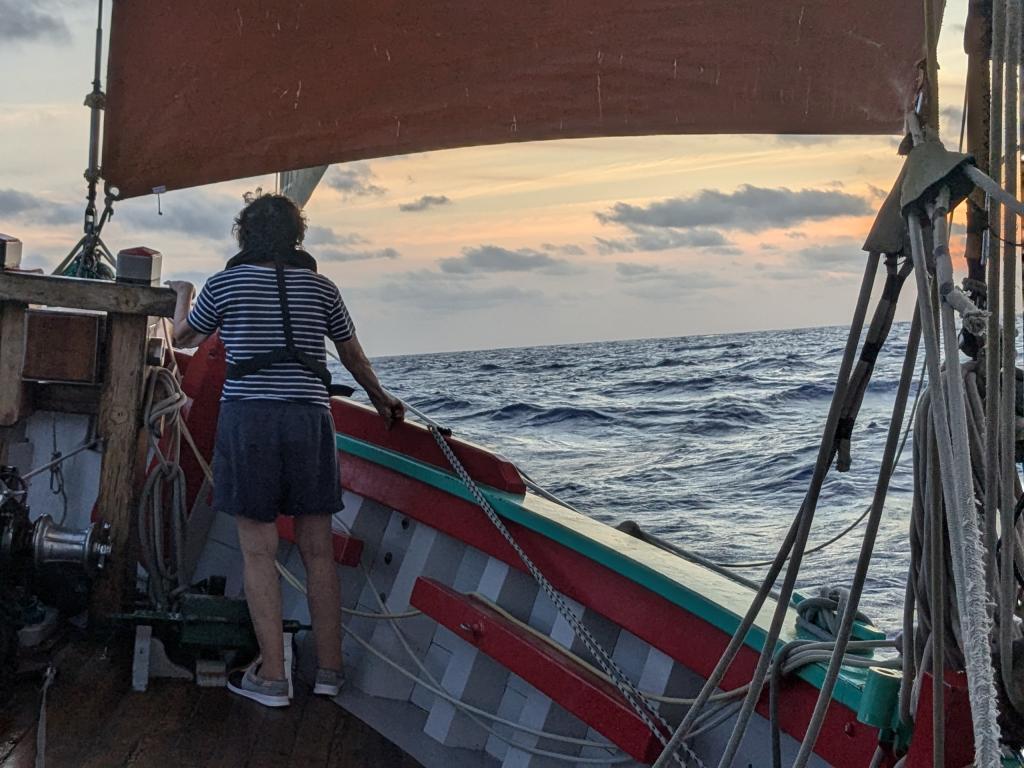
9 Jan
La Nébuleuse traces its last furrow of this Atlantic crossing in an azure blue ocean. A gentle zephyr pushes us behind. We should arrive tomorrow evening at the port of Salvador de Bahia in Brazil.
Setting the sails
Since Cape Verde, La Nébuleuse has been on the port tack, meaning that we are pushed by easterly winds varying between the northeast and the southeast. The mainsail has therefore always remained on the same side. It is just adjusted to be the most efficient. On the other hand, the other sails are often adjusted according to the weather. The main jib has been raised and lowered several times.
A consequence of this orientation of the sails is that there is no shade on the deck in the morning. I have gotten into the habit of staying inside in the morning and going up at the last minute to take my day watch at noon.
When the Nebula sails, it is steered by a man at the helm. As soon as the engine is started, the autopilot in heading mode takes over.
We did not see another sailboat during the entire crossing. I was hoping to see a Vendée Globe competitor. The proximity of our arrival leaves little chance of this encounter.
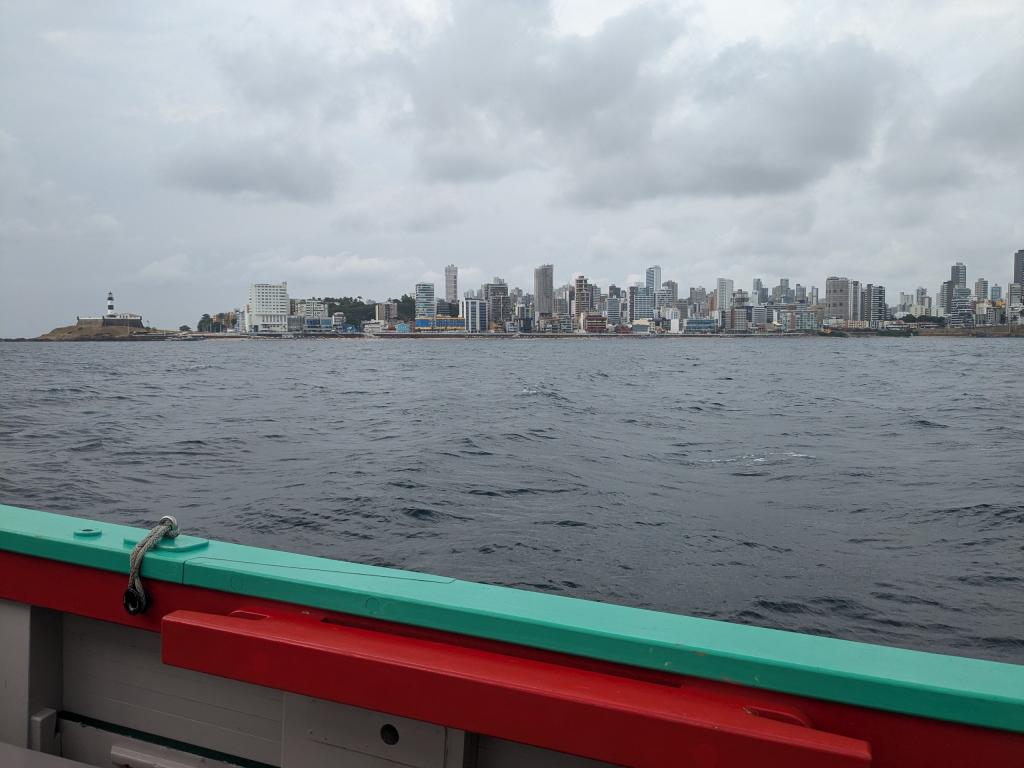
Arrival in Salvador de Bahia, Brazil on January 10, 2025 at 3 p.m.
The time has come to take stock of this long-dreamed-of crossing.
. We are happy to have crossed the Atlantic by sail,
. To have left Brittany to go to Brazil by sail on our journey to New Zealand.
. To have made the stops in Galicia, the Canary Islands and Cape Verde that we discovered.
. To have met marine animals. Dolphins, whales, orcas, sea birds...
. To have discovered how an old sailing tuna boat works, how to set the sails, how to hold the wheel.
. To have lived the life of a crew, with the sharing of tasks and maneuvers, difficult moments as well as moments of relaxation, and not to have been spectators or customers of a cruise.
. To celebrate the end of year celebrations, the crossing of the equator, birthdays... Champagne is great!
. To eat and drink on deck watching the sunsets, sometimes with the boat fishing.
. To have enjoyed a certain musical atmosphere with discoveries like Cesaria Evora.
. To have attended the video presentation of the work on La Nébuleuse and the voyage of the Pekin.
. To have been able to read the book 'Autour du monde' by Robert Le Serrec which tells the story of the cruise on another old tuna boat in 1960.
But the crossing was sometimes more demanding than we had imagined.
. The first 2 weeks, and especially the crossing of the Bay of Biscay, were bumpy and we suffered from seasickness several times...
. The night shifts from midnight to 3 a.m. were quite disruptive compared to our usual sleep rhythm.
. We would have liked to have used the engine less often with its procession of nuisances, noise, smells and pollution.
. Martine sometimes found the time a bit long just looking at the sea... It was indeed difficult for her to read for long, and we never played board games or other distractions at sea.
. The discomfort of the wooden benches became painful for our bottoms after sessions of several hours a day!
. The sun was sometimes burning, especially in the equatorial part of the crossing. Perhaps it would be possible to install a bimini to provide some shade.
. A bit of documentation on the points of interest would be interesting, such as a book on Atlantic birds, on sargassum, astronomical navigation...
. We regret not having been able to try the manipulation of the sextant, due to lack of equipment.
. The noise of the engine and the autopilot, annoying in our bunk, sometimes prevented us from sleeping.
. As well as the heat at night after crossing the equator. The purchase of fans in Salvador was very appreciable!
. The bunk was a little cluttered with clothes, a little storage would be possible if we added hooks to hang some of them.
In conclusion, to the question: if it had to be done knowingly, would you have gone? Without hesitation the answer is yes. This transatlantic crossing on La Nébuleuse was a great adventure!
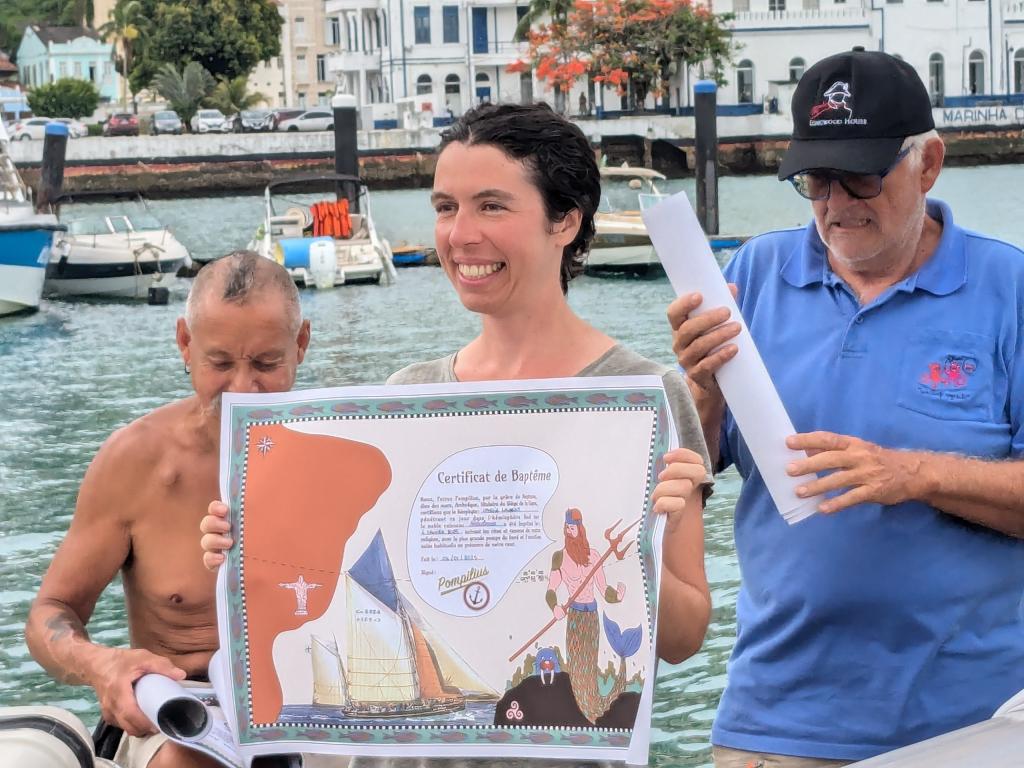
Le certificat de baptême du passage de la ligne de l'équateur a été remis le 13 janvier, avant de quitter La Nébuleuse

La Nébuleuse quitte le ponton du port de Salvador avec un équipage recomposé de 13 marins
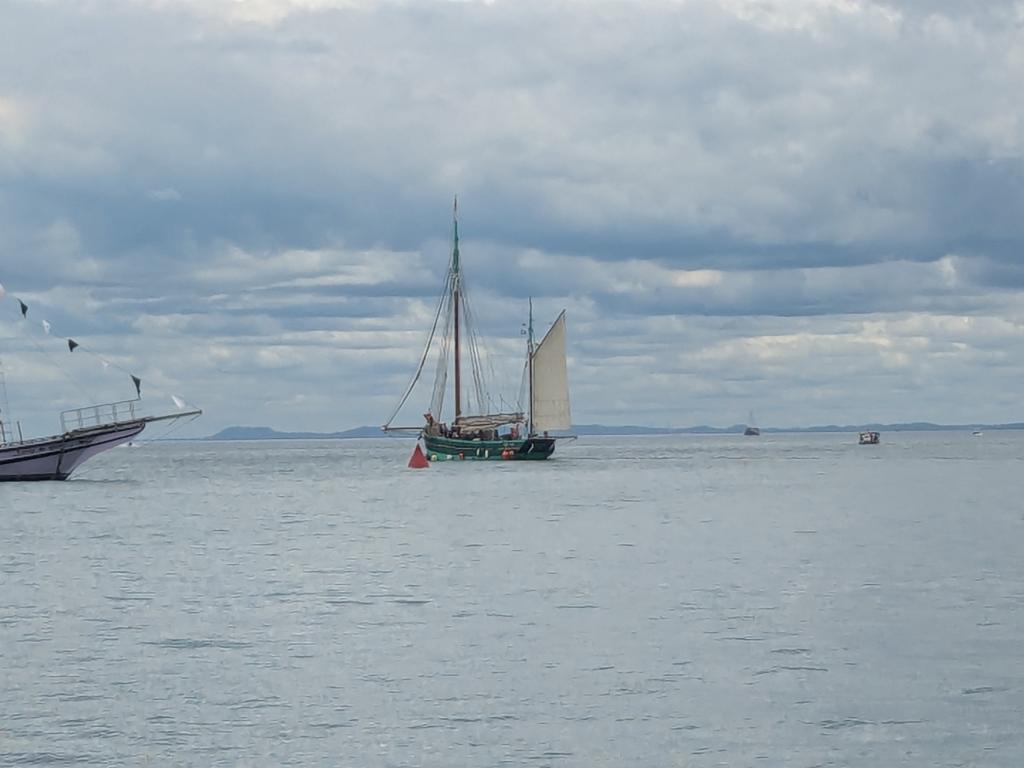
La Nébuleuse en route pour Recife
A voir l'article du 16 janvier sur Ouest-France https://www.ouest-france.fr/mer/recit-partis-de-bretagne-ces-paimpolais-debarquent-au-bresil-apres-une-transatlantique-en-voilier-e25073f6-d28a-11ef-b406-af013b65761f
Sur France Inter https://www.radiofrance.fr/franceinter/podcasts/chroniques-littorales
Le 19 mars, La Nébuleuse est dans le port de Horta aux Acores
Le 27 mars, La Nébuleuse arrive à Douarnanez
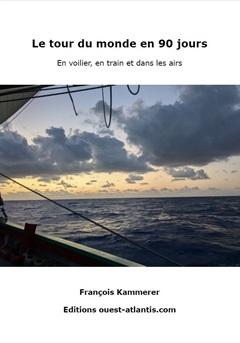
Le tour du monde en 90 jours, en voilier, en train et dans les airs
L'ensemble de notre voyage, à travers l'Atlantique, puis au Brésil, en Nouvelle-Zélande et au Canada, est raconté dans un livre "Le tour du monde en 90 jours, en voilier, en train et dans les airs", à paraître aux Editions ouest-atlantis en septembre 2025. Si ce titre est un clin d'oeil à l'ouvrage de Jules Verne, ces 90 jours se veulent en réalité un éloge de la lenteur. Nous vous entraînons dans ce parcours qui emprunte des chemins inhabituels et fait découvrir des aspects et des paysages méconnus.
Livre à paraitre aux Editions ouest-atlantis en septembre 2025
| Document : | |||
|---|---|---|---|
| 1. | carnet-chant-2024.pdf | ||